|
|
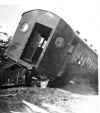
Head-on view of derailed
coach |

Interior view of derailed coach
|

Three coaches laying
on their sides |

Two coaches laying on their sides
with trainman walking at center of photo |

Two derailed coaches and torn-up
tracks |

Railroad workers walking past three
derailed coaches and torn-up tracks
|
|
|
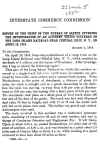 |
 |
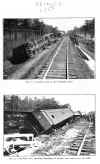 |
 |
 |
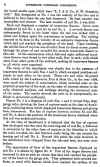
|
|
|
 |
 |
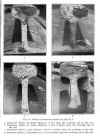 |
 |
 |
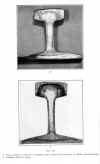
|
|
|
 |
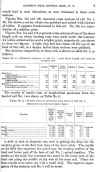 |
 |
 |
 |

|
|
|
 |
 |
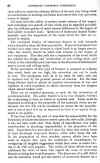 |
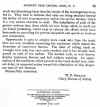 |
|
|
|
|
1921
Wreck of Cannonball west of Eastport
|

G54sa Camelback #16 west of Eastport
1921 |

|
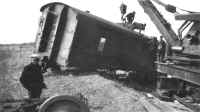
|
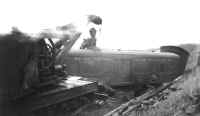 |
|
It is uncorroborated but supposedly the engineer
of the locomotive was Forrest Jayne. The story goes that he took
the curve west of “PT” a “bit” too fast and the engine rolled
over on her side derailing a number of head-end cars. The above
photos show the engine already righted and re-railed, although the
firebox door is gaping wide open, the tender is still derailed and
leaning and the wreck crane is working to clear up the mess of the
jack-knifed American Railway Express cars. James V.
Osborne photos, Dave Keller info and archive.
|
|
|
December 31,
1922 MT Tower,
Mineola Freight Wreck
|
|
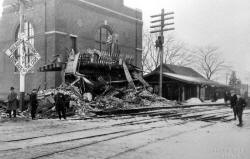 On
December 31, 1922 a freight train derailed in front of the 1890-era
brick "MT" tower at Mineola. The block operator was seated at the
chair visible in the upper left-hand corner of the structure. At that
time, there was a second floor back door and wooden connecting bridge
between the tower and the 2nd floor of the LIRR's electric sub-station
behind it. You can make out the doorway and part of the wooden
handrails just to the right of the operators chair. The operator ran
out the rear tower door and into the LIRR substation, probably saving
his life. When the freight car was pulled out of the structure, the
tower collapsed. This image was probably shot the next day after the
freight car was removed. Either a lineman or the block operator has
climbed the telegraph pole between the tower and the Mineola depot to
keep communications open. The current tower was built shortly
thereafter and placed in service on April 25, 1923, retaining, for the
time being, the call letters of "MT." (Joseph Burt photograph)
Archive: Art Huneke Info: Dave Keller On
December 31, 1922 a freight train derailed in front of the 1890-era
brick "MT" tower at Mineola. The block operator was seated at the
chair visible in the upper left-hand corner of the structure. At that
time, there was a second floor back door and wooden connecting bridge
between the tower and the 2nd floor of the LIRR's electric sub-station
behind it. You can make out the doorway and part of the wooden
handrails just to the right of the operators chair. The operator ran
out the rear tower door and into the LIRR substation, probably saving
his life. When the freight car was pulled out of the structure, the
tower collapsed. This image was probably shot the next day after the
freight car was removed. Either a lineman or the block operator has
climbed the telegraph pole between the tower and the Mineola depot to
keep communications open. The current tower was built shortly
thereafter and placed in service on April 25, 1923, retaining, for the
time being, the call letters of "MT." (Joseph Burt photograph)
Archive: Art Huneke Info: Dave Keller |
1924
Rockaway
Ave., Valley Stream Station |
|
 Valley
Stream Station accident - View SW 1924 Archive: James Supple Valley
Stream Station accident - View SW 1924 Archive: James Supple |
July 30, 1924 Sunnyside Yard, Long Island City |
|
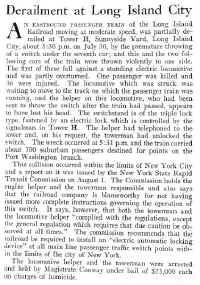
|

Eastbound passenger train
derailment at Tower H
Collection: Courtesy of Arthur Huneke
|
August
8 (Friday 13th),
1926 Golden’s Pickle Works in Calverton
|
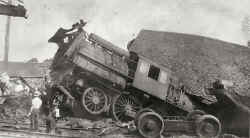
E51sa camelback #2, spun around 90+ degrees, facing SW, and buried into Golden's Pickle Works - 8/14/26 (C. T.
Jackson Collection, Dave Keller archive)
|
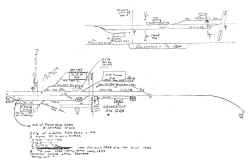
Emery map of location indicating Pickle Works Wreck of 8/13/1926
Calverton MP69-70 10/1957 Archive: Dave Keller
|
|
Gloom taunted the August night in 1926, even before the train crashed.
Torrential lightning and rainstorms had plagued New York since at
least the day before. The train was running 17 minutes late. And, if
the power of superstition be respected, it was Friday the 13th.
As the yuppies of the era headed to the East End for a summer weekend
escape from the city, the Long Island Rail Road had its most deadly
Suffolk County crash in history. The eastbound Shelter Island Express plowed
into a pickle factory in Calverton.
Six people were killed, including two young children and their mother,
in what soon became known as the Great Pickle Works Wreck.
 And one death was more horrific than the next.
Hamilton Fish, a
stockbroker and a member of an aristocratic New York family, was
thrown from the posh parlor car into Golden's Pickle Works and trapped
by twisted steel from the wreckage. Tons of salt from damaged barrels
on an upper floor poured down on him like sand through an hourglass,
smothering him as he yelled for help and struggled to push the salt
away from his mouth. And one death was more horrific than the next.
Hamilton Fish, a
stockbroker and a member of an aristocratic New York family, was
thrown from the posh parlor car into Golden's Pickle Works and trapped
by twisted steel from the wreckage. Tons of salt from damaged barrels
on an upper floor poured down on him like sand through an hourglass,
smothering him as he yelled for help and struggled to push the salt
away from his mouth.
Rescue workers couldn't cut away the steel quickly enough to get him
out. Others managed to help another man in a similar position by
cupping their hands above his mouth and catching the salt, which was
used in the pickle brine, and tossing it aside as rescuers struggled
to free him.
|
LIRR engineer William Squires,
and fireman John Montgomery were in the lead engine,
D16sb (4-4-0) #214 and both were pinned against the boiler in the
locomotive’s cab, crushed by tons of
coal that tumbled out of the coal tender as the engine fell to its
side off the tracks, facing north. The steam pipes burst, hitting them with blasts
of 600-degree superheated steam.

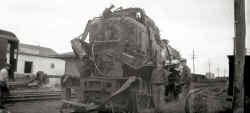
LIRR D16sb #214 front/rear
Calverton, NY 08/13/1926 Archive: Dave Keller
|


LIRR Camelback E51sa #2 (burning off bell), close-up MOW
acetylene/O2 bottles 08/13/1926 Archive: Dave Keller
|
|
The wreck happened at 6:08 p.m. Engine No. 214 was leading the
two-engine Shelter Island Express to Greenport with more than 350
passengers. The express traveled only on Fridays, taking people to
weekend holidays. Accounts say it was traveling from 40 to 70 mph when
it jumped a switch leading to the pickle works. The first engine fell
to its side, while the second flew toward the factory with the train
behind it, news reports said.
LIRR engineer Charles T. Jackson’s claim to
fame was being the surviving engineer of E51sa camelback #2, the
second locomotive of that infamous, eastbound, double-headed
“Shelter Island Express” that split a switch on Friday, August 13,
1926 (yes, Friday the 13th for the superstitious) and plowed into
Golden’s Pickle Works, located trackside in Calverton. The fact that
he and his fireman,
Jim
my Fitzgerald, survived the crash was a miracle
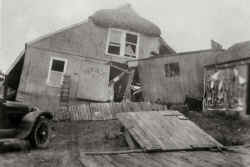 Golden’s
Pickle Works with giant pickle sign, trackside in
Calverton, NY destroyed after being hit by derailed “Shelter
Island Express” on 8/13/26 (Thomas R. Bayles photo, Dave Keller archive) Golden’s
Pickle Works with giant pickle sign, trackside in
Calverton, NY destroyed after being hit by derailed “Shelter
Island Express” on 8/13/26 (Thomas R. Bayles photo, Dave Keller archive)
|
|
The engine crew of the lead locomotive, D16sb #214 died horribly as
they were pinned against the scalding hot firewall. Charlie and his
fireman Jim
my Fitzgerald were thrown clear, but injured. Charlie was
flung from the cab through the cab's skylight which, luckily, was open
to get some air and ventilation on that hot, humid, Long Island day in
August, 1926. Research: Dave Keller
 Golden Pickle Works
Wreck: Passenger Car in building 08/13/1926
Archive: Dave Keller Golden Pickle Works
Wreck: Passenger Car in building 08/13/1926
Archive: Dave Keller
|
|
The Pullman parlor car, which was called Easter Lily, was directly
behind the second engine, and every passenger who died in the wreck
had been seated in that luxury car, with its chairs that swiveled and
a waiter who served drinks. There was a smoker car and five day
coaches on the train as well.
 This is the only picture I have ever seen of showing the 214 just as This is the only picture I have ever seen of showing the 214 just as
she came to rest after the wreck. Every shot I have seen, published
or not, has shown her re-railed and waiting to be
towed back to Jamaica. Just beyond her pilot truck can be seen Engine
No. 2 laying on her left side. Just beyond is Pullman parlor car
"Easter Lily" projecting into the Golden Pickle Works building.
|
|
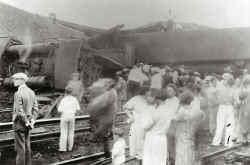 Here's 2nd engine No. 2 rolled over on her left side. "Easter Lily" is Here's 2nd engine No. 2 rolled over on her left side. "Easter Lily" is
just beyond her.
|
|
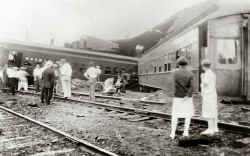 This shows the combine which was just behind "Easter Lily" and the This shows the combine which was just behind "Easter Lily" and the
coach which followed the combine.
|
|
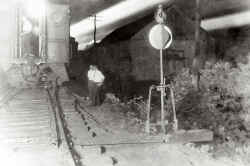 This is the rear car of the train which stayed on the track. In the This is the rear car of the train which stayed on the track. In the
foreground is the defective switch which caused the wreck.
|
 Pickle
Works wreck 8/13/1926 Archive: Bill Mangahas Pickle
Works wreck 8/13/1926 Archive: Bill Mangahas
This
shows 3 cars buried into the building. I believe the car at the left was the parlor car "Easter Lily" which was the lead car on the train, although I can't read any name on the car from the angle of the photos. The
photo below shows the same car at the left still buried in the building, but the other two have been removed with the combine car just visible at the far right having been re-set on the tracks,
thus this photo occurred prior.
The wreck occurred the evening of August 13, 1926 (Friday the 13th). The wreck crew and rescue vehicles would have been dispatched ASAP and probably worked during the night. The lead engine crew were killed. The second locomotive's engineer was thrown from the cab and badly injured but survived. His fireman got clear or was thrown clear of the wreck and was himself injured and survived (and quit the LIRR after he recovered).
The ridership was light and several passengers were killed. Others were injured.
The photo would have been taken the next day after word spread via the "bush telegraph," allowing all the gawkers to show up. Those onlookers wouldn't have been allowed to be there as the dead and injured were being removed from the wreckage on August 13th. The
photo lighting shows bright sunlight with short shadows and therefore not taken on August 13th but probably the following day (August 14th). The
photo below has no bright sun, so chances are it may have been taken either in the evening of that 2nd day (August 14th) or possibly sometime on the 3rd day (August 15th) which may have been overcast. Notice the crowd is gone. The excitement is over. Everyone's gone home for dinner and to talk about what they saw.
|
|
The others killed were Mrs. George A. Shuford of Biltmore, N.C., and
her two children, George A. Jr., 3, and Dorothy, 1. The two children
were crushed in the parlor car wreckage. Their mother was pinned
beneath the car for more than six hours, but was awake.
"Patiently and without a whimper Mrs. Shuford lay in the rain until
the workmen had cut her free,'' reported The Brooklyn Daily Eagle.
Workers cut through the steel around her with torches. Before she was
extricated, she ate a sandwich and had coffee, The Eagle reported. But
six hours after she reached Southampton Hospital, she was dead of
internal burns suffered from inhaling steam. She had been assured her
children were fine, The New York Times said, and still thought they
were at the time of her death.
Shuford, an only child, had been with her parents in the parlor car.
She had been visiting them for a couple of weeks. Her father, Charles
A. Angell, was the head of a Brooklyn contracting firm and a
well-known resident of Shelter Island. With Shuford as well was her
maid, who also was pinned in the wreckage and had to have her left leg
amputated to get her out.
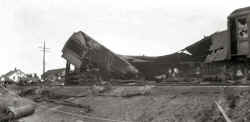 The
aftermath of the wreck show the pickle works caved into
itself, with the almost comical giant sign shaped like a big, green
pickle, still hanging above the attic windows. ``Golden's'' it said
on the pickle. The
aftermath of the wreck show the pickle works caved into
itself, with the almost comical giant sign shaped like a big, green
pickle, still hanging above the attic windows. ``Golden's'' it said
on the pickle.
|
 Golden Pickle Works LIRR
Crane, #214 MOW Car, Camelback E51sa #2 tender Calverton, NY 08/13/1926
Archive: Dave Keller Golden Pickle Works LIRR
Crane, #214 MOW Car, Camelback E51sa #2 tender Calverton, NY 08/13/1926
Archive: Dave Keller
|
There were various explanations for the wreck, from tampering with the
track switch to its mechanical failure, said Vincent F. Seyfried, a
Long Island Rail Road historian. ``Probably no one could really pin it
down,'' he said. ``It's tough to reconstruct exactly what happened.''
The most popular theory is that the disaster was caused by a missing
cotter pin on the switch. A switch facilitates the movement of the
train from one track to another. A nut and bolt fasten the control rod
to the switch. The cotter pin keeps the nut from unscrewing and
falling off.
In this case, investigators said that the cotter pin had not been
replaced, perhaps during maintenance. Investigators surmised that when
the first engine passed by the split where the main track divided from
a side track leading to the pickle factory, the vibration of the
passing locomotive caused the nut to work loose. The second engine
then jumped off the main track toward the factory.
About 300 rescuers worked by floodlights and flashlights and flashes
of lightning to help the injured and to try to save the dying. The mud
from the storms made their work slow and painstaking, newspapers
reported.
The pickle factory was demolished and never reopened. The train
locomotives, both more than 20 years old, were hauled to the scrap
yard.
There's no sign now that the wreck ever took place. And life goes on.
|
May 21,
1927 Woodhaven Passenger/Freight Collision
|
|
 Collision of MP41 MU passenger cars and H6sb steam locomotive switching freight at Woodhaven in April, 1925. Lalance Grosjean
Agateware Plant in the background. (Dave Keller archive) Collision of MP41 MU passenger cars and H6sb steam locomotive switching freight at Woodhaven in April, 1925. Lalance Grosjean
Agateware Plant in the background. (Dave Keller archive)
|
|
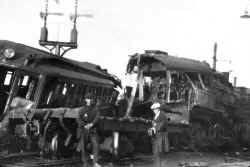 Another view of the
May 21, 1927 Woodhaven wreck with the tender missing. (Dave Keller archive) Another view of the
May 21, 1927 Woodhaven wreck with the tender missing. (Dave Keller archive)
|
March
28, 1928
LI City DD1 Collision at 48th Street, Woodside |
|
 DD1 electric locomotives
#347 and #345 and Train #31 (SPK-NYK) in wreck at entrance to the East River tunnels in L. I. City on March 28, 1928
- View W (eBay scan) DD1 electric locomotives
#347 and #345 and Train #31 (SPK-NYK) in wreck at entrance to the East River tunnels in L. I. City on March 28, 1928
- View W (eBay scan)
|
July
1, 1928
MU at Beach Channel Swing Bridge Plunges into Channel
|
|
 MPB54
1374 (?) (ACF, 8/1913) decided to take a drink on Saturday, 7/21/1928
at Beach Channel swing bridge (HJ Interlocking). View N. Train 1318,
operating a "Loop" service from Flatbush Avenue to Far
Rockaway & Valley Stream via the Bay did not stop at home signal 1
& 2 and the first car plunged into the channel. No one was killed
in this accident but 16 men were injured. Apparently, there were no
women in the first car because it was a smoking car. The motorman
claimed he had left Flatbush Avenue feeling sick to his stomach, saw
the stop-signal and open bridge but simply didn't stop. He was
arrested afterwards while still in the hospital. Fortunately, the
water was at or very near low tide at that moment and was only about
30' deep. This occurred at 8:21 am at the height of the rush hour.
This is 1928 so the work week was still six days. Apparently, the
railroad was tied up in knots for a few hours after this. The
newspaper account stated that even Montauk trains were affected and
that all Rockaway service was operated via Valley Stream until the
wreck got cleared that afternoon. Archive: Emery-SUNY Stony
Brook Research: Jeff Erlitz MPB54
1374 (?) (ACF, 8/1913) decided to take a drink on Saturday, 7/21/1928
at Beach Channel swing bridge (HJ Interlocking). View N. Train 1318,
operating a "Loop" service from Flatbush Avenue to Far
Rockaway & Valley Stream via the Bay did not stop at home signal 1
& 2 and the first car plunged into the channel. No one was killed
in this accident but 16 men were injured. Apparently, there were no
women in the first car because it was a smoking car. The motorman
claimed he had left Flatbush Avenue feeling sick to his stomach, saw
the stop-signal and open bridge but simply didn't stop. He was
arrested afterwards while still in the hospital. Fortunately, the
water was at or very near low tide at that moment and was only about
30' deep. This occurred at 8:21 am at the height of the rush hour.
This is 1928 so the work week was still six days. Apparently, the
railroad was tied up in knots for a few hours after this. The
newspaper account stated that even Montauk trains were affected and
that all Rockaway service was operated via Valley Stream until the
wreck got cleared that afternoon. Archive: Emery-SUNY Stony
Brook Research: Jeff Erlitz
|
November 15, 1928
Greenport Freight hits farm truck - Peconic Station
Westbound Greenport Freight hits farm truck killing four Volinski
Brothers. R. Emery data |
October
25, 1932
Wreck of the Cannonball East of Amagansett
|
|
Train #20, the “Cannonball”
was making its regular trip eastbound to Montauk late in the season on
October, 25, 1932. Pulled by G5s (4-6-0) #50, the name train had
dropped its last passenger off at Amagansett and the train crew all
settled into the last car of the train for a quiet, dead-head ride to
the end of the line at Montauk. Conductor Leo Hantz had his young son
with him on the run and everyone was enjoying the ride, awaiting the
end of the trip.
While rounding the curve
near M.P. 114, just west of Montauk, the big G5s rolled over onto her
side, burying engineer Frank Obremski in the right bank of the
hillside. Fireman Ed Koehler was thrown clear and climbed up the
bank where we was found and rushed to
Southampton
hospital where he died of his injuries. None of the train crew
nor Leo’s son all riding in the last car were injured.
 The
first photo is of G5s #50, minus one of her domes, rolled over onto
her side. The second photo is of the passenger cars
jackknifed. It’s amazing that, miles from everywhere, on what
is still a pretty deserted stretch of track, the quantity of gawkers
that turned out to witness the disaster! The
first photo is of G5s #50, minus one of her domes, rolled over onto
her side. The second photo is of the passenger cars
jackknifed. It’s amazing that, miles from everywhere, on what
is still a pretty deserted stretch of track, the quantity of gawkers
that turned out to witness the disaster!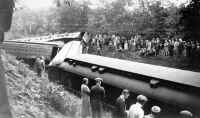
 The
form 19 train order shown here was issued at PD tower on that very day
and copied and made complete at 5:09 pm by block operator
Bruckner. It identifies train #20, the “Cannonball” as being
pulled by engine #50. The
form 19 train order shown here was issued at PD tower on that very day
and copied and made complete at 5:09 pm by block operator
Bruckner. It identifies train #20, the “Cannonball” as being
pulled by engine #50.
Photos, text, and
train order are from the archive of: Dave Keller
|
September
6, 1934
Wreck at
Riverhead
NY TIMES: "RIVERHEAD, L.I.,
Sept. 6: "The steam locomotive, coal tender and three
passenger coaches of a Long Island Railroad train were overturned
tonight when the train split an open switch as it was pulling into the
Riverhead station here. Three persons were hurt, none seriously."
|

Riverhead Tank Car Crash -
Patchogue Advance 9/07/1934
|
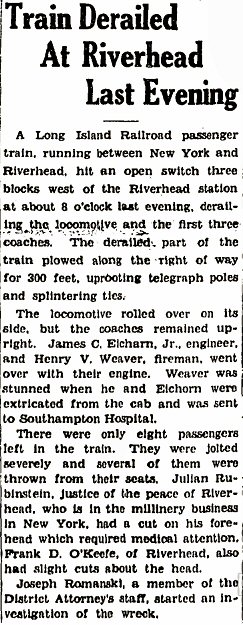
Riverhead - Passenger Train Derailment
Suffolk County News 9/07/1934 |
|

|
There's excitement in Riverhead, NY the morning of September 7, 1934 as local spectators flock the area to view leased PRR E3sd #917 on its side and to witness the clean-up process after the derailment and wreck of the night before, west of Marcy Ave. This view is north towards Pulaski St. and provides a good shot of both the locomotive and the front pony wheel truck, torn from the engine. (Dave Keller archive)
|
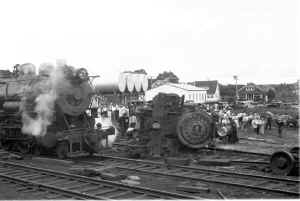
|
Another view at a slightly different angle, showing LIRR G53sd #145 at the left which has just arrived with the wreck cranes and work train. (Dave Keller Archive) |

|
The two wreck cranes are in the process of righting PRR E3sd #917. Again, this view is north towards Pulaski St. (Dave Keller Archive)
|
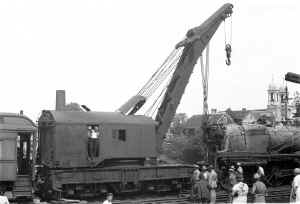
|
The wreck cranes have righted PRR E3sd #917 but in the process the cab was lost. The view is NE towards St. Isidore's R.C. Church (note the landmark twin steeples in the right background). (Dave Keller archive)
|

|
The two wreck cranes are now in the process of re-railing the tender. The trucks have been set on the rails and the Pennsylvania Railroad tender is visible at the right behind the closest wreck crane. You can make out the stenciled "Pennsylvania" on the tender's side. Note the old, wooden combine car in use as a MOW (Maintenance-of-Way) crew car! The last of the wooden passenger cars still in revenue service were removed in 1927 and either sold to other railroads or put into LIRR MOW service. (Dave Keller Archive)
|
December
4, 1934 Vanderveer Park, Brooklyn - Bay Ridge Branch between LIRR Steam and New
Haven (NYNH&H) Electric Engine |

|
 H6sb
#312 after collision with NH Electric locomotives at Brooklyn Ave.
overpass. 12/04/1934 (Harrison-Keller) H6sb
#312 after collision with NH Electric locomotives at Brooklyn Ave.
overpass. 12/04/1934 (Harrison-Keller) |
|
The late, retired
LIRR engineer Richie Harrison always loved trains and was given a
camera as a young boy. On December 4, 1934, he heard of a wreck that
had just occurred on the LIRR's Bay Ridge branch near Brooklyn Avenue
(the bridge in the background) in the old community of what was once
known as Vanderveer Park, between a LIRR H6sb
(2-8-0) freight engine and New Haven
Railroad electric engines, which pulled freight along the branch in
conjunction with the LIRR. I don't know if there were any injuries.
Young Richie grabbed his new camera and got himself down to the
location of the wreck only to find the New Haven electric locomotives,
the tender of the H6sb steam locomotive, and other work equipment
involved had since been removed. LIRR locomotive #312 was still in
place, coupled onto a short freight train, probably to be towed to the
shops for repair, so Richie photographed it front and back, providing
us a good view the crushed steel cab. After taking two photos, a cop
came up to him and chased him off the site, saying he was supposed to
be in school so why wasn't he. . . Richie was lucky that the cop
didn't confiscate his camera, and it was most fortunate for us that he
took his photos, as these are the only two images I've ever seen of
that wreck. (Richard J. Harrison photos, Dave Keller archive and data) |
January
22, 1935
Merrick Avenue, Merrick |
|
 Train
vs. automobile at Merrick Avenue near Nagel Court on January 22nd,
1935. It is unknown if the driver and other possible passengers
were injured during this unfortunate event. Many curious onlookers can
be seen in the windows of the train. Train
vs. automobile at Merrick Avenue near Nagel Court on January 22nd,
1935. It is unknown if the driver and other possible passengers
were injured during this unfortunate event. Many curious onlookers can
be seen in the windows of the train.
Photo: The Long Island Press Archive: Chris Klug |
November 17, 1935 Wreck near Aquebogue train station |
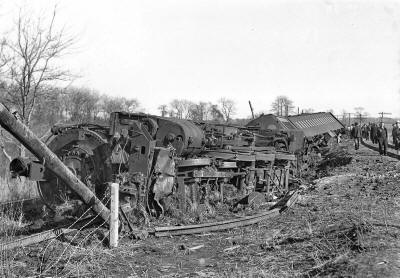
Photograph taken of the aftermath of a
train accident east of Aquebogue train station on November 17, 1935.
The locomotive involved was LIRR #44. Photo: Rugen, William J. -
Collection; Queens Public Library Digital Archive |
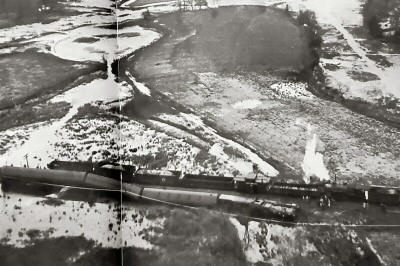
Washout at Aquebogue Photo: NY Daily News
p.168 "Steel Rails to the Sunrise" Ron Ziel |

Washout at Aquebogue p.168
"Steel Rails to the Sunrise" Ron Ziel |
|
 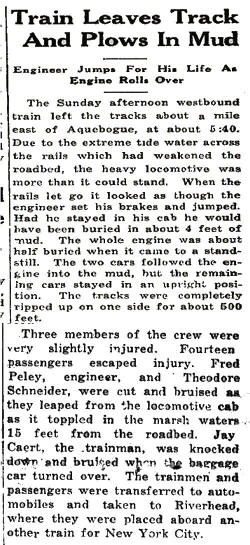 Long
Island newspaper article - November 18, 1935 Long
Island newspaper article - November 18, 1935
Train Leaves Track And Plows In Mud
The Sunday afternoon westbound train left the tracks about a mile
east of Aquebogue at about 5:40pm. Due to
the extreme tide water across the rails, which had weakened the
roadbed, the heavy locomotive was
more then it could stand.

Emery Map Aquebogue MP77-78 wreck-11/17/1935 Archive: Dave
Keller
Turns out, a bad storm that came through
Saturday, the 16th into Sunday, the 17th brought some strong winds and
quite a bit of rainfall. So much, that it flooded the area under the
tracks, causing them to buckle when the locomotive happened upon the
area. Locomotive number 44 carried five cars- four passenger and one
baggage. Bumps and bruises for the passengers, but worse was the seven
hour wait for another train to get the lucky survivors over to
Riverhead depot. When the locomotive started to lean when it hit the
faulty rail, the engineer and a fireman that was on board with him
leaped out of the engine into the flooded area. The two suffered cuts
and bruises and received treatment at a local farmhouse. Chris Klug
New York Times Train Wrecked
at Aquebogue November 17, 1935
|
September
21, 1938
Wreck at
Quogue |
"The
Hurricane of September 21, 1938 and the Long Island Rail Road
Wreck at Fairy Dell** in Quogue, LI, NY" by Raymond
Robinson, Jr.
Train
#26, the evening mail train, left Pennsylvania Station NY at 4:7 pm,
bound for Montauk. It should have arrived at Speonk at 7:00 pm,
but because some tress were down, it was a few minutes late.
The Conductor
of this train was my father, Raymond G. Robinson. He and the
rest of the crew had rooms in Montauk, so they could take train #27
out in the morning.
On that day,
the wind had been blowing out of the northeast. It blew most of
the water out of the bays and out to sea. The eye of the storm
passed over us and soon after, the wind change and came out of the
southwest, causing the tidal-wave that washed out the roadbed from
under the track. The newspaper article stated that the wind had
blown the train off the tracks, which, of course, was not true.
When
the tidal-wave came rushing back, it washed out the fill and roadbed
where the head waters of Quantuck Bay flowed under the tracks.
It left the rails and ties intact. When train #26 came along,
the engine and tender, a PRR K4s, made it across OK, but the mail car
and two coaches left the rails.
My
father was in the first coach, eating his lunch. When the car
laid over, his arm went through the window. No one was seriously
injured, so he moved all the passengers to the rear coach which was
still upright.
In
order to report the wreck, he had to walk back to the Westhampton
station. While there, he discovered his arm was cut, so someone
took him to Dr. Keller (a local medical doctor) and they sewed up the
wound under the light of a kerosene lamp.
It
took several days to clear up the wreck and rebuild the roadbed.
I was told that they never found one of the trucks from the mail car,
which was buried in the marsh. Info: Ray Robinson, Jr.
(**
Fairy Dell is approximately 600 feet west of the Old Country Road
grade crossing, by the present-day Quogue Wildlife Refuge.)
|
November 12, 1941 Train
Hits Truck - Mineola |
 Old
Country Road, Mineola: A light truck carrying seven construction
workers on their way home from work drove onto Mineola’s Old
Country/Herricks Road crossing in the gathering darkness, directly
into the path of a New York-bound steam express. The truck blew apart
with the force of the impact. Six of its occupants were killed
instantly; the seventh was carried moaning to Meadowbrook Hospital,
where he died the next morning. A crowd of 2,000 milled about, gawking
at the uncovered bodies. The watchman stationed at that crossing, who
had been working an involuntary overtime shift, was charged with
second-degree manslaughter for failing to lower the gates. He said, “I
wish I could commit suicide.” Old
Country Road, Mineola: A light truck carrying seven construction
workers on their way home from work drove onto Mineola’s Old
Country/Herricks Road crossing in the gathering darkness, directly
into the path of a New York-bound steam express. The truck blew apart
with the force of the impact. Six of its occupants were killed
instantly; the seventh was carried moaning to Meadowbrook Hospital,
where he died the next morning. A crowd of 2,000 milled about, gawking
at the uncovered bodies. The watchman stationed at that crossing, who
had been working an involuntary overtime shift, was charged with
second-degree manslaughter for failing to lower the gates. He said, “I
wish I could commit suicide.” |
March 3, 1942 Train vs.
Car -
Peconic Station |
_small.jpg) This
westward view shows the aftermath of Train vs. Car at Peconic Station
on March 3, 1942. Fortunately, the woman driving the car was not
injured. At this time, the agency is no longer in service as is
evident by the boarded-up depot windows. This
westward view shows the aftermath of Train vs. Car at Peconic Station
on March 3, 1942. Fortunately, the woman driving the car was not
injured. At this time, the agency is no longer in service as is
evident by the boarded-up depot windows.
Archive: Dave Keller |
March 17, 1943
Passenger Derailment - Sayville |
 Five
coaches from eastbound Passenger Train #8 derailed 150' east of Cherry
Ave., Sayville. Twenty-seven injured, three seriously, with no
fatalities. Wednesday morning, 10:50am. 3/17/1943 as reported by the
Suffolk County News. Five
coaches from eastbound Passenger Train #8 derailed 150' east of Cherry
Ave., Sayville. Twenty-seven injured, three seriously, with no
fatalities. Wednesday morning, 10:50am. 3/17/1943 as reported by the
Suffolk County News.
Photo: Louis Kreye |
September 14, 1944 East
of Syosset
|
|
The
wreck was technically at Syosset as the derailment occurred east of
the Syosset station, but west of “S” cabin (AMOTT), on the double track
portion of the ROW and near an under-track drain culvert. North of the
tracks were the sand pits that were excavated for the 1912-13 grade
elimination project at
Jamaica
.
There
was a heavy rainstorm and, due to the proximity of this excavation to
the tracks, a washout occurred. Westbound
train #647, pulled by PRR K4s #5406 derailed on September 14, 1944 as
a result of this washout. Dave Keller Historical Information
Photos: Don Boslet, Syosset postmaster Archive: Richard Glueck


 |
August
3, 1946 Head-on
Passenger/Freight Collision west of Port Washington
|
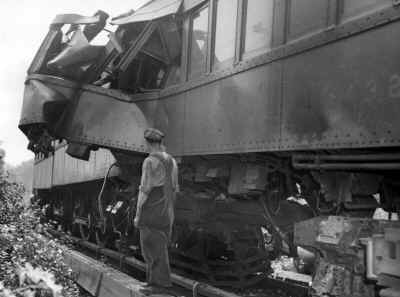 On Aug. 3, 1946, an LIRR passenger train collided head-on with a freight train in the yard area just west of the Port Washington station, killing two crewmen and injuring 27 passengers. The accident occurred shortly after the westbound passenger train left the station bound for Great Neck. Here, an LIRR employee views the east side of the wreck showing part of the passenger train.
Photo Credit: Newsday / Herbert McCory On Aug. 3, 1946, an LIRR passenger train collided head-on with a freight train in the yard area just west of the Port Washington station, killing two crewmen and injuring 27 passengers. The accident occurred shortly after the westbound passenger train left the station bound for Great Neck. Here, an LIRR employee views the east side of the wreck showing part of the passenger train.
Photo Credit: Newsday / Herbert McCory |
December 28, 1946 at
Medford Ave, Medford
|
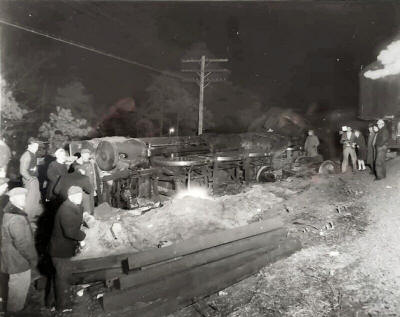 A truck with a bulldozer mounted on the
trailer was too high for the clearance limitation of the Medford Ave.
underpass on the night of December 28, 1946. The incident had knocked
the bridge nearly two feet out of alignment. When K4s No. 3731 roared
over the bridge sometime later, she was derailed, along with her
tender and an express car. A truck with a bulldozer mounted on the
trailer was too high for the clearance limitation of the Medford Ave.
underpass on the night of December 28, 1946. The incident had knocked
the bridge nearly two feet out of alignment. When K4s No. 3731 roared
over the bridge sometime later, she was derailed, along with her
tender and an express car.
Photo: Fred J. Weber Archive: Ron Ziel |
February 16, 1947
Wreck
at Kings
Park
All photos and info: Dave Keller
unless otherwise noted
|
|
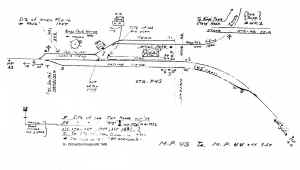 It
was approaching noon on Sunday, February 16, 1947 and train #4612 was
being pulled eastbound towards Port Jefferson by leased Pennsylvania
Railroad K4s (4-6-2) #5406. The train was due to make a station
stop at
Kings
Park at 12:08 pm then continue on to its final destination of Port
Jefferson. It
was approaching noon on Sunday, February 16, 1947 and train #4612 was
being pulled eastbound towards Port Jefferson by leased Pennsylvania
Railroad K4s (4-6-2) #5406. The train was due to make a station
stop at
Kings
Park at 12:08 pm then continue on to its final destination of Port
Jefferson.
The
huge locomotive and train was almost at
Harrison Avenue
, the first crossing west of the station when it derailed, dragging
the train across
Harrison Avenue
and onto the
State
Hospital
spur access siding and rolled off the tracks onto the north side of
the main, burrowing itself into the ground in front of the village’s
tall community water tower, sending rails and ties and wheels
everywhere, jack-knifing passenger cars in the process.
Emery map of Kings Park MP43-44 9/1957
The
New York Daily News account at the time stated the train ran a stop
signal, hit an open switch and derailed at 12:07 pm. Engineer Walter
A. Samb, 51, of Miller Place admitted to investigators that he saw the
signal several hundred feet before the switch but couldn’t brake in
time. He said he got a clear order at Greenlawn eleven minutes
earlier.
The
crew of the preceding
Kings
Park
State
Hospital
train, #4608, which was scheduled to arrive at Kings
Park
at 11:12, having taken the siding just west of
Harrison Avenue
and then making its final stop at the state hospital north of Route
25A at 11:22 am, was being questioned to determine responsibility for
the open switch.
The
eleven-car train hit the switch at 40 miles-per-hour and derailed.
The momentum carried the locomotive and train 250 feet, coming to a
stop in front of the trackside water tower for the community of
Kings
Park. Six coaches were derailed, and the newspaper reported in the
same article that 31, 48 or 50 were injured, 10 seriously, so I have
no idea of the actual count. The fortunate thing, though, was
that there were no deaths.
The
other crew members identified in the report were Conductor John H.
Hastings, 46, of Port Jefferson and Fireman Alfred A. King of Easthampton.
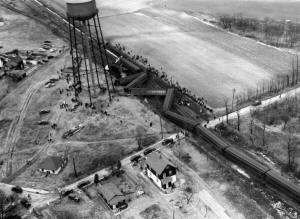 This
is an aerial view shortly after the wreck and was taken by a Daily
News photographer. The wreck train has not yet arrived on the
scene. The view is looking from the south side of the tracks,
northwest and pretty much sums up the entire situation facing the
wreck crew. One upright car on the south siding (how did that
get there?), locomotive and other cars on the
Kings
Park
Hospital
spur siding north of the main and jack-knifed cars across all
three tracks, with
Harrison Avenue
crossing in the background. (Win Boerckel- Dave Morrison) This
is an aerial view shortly after the wreck and was taken by a Daily
News photographer. The wreck train has not yet arrived on the
scene. The view is looking from the south side of the tracks,
northwest and pretty much sums up the entire situation facing the
wreck crew. One upright car on the south siding (how did that
get there?), locomotive and other cars on the
Kings
Park
Hospital
spur siding north of the main and jack-knifed cars across all
three tracks, with
Harrison Avenue
crossing in the background. (Win Boerckel- Dave Morrison)
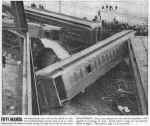 An elevated view from the Kings Park village water tower, also taken by a Daily News photographer. It is looking from the north side of the tracks southeast. An elevated view from the Kings Park village water tower, also taken by a Daily News photographer. It is looking from the north side of the tracks southeast.
 Photo by John De Biase for the N. Y. Daily News, Dave Keller archive
Photo by John De Biase for the N. Y. Daily News, Dave Keller archive
 Photo by John De Biase for the N. Y. Daily News, Dave Keller archive
Photo by John De Biase for the N. Y. Daily News, Dave Keller archive
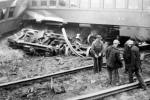 Photo: Peter LaLena Archive: Phillip
LaLena
Photo: Peter LaLena Archive: Phillip
LaLena
 Photo by John De Biase for the N. Y. Daily News, Dave Keller archive
Photo by John De Biase for the N. Y. Daily News, Dave Keller archive
 Photo by John De Biase for the N. Y. Daily News, Dave Keller archive
Photo by John De Biase for the N. Y. Daily News, Dave Keller archive
 Photo by John De Biase for the N. Y. Daily News, Dave Keller archive
Photo by John De Biase for the N. Y. Daily News, Dave Keller archive
 The
water tower pump house view looking SW from the north side of the
tracks. Archive: Kings Park Heritage Museum The
water tower pump house view looking SW from the north side of the
tracks. Archive: Kings Park Heritage Museum
 The
wreck crane is being put into position by a G5s drafted for emergency
wreck service. The view is from the south side of the tracks
looking west and two derailed cars are about to get the attention of
the two work cranes: this one in the photo and the one behind
the photographer as is evidenced in the next photo. Both coaches
are off their trucks and, in the right foreground behind the men can
be seen one of the heavy-duty trucks off the Kiesel tender. The
wreck crane is being put into position by a G5s drafted for emergency
wreck service. The view is from the south side of the tracks
looking west and two derailed cars are about to get the attention of
the two work cranes: this one in the photo and the one behind
the photographer as is evidenced in the next photo. Both coaches
are off their trucks and, in the right foreground behind the men can
be seen one of the heavy-duty trucks off the Kiesel tender.
 View
from the south side of the tracks looking east, and shows both wreck
cranes connected to the wrecked coach which is in mid-air, about to be
swung back onto the re-railed trucks for transport back to Morris Park
Shops. View
from the south side of the tracks looking east, and shows both wreck
cranes connected to the wrecked coach which is in mid-air, about to be
swung back onto the re-railed trucks for transport back to Morris Park
Shops.
 LIRR
#5406 and the two cars looking
from the south side of the tracks westward, towards the scene of the
derailment. The two passenger cars have been set back on their
trucks and are awaiting a trip to Morris Park Shops. The tender
is missing, and the locomotive is yet to be righted. Much of the
mess has been cleared up and the coaches that didn’t derail had been
removed previously from the site to allow for the clean up.
Judging by the previous aerial view, the tender is probably still
sitting at a skew behind the cab of the locomotive and is not visible
from this angle. At the left you can see bonfires started in the
frozen nearby field to keep the chill away from the wreck
workers. Now it’s time to begin work on the K4s! LIRR
#5406 and the two cars looking
from the south side of the tracks westward, towards the scene of the
derailment. The two passenger cars have been set back on their
trucks and are awaiting a trip to Morris Park Shops. The tender
is missing, and the locomotive is yet to be righted. Much of the
mess has been cleared up and the coaches that didn’t derail had been
removed previously from the site to allow for the clean up.
Judging by the previous aerial view, the tender is probably still
sitting at a skew behind the cab of the locomotive and is not visible
from this angle. At the left you can see bonfires started in the
frozen nearby field to keep the chill away from the wreck
workers. Now it’s time to begin work on the K4s!

LIRR #5406 looking from the north side of the tracks eastward.
It shows the damage done as the locomotive dug in and the rails are
sticking up in the air. A westbound passenger train is
proceeding past the wreck on the main and in the distance can be seen
the wreck train containing bunk and work cars for the men who will
stay on the site for however long it will take to get the mess cleaned
up and cleared away.
 Photo by John De Biase for the N. Y. Daily News,
Dave Keller archive
Photo by John De Biase for the N. Y. Daily News,
Dave Keller archive
 Photo by John De Biase for the N. Y. Daily News, Dave Keller archive
Photo by John De Biase for the N. Y. Daily News, Dave Keller archive
 Photo by John De Biase for the N. Y. Daily News, Dave Keller archive
Photo by John De Biase for the N. Y. Daily News, Dave Keller archive
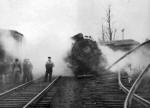 Photo: Peter LaLena Archive: Phillip LaLena
Photo: Peter LaLena Archive: Phillip LaLena
 LIRR
#5406 looking from the south side of the tracks eastward. It
shows two wreck cranes, the one in the foreground belonging to the
Pennsylvania Railroad. The one in the background is
unidentifiable and may be that of the LIRR. Both cranes are
hooked up to the heavy locomotive and are about to hoist her up and
onto the good trackage of the adjacent main. LIRR
#5406 looking from the south side of the tracks eastward. It
shows two wreck cranes, the one in the foreground belonging to the
Pennsylvania Railroad. The one in the background is
unidentifiable and may be that of the LIRR. Both cranes are
hooked up to the heavy locomotive and are about to hoist her up and
onto the good trackage of the adjacent main.
 Two
cars from the wreck in storage in the yard behind Morris Park Shops
two months later, on April 26, 1947. The car shown in its
entirety appears to be #339. Two
cars from the wreck in storage in the yard behind Morris Park Shops
two months later, on April 26, 1947. The car shown in its
entirety appears to be #339.
|
October 10, 1947 Wreck at
Port Washington |
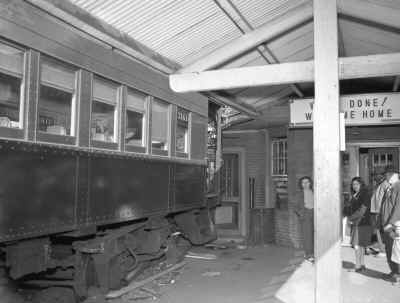 On Oct. 14, 1947, an LIRR train jumped the track after failing to come to a stop at the wooden guard bumper
at Port Washington. The train grazed a woman standing on the platform, causing serious injuries.
Photo Credit: Newsday/Howard Edwards On Oct. 14, 1947, an LIRR train jumped the track after failing to come to a stop at the wooden guard bumper
at Port Washington. The train grazed a woman standing on the platform, causing serious injuries.
Photo Credit: Newsday/Howard Edwards
|
1950's Wreck at Dunton
Yard, Jamaica |
|

|
A coach in the "Tichy" (1949-55) paint scheme that has
"escaped" from the Dunton yard shop area. The view is south over the Van Wyck expressway with the cross street Atlantic Avenue. The LIRR Main
is north of this photo behind the photographer's location. The coach
and autos in the photo place this as early 1950's. Info: Steven Lynch
|
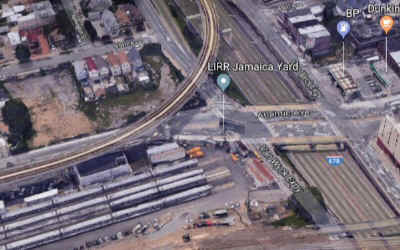
Current 2019 satellite view S of the location.
Source: Google maps
|
February 17, 1950 Wreck at Rockville
Centre |
 On
Feb. 17, 1950, two Long Island Rail Road trains collided head-on 200
yards west of the Banks Avenue crossing in Rockville Centre, killing
about 30 people and injuring about 100. Here, a crushed car of one of
the trains lies along the tracks the day after it was moved by a
crane. Photo Credit: Newsday/ Howard Edwards On
Feb. 17, 1950, two Long Island Rail Road trains collided head-on 200
yards west of the Banks Avenue crossing in Rockville Centre, killing
about 30 people and injuring about 100. Here, a crushed car of one of
the trains lies along the tracks the day after it was moved by a
crane. Photo Credit: Newsday/ Howard Edwards
The Rockville Centre crash involved a gantlet
track, constructed temporarily due to a clearance problem related
to the RVC grade crossing elimination project. This happened
near the old RVC freight yard, now a mini shopping mall although the
lead track overpass in still in place minus its track.
The LIRR had smashboards, but they didn't work as one train's
engineman "blacked out" and ran through the signals,
hitting the other train as this, unlike the Kew Gardens crash, was a "headon"
collision.
Incidentally, this lead to ASC being installed--New York State paid
for it since the LIRR was broke--and the "retirement of class
MP54 and MP54A cars as headend units; they had their controls,
headlights, etc. removed for mid-train service, thus creating
a new class of car: the MP54, MP54A, MP54B and MP54C motorized trailer
cars having motors but no controls--Hank
Raudenbush called these cars "blind motors."
The MP54 and MP54A cars also had thin collision posts, unlike later
classes of cars, something you can clearly see when you look at a
photo of the end of the car(s). This allowed "telescoping" since
the cars, unlike early subway cars, did NOT have anti-climbers, those
grated-looking features at the base of the floor.
MP54A #1482 wrecked at RVC.
Research: Mike Boland
|
 Feb
17 1950 Both Engineers survived. 32 passengers died. LIRR trains #192
and #175 Archive: Art Huneke Feb
17 1950 Both Engineers survived. 32 passengers died. LIRR trains #192
and #175 Archive: Art Huneke
|
 Newsday front page: 02/18/1950
Newsday front page: 02/18/1950
|
|
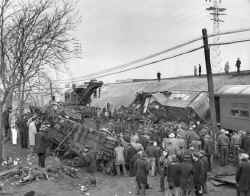 On
Feb. 17, 1950, 32 people were killed and more than 100 were injured in
a head-on collision of two LIRR trains in Rockville Centre. As part of
a grade crossing elimination program, a gauntlet track had been set up
to route one train at a time over 2,000 feet of temporary tracks. As
the eastbound train left the Rockville Centre station and headed into
the gauntlet, a westbound train originating in Babylon slammed into
it, mangling both trains. The conductor of the eastbound train claimed
in court that he had blacked out before the crash, and was later
acquitted of manslaughter. Here, spectators gather close to the scene
as salvage crews begin removing wreckage on Feb. 18, 1950. On
Feb. 17, 1950, 32 people were killed and more than 100 were injured in
a head-on collision of two LIRR trains in Rockville Centre. As part of
a grade crossing elimination program, a gauntlet track had been set up
to route one train at a time over 2,000 feet of temporary tracks. As
the eastbound train left the Rockville Centre station and headed into
the gauntlet, a westbound train originating in Babylon slammed into
it, mangling both trains. The conductor of the eastbound train claimed
in court that he had blacked out before the crash, and was later
acquitted of manslaughter. Here, spectators gather close to the scene
as salvage crews begin removing wreckage on Feb. 18, 1950.
Photo
Credit: AP/Newsday - Rockville
Centre view NW 2/18/1950
Photo: AP Archive: Art Huneke
|
|
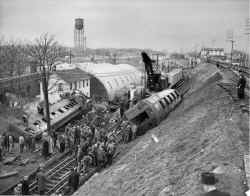 Rockville
Centre view W 02/18/1950
Archive: Art Huneke Rockville
Centre view W 02/18/1950
Archive: Art Huneke
|
|
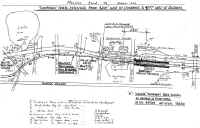 This map indicates the location of
the accident. Rockville Centre - Robert Emery Map c.1950
Archive: Dave Keller This map indicates the location of
the accident. Rockville Centre - Robert Emery Map c.1950
Archive: Dave Keller
|
August 5, 1950
Huntington LIRR
#642, Pass Train First-Class
Eastbound |
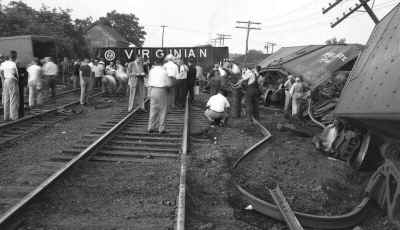 Last
wreck between steam locomotives on the LIRR - Freight versus
passenger - G5s #29 on its side at right behind tender - Huntington,
NY - 8/6/50 (Fred Weber photo, Dave Keller archive) Last
wreck between steam locomotives on the LIRR - Freight versus
passenger - G5s #29 on its side at right behind tender - Huntington,
NY - 8/6/50 (Fred Weber photo, Dave Keller archive)
|
This accident occurred on that part of the
railroad extending between Divide and Port Jefferson, N. Y., 32.5
miles. In the vicinity of the point of accident this is a
single-track line, over which trains are operated by timetable,
train orders and a manual-block system. At Huntington, 9.8 miles
east of Divide, a siding 4,169 feet in length parallels the main
track on the south. The west and east switches of this siding are,
respectively, 3,343 feet west and 826 feet east of the station. An
auxiliary track connects with the west end of the siding in the
vicinity of the clearance point and parallels the main track
westward. The accident occurred on the siding at a point 306 feet
east of the west switch and 3,037 feet west of the station. Entry to
the siding from the west is made through a No. 10 turnout, 180 feet
in length. From the west the main track is tangent throughout a
distance of 4,784 feet to the west switch of the siding and 2,733
feet eastwards. The grade for east-bound, trains is, successively,
0.4 percent descending 1,600 feet, level 600 feet, 0.3 percent
ascending 2,800 feet, level 300 feet, and 0.5 percent descending 500
feet to the point of accident and 300 feet eastward.
The switch stand of the main-track switch is of the ground-throw,
hand-operated, low-stand, type. It is located 6 feet 4-1/4 inches
south of the center-line of the main track. The switch target is
attached to a separate stand of the intermediate type, located on
the north side of the main track, directly opposite the switch stand
and 7 feet 11-1/4 inches from the center-line of the track. The
switch stand and the target stand are so connected that when the
switch is lined for main-track movements a V-shape white target with
pointed ends, each of which is 13 inches long and 9 inches wide, and
a green light are displayed in the direction of an approaching
train. When the switch is lined for entry to the siding a two-lobe
red target, 24 inches in length and 12 inches in width, and a red
light are displayed at right angles to the track. The center of the
target is 6 feet 2-1/4 inches above the level of the tops of the
rails. It is provided with an oil-burning switch lamp, the top of
which is 7 feet 4-1/4 inches above the level of the tops of the
rails.
Extra 101 West, a west-bound freight train, consisted of engine 101,
20 cars and a caboose. This train departed from Port Jefferson at
6:51 a.m., entered the siding at Huntington and reported clear of
the main track at 3:25 p.m. The engine was detached and switching
was performed. Engine 101, headed west, with a cut of three cars
coupled to the front end, stopped about 4:01 p.m., with the west end
of the most westerly car of the cut of cars at a point 306 feet east
of the west aiding-switch. About 10 minutes later the cut of cars
was struck by No. 642.
No. 642, an east-bound first-class passenger train, consisted of
engine 29 and six coaches. All cars were of steel construction. This
train departed from Divide at 3:53 p.m., 2 minutes late, passed
Block Station S, the last open office, 3.8 miles west of Huntington,
at 4:03 p.m., 2 minutes late, and the moving at an estimated speed
of 40 miles per hour it entered the siding at Huntington and struck
the cars coupled to engine 101.
The three cars were derailed and engine 101 was moved eastward
approximately 80 feet. The first and the third cars of the cut were
demolished and the second car was badly damaged. Engine 101 was
considerably damaged. No. 642 stopped with the front of the engine
about 70 feet east of the point of accident. The engine was derailed
and stopped on its right side south of the south rail of the siding.
The tender was derailed but remained coupled to the engine and
leaned to the south at an angle of about 20 degrees. The engine was
considerably damaged and the tender was somewhat damaged. The first
car was derailed and stopped in line with the siding. The first five
cars were slightly damaged.
The swing brakeman of Extra 101 West, and the engineer, the fireman,
the conductor and a ticket collector of No. 642 were injured. The
weather was clear at the time of the accident, which occurred at
4:11 p.m.
During the 30-day period preceding the day of the accident, the
average daily movement in the, vicinity of the point of accident was
26.8 trains.
Extra 101 West entered tile siding at Huntington at 3:26 p.m. The
engine was detached from the train and switching was performed.
About 4:01 p.m. the engine, coupled to the east end of a cut of
three cars, entered the siding from the auxiliary track and stopped
with the west end of the most westerly car 306 feet east of the
siding switch. The conductor had instructed the other members of the
crew that the main track would be used to perform switching after
No. 642 arrived. Immediately before the accident occurred the
engineer was in the cab of the engine and the fireman was on the
ground south of the siding End in the immediate vicinity of the
engine. The conductor and the swing brakeman were on the ground
between the siding and the main track and in the vicinity of the
west end of the cut of cars. The flagman was stationed east of his
engine at a rail-highway grade-crossing to protect the movement of
the engine during switching operations. The front brakeman was
standing south of the main track and about 15 feet from the west
siding-switch. The conductor said that as No. 642 was approaching
the crossing he signaled to the front brakeman to move away from the
switch. He said that the main-track switch was lined in normal
position when No. 642 was about 500 feet west of the switch. When
No. 642 was about 250 feet west of the switch the front brakeman
lined the switch for entry to the siding. No. 642 entered the siding
and the collision occurred a few seconds later. None of the other
members of the crew of Extra 101 West saw the front brakeman operate
the switch.
As No. 642 was approaching the west siding-switch at Huntington the
speed was about 50 miles per hour. The engineer was maintaining a
lookout ahead from his position in the cab of the engine and the
fireman was attending the fire. The conductor was in the rear of the
first car and other members of the train crew were at various
locations in the cars of the train. The brakes of this train had
been tested and had functioned properly when used en route. The
engineer observed the engine and the cut of cars on the siding. Then
No. 642 was about 750 feet west of the west siding-switch he closed
the throttle preparatory to making the station stop at Huntington.
He said that when the train was closely approaching the switch he
saw a person proceed from an adjacent track to the switch and
apparently operate it. The engineer then observed that the switch
points were lined for entry to the siding. He immediately initiated
an emergency application of the brakes. The fireman said that ten
his engine was about 100 feet west of the switch he saw the red
target indicating that the switch was lined for entry to the siding.
The speed of the train had been reduced to about 40 miles per hour
when the collision occurred.
The front brakeman was an inexperienced employee, and because of his
inexperience he had been instructed by the conductor to operate
switches only when specifically instructed to do so. He was aware
that his train was into clear on the siding to meet No. 642. He said
that after his engine with the cut of cars had stopped on the siding
the conductor told him to station himself near the siding switch and
to operate it when so instructed. When No. 642 was closely
approaching the switch he saw the conductor signal to him and he
said he thought it was a signal for him to open the main track
switch. He said No. 642 was about 200 feet from the switch when he
opened it. He did not observe the position of either the switch
points or the switch target. Historical Data: Kyle V. Mullins
|
November 22, 1950 Collision at
Richmond Hill west
of Jamaica Station |
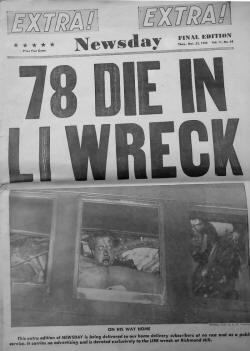 On Nov. 22, 1950, a Hempstead-bound LIRR train became stalled a half-mile west of the Jamaica station, near Richmond Hill. Minutes later, a Babylon-bound train traveling at 65 miles per hour barreled into the rear of the halted train, which sat in the
darkness. The crash killed at least 78 people and injured 400. Photo Credit: AP
Archive: Newsday On Nov. 22, 1950, a Hempstead-bound LIRR train became stalled a half-mile west of the Jamaica station, near Richmond Hill. Minutes later, a Babylon-bound train traveling at 65 miles per hour barreled into the rear of the halted train, which sat in the
darkness. The crash killed at least 78 people and injured 400. Photo Credit: AP
Archive: Newsday - EXTRA
- EXTRA
MP54A 1516 on Train 780 and MP54A 1523
in Train 174 were wrecked in the 11/22/50 crash. Research:
Mike Boland
|
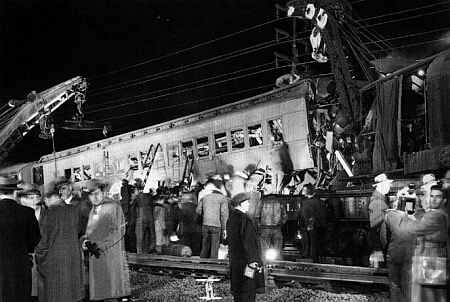 "The
People's Almanac" (Wallachinsky and Wallace, 1975, p. 564) gives
the following very detailed description of what happened: "The
People's Almanac" (Wallachinsky and Wallace, 1975, p. 564) gives
the following very detailed description of what happened:
William W. Murphy, a 45-year veteran
of railroading and just 4 years away from retirement, responded to the
"restricted" signal on "C" tower 2 miles before
the train's first scheduled stop at Jamaica. With the signal’s
change to "approach," Murphy resumed his 30-mph speed. The
next signal light on "J" (for Jamaica) tower showed
"restricted" and again Murphy applied the air brakes. They
grabbed and wouldn't release. Train 780 and its 12 cars carrying 1,000
homeward-bound passengers ground to a dead stop. Brakeman Bertram N.
Biggam started to get the flares to put behind the stalled train.
|
|
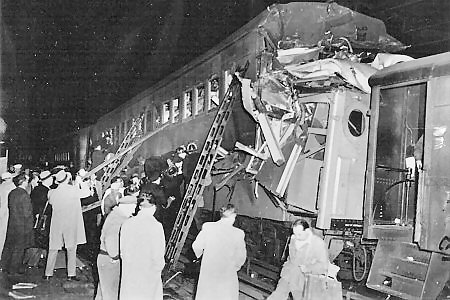 Close
behind on the same mainline track, Train 174 with 12 cars and 1,200
passengers thundered toward Jamaica. Motorman Benjamin J. Pokorny
obeyed the signal at "C" tower and brought his train to a
halt. When the signal changed, he accelerated to 15 mph. In back of
him the "C" tower signal changed again back to
"restricted," but ahead the signal on "J" tower
flashed "approach." Train 174 resumed full speed. Too late
Pokorny saw the stopped train ahead. In his last seconds of life he
pulled the brake cord . . . Close
behind on the same mainline track, Train 174 with 12 cars and 1,200
passengers thundered toward Jamaica. Motorman Benjamin J. Pokorny
obeyed the signal at "C" tower and brought his train to a
halt. When the signal changed, he accelerated to 15 mph. In back of
him the "C" tower signal changed again back to
"restricted," but ahead the signal on "J" tower
flashed "approach." Train 174 resumed full speed. Too late
Pokorny saw the stopped train ahead. In his last seconds of life he
pulled the brake cord . . .
Neither train was equipped with an
automatic repeater signal system, an electronic device mounted in the
motorman's cab. Murphy and Pokorny had to rely on signal towers spaced
at intervals along their route. Normally this signal-light system
worked fine, but if a signal changed after a train had passed a tower,
the system didn't work at all. Pokorny should have seen the taillights
of the stalled train, if they were on. And that raised an unanswered
question, for in a report by the Long Island Railroad to the Public
Service Commission it was reported that within a 7-day period the
taillights on 50 trains had been inoperative. . .
Passengers aboard Train 174 suffered
their annoyance in silence. It wouldn't be the 1st time they had
arrived home late. There was no warning of danger until the headlight
of train 174 bathed the last car in its blinding glare. In seconds the
two cars were fused together. The front car of Pokorny's train
telescoped the rear of Murphy's train. Those not killed outright were
overcome with fear. The trains were dark. Bedlam reigned inside the
cars. People physically capable of moving couldn't because of the
pileup of dead and injured bodies.
The noise of the collision was heard
on 126th Street and Hillside Avenue. Soon help arrived, but it was an
hour and 20 minutes before the last passenger was extricated from the
bent and twisted cars. Amputations were performed on the spot and
acetylene torches were used to free many trapped passengers. Priests
administered last rites while doctors administered plasma. For
hundreds of New Yorkers the tragedy turned Thanksgiving Day, 1950,
into the blackest of black Thursdays. |
The brakeman soon heard the Hempstead train
power up. He thought the braking problem was solved and that the train
was about to get underway. So, he extinguished the lantern and
reboarded the rear car. That was a mistake. It was not for the
brakeman to guess when to return to the train. Under the Railroad's
rules, he was to remain on the tracks until recalled by a specific
signal from the train's whistle, and no such signal was ever given. In
any case, the brakeman had guessed wrong. The brakes had still not
released and the Hempstead train remained rooted to the ground. Now,
however, it stood unprotected in the dark of night, with no rear
warning lantern, fusee or torpedo to alert an oncoming train it was
there. It was almost 6:30 PM - the middle of rush hour - when commuter
traffic in that direction was four times heavier than during off-peak
periods.
Probably seconds after the brakeman extinguished the warning lantern,
a New York to Babylon train came around the bend about 4,600 feet
back. At this point, the Babylon train received a "Go Slow"
signal indicating congestion up ahead, so it reduced its speed to
15mph. However, as it passed through the Kew Gardens Station area, the
motorman of the Babylon train caught sight of the next signal one half
mile in the distance. That signal showed "All Clear". It
never dawned on him that the All Clear signal was meant for the
Hempstead train stalled in darkness only a third of a mile ahead.
Since the Hempstead train no longer displayed a rear warning lantern,
the motorman of the Babylon train did not see it was there. (Although
the rear of the Hempstead train had two red lights called "marker
lights", those lights were so small that they would not have been
visible to him until too late.) Thinking the "All Clear" was
meant for him, he increased speed. As the Babylon train left the Kew
Gardens Station area and emerged from the Lefferts Boulevard overpass,
it was traveling at about 35mph.
Meanwhile, on the Hempstead train, the brakeman had signaled his
motorman that he was back onboard and that the train could proceed.
The train did not move, The brakeman signaled again, and still the
Hempstead train did not move. The brakeman was preparing to get back
out on the tracks when the oncoming Babylon train struck from the
rear. In the last seconds of his life, the motorman of the Babylon
train had tried to apply his emergency brakes, but he succeeded only
in slowing the Babylon train to about 30mph before impact. The force
of the collision pushed the Hempstead train a distance of 75 feet,
lifting its last car 15 feet into the air and splitting it lengthwise.
The Babylon train had the superstructure of its first car sheared off
to the floor and demolished. The rear brakeman was injured but
survived. The collision left 78 dead and 363 injured. One witness
described the dead as "packed like sardines in their own
blood".
Press accounts in the aftermath of the
collision had the Babylon train going 60 to 65mph at the time it hit.
However, the Interstate Commerce Commission investigated the collision
and found the speed at impact was about 30mph. Had the Babylon train
been going 60mph or more, the resulting devastation would have been
much worse and most likely other cars in the two trains would have
separated or derailed. That did not happen. Only slight damage was
suffered by the other cars all of which remained connected and on
track.
The cause of the crash was officially determined to be disregard of
the Go Slow signal by the deceased motorman of the Babylon train. He
should have followed the Go Slow signal he had just passed rather than
the All Clear signal a half mile ahead. However, the Interstate
Commerce Commission's Report on the crash seemed to imply that the
brakeman on the Hempstead train had not done all he could have to
protect his train - a conclusion I find unavoidable given that the
brakeman extinguished his warning lantern and returned to the train
before being signaled to do so. It was a clear night, and the brakeman
assumed at the time that no train would approach at more than 15mph.
So he thought the risk of a casualty was remote. He miscalculated,
just as the motorman of the Babylon train miscalculated.
The crash occurred only nine months after a head on collision between
two Long Island Rail Road trains at Rockville Centre, NY killed 31 and
injured 158. According to The Long Island Press newspaper, the two
accidents caused the public to view to the Long Island Rail Road as
unsafe and irresponsible. Queens District Attorney Charles P. Sullivan
called it the "Death Valley Railroad." The disaster led to
public demands for increased government scrutiny. Yet, blame for what
happened that night extended beyond the Railroad's management to the
very State Government that was called upon to take action.
Because the Long Island Rail Road was a monopoly, it was subject to
regulation by the New York State Public Service Commission. The
Commission had refused to allow the Railroad any rate increases for
almost 30 years (1918 - 1947) despite the L.I.R.R.'s increased
operating costs and resulting heavy losses. Furthermore, because
people always had the option of taking their cars rather than the
train, the Long Island Rail Road had to compete for the public's
transportation dollars with the various New York State authorities
that owned and operated the bridges, tunnels and highways. Unlike the
Long Island Rail Road which was heavily taxed in all respects, those
authorities paid no tax whatsoever on their real estate, assets or
income. Moreover, bridges, tunnels and highways cost much less to
maintain than a railroad. All of that left the Long Island Rail Road
at a permanent competitive disadvantage, and every effort to level the
playing field by providing badly needed subsidies for the Railroad was
defeated in the State Legislature.
The result of that kind of transportation policy should not have been
hard to foresee. By 1950, the Railroad was starved for cash and it's
equipment was old and decrepit. The two cars involved in the crash
were Class MP54A and had been built in 1910, more than 40 years
earlier. Such cars were the rule, not the exception. One newspaper
reporter cracked that if the Long Island Rail Road were a model train
set, it would make a little boy cry to find it under his Christmas
Tree. On the date of the collision, the Long Island Rail Road had
already filed for bankruptcy reorganization and was operating under
the supervision of two bankruptcy trustees. Two days after the crash,
Governor Dewey told The Brooklyn Eagle newspaper that $50,000,000 was
needed just to make the Long Island Rail Road, "reasonably safe
and to insure something approaching satisfactory operation." That
was money the perennially cash poor Railroad just did not have, and
the State Government had mostly itself to blame for the situation.
In the aftermath of the crash, Automatic Speed Control (ASC) was
installed on the tracks.(1) The Pennsylvania Railroad (which owned the
Long Island Rail Road) agreed to terminate the L.I.R.R.s bankruptcy
and begin a 12 year, 58 million dollar improvement program. The
L.I.R.R. gained exemption from much of its tax burden and the freedom
to charge realistic fares.
The point of impact for the collision was 1,960 feet east of the Kew
Gardens Long Island Rail Road Station near 125th Street - one block
west of the Metropolitan Avenue overpass. Although press accounts at
the time described that area as Richmond Hill, neighborhood boundaries
have long since changed. Today, the site of the collision is
considered to be in Kew Gardens.
Info: Joe
DeMay www.oldkewgardens.com
According to my ICC report of the wreck this is what was determined to have taken place:
The first eastbound train had not stalled but applied its brakes to stop for a signal and then could not release the brakes. A brakeman was sent out with a lantern but was recalled when the brakes released and he headed back. Then they froze again and when he went back out, saw the train bearing down on them and rushed back to his train, tossing the lantern on the tracks and running through the last car into the next to last car where, upon impact, he was flung into the ceiling of the car and knocked unconscious. He always attributed his survival to the durability of his trainman's cap per personal interview between the brakeman and the late retired conductor Jeff Skinner.
The second eastbound train had been stopped at the signal just west of the Kew Gardens station. The engineer then proceeded 3,516' to the point of impact just east of the Kew Gardens station, having increased his speed to 35 MPH. When he saw the stopped train ahead, he applied his brakes but there was insufficient distance to stop the train. When his train hit the first train, the force of the crash moved the first train 75' and telescoped into it. It was thought the engineer of the 2nd train assumed the train ahead of him had cleared the block so he picked up his speed when he should have proceeded with caution.
Info: Dave Keller
_______________________________________________________________________________________________________________________________________________
Note 1: Typically a railroad used DC track circuits for
signaling. Consider that each rail is connected to one side of a 48 volt battery, with signal "blocks" being isolated from each other by insulated rail joints. At one end of each block is a battery, at the other end is an electromagnetic relay, or electric controlled switch that is activated by that battery. When a metal train axle shunts or bridges the two rails, it shorts out the battery causing the relay to de-energize or "drop". That relay is what activates the signal indications.
In third rail territory, both rails already contain one side of the 750 DC volt propulsion power, so to avoid its conflict, alternating current, instead of battery is used for signal "track" circuits. The LIRR uses 100 cycle AC for this. Where overhead AC catenary wires are installed, a different signal (track circuit) frequency is used in AC territory avoiding interference from that propulsion frequency.
The LIRR's speed control or cab signal system overlays another electric signal of different frequencies on the rails (or on wires between the rails) to activate the speed control system. Each cab signal indication or "aspect" is referenced from a different frequency. The magnetic current caused by this energy in the rails is "picked up" through induction by two "track receivers." which are wire coils under the engine's pilot. They are interpreted by the train's speed control system. Originally vibrating relays were used for this, now it's done electronically.
This system was designed by Westinghouse and installed after the 1950 wrecks through funding by the State of New York. When an engineman receives a cab signal indication (or speed indication) more restrictive than the speed at which he is operating, he receives a visible and audible warning. He must acknowledge the warning and reduce to the required speed. If he does not do this within a set time, the train stops automatically. |
January 2, 1953
New Hyde Park Grade Crossing Collision
|
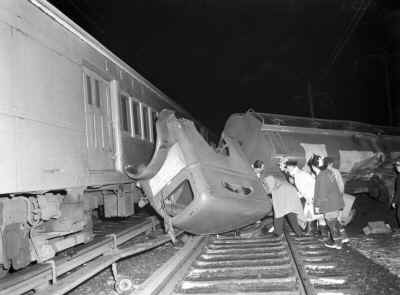 On Jan. 2, 1953, an eastbound LIRR train collided with an oil tanker at the Covert Avenue crossing in New Hyde Park. The truck had become stuck on the tracks at the crossing, and the driver alerted fire officials immediately. Firefighters were en route to the scene when the collision occurred, but there were no injuries, partly due to the relatively light load of oil in the tanker. The truck's capacity was 3,300 gallons, but it was carrying only 100 gallons of oil at the time of the crash. Photo Credit: Newsday / Harvey Weber On Jan. 2, 1953, an eastbound LIRR train collided with an oil tanker at the Covert Avenue crossing in New Hyde Park. The truck had become stuck on the tracks at the crossing, and the driver alerted fire officials immediately. Firefighters were en route to the scene when the collision occurred, but there were no injuries, partly due to the relatively light load of oil in the tanker. The truck's capacity was 3,300 gallons, but it was carrying only 100 gallons of oil at the time of the crash. Photo Credit: Newsday / Harvey Weber
|
February 4, 1954 New
Hyde Park Freight Derailment
|
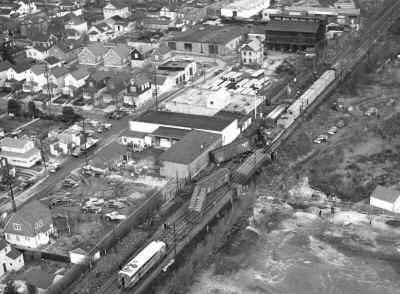 On Feb. 4, 1954, a freight train derailed in New Hyde Park, but disaster was averted when the engineer of an eastbound LIRR passenger train slammed on the emergency brakes to avoid making contact with the freight train. None of the 98 passengers or crew were injured in the incident. Here, an aerial view of the derailed freight train. On Feb. 4, 1954, a freight train derailed in New Hyde Park, but disaster was averted when the engineer of an eastbound LIRR passenger train slammed on the emergency brakes to avoid making contact with the freight train. None of the 98 passengers or crew were injured in the incident. Here, an aerial view of the derailed freight train.
Photo Credit: Newsday/Cliff DeBear
|
March 3, 1954 Maspeth
freight collided with a truck |
|
Two truckmen were injured when a Long Island
Rail Road switch engine hit a truck loaded with furniture at Grand
Crossing in Maspeth, Queens. Contents of the truck were strewn along
the track. John Rothanal, 53, of Middle Village, Queens, and Alfred
Gobie, 45, of Bronx, were hospitalized. |
1954 Old Country
Road, Hicksville |
 LIRR
wreck Old Country Rd. and Railroad Lane., Hicksville 1954 Archive:
Steve Chernow LIRR
wreck Old Country Rd. and Railroad Lane., Hicksville 1954 Archive:
Steve Chernow |
May 21, 1955 Woodbury
Road, Hicksville |

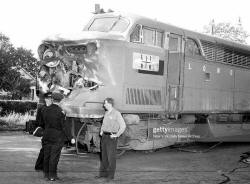

Long Island Rail Road FM CPA24-4-5 #2404 and 25
ton bulldozer collide on Woodbury Road in Hicksville, NY. The engine
of the train went about 200 feet to the middle of the road and
derailed about six cars. |
December 31, 1959
Locust Ave, Glen Head
|
|
 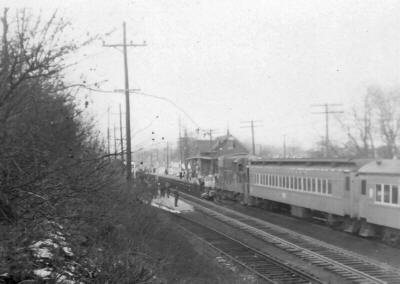 On
New Year’s Eve 1959, a Chevy pickup truck belonging to a certain
contractor decided to not heed the warning signs at the Locust Avenue
grade crossing just south (railroad west) of the Glen Head station on
the LIRR’s Oyster Bay Branch. Late morning Jamaica to Oyster Bay train
#524, led by H16-44 1506 (Fairbanks-Morse, 10/1951, s/n 16L-410) was
undoubtedly blasting out Rule 14L, to no avail. The train was probably
already beginning to slow for the station stop and came to a halt just
south of the station building. Jeff Erlitz On
New Year’s Eve 1959, a Chevy pickup truck belonging to a certain
contractor decided to not heed the warning signs at the Locust Avenue
grade crossing just south (railroad west) of the Glen Head station on
the LIRR’s Oyster Bay Branch. Late morning Jamaica to Oyster Bay train
#524, led by H16-44 1506 (Fairbanks-Morse, 10/1951, s/n 16L-410) was
undoubtedly blasting out Rule 14L, to no avail. The train was probably
already beginning to slow for the station stop and came to a halt just
south of the station building. Jeff Erlitz
Photos: Susan Peltz - Gold
Coast Historic Photographs collection, Gold Coast Public Library
|
April, 1961 "The Great
People Poop Wreck" |

On a night in April, 1961, in the early morning
hours, a deluge in excess of 2,000,000 gallons, of human effluent,
overwhelmed the railroad yard. The concrete bowl of the tank
scattered itself over the tracks. A steel New Haven caboose simply
bowled over, as did loaded refrigerator and hopper cars.
Crew working directly in the "flood plain" guide a bucket over
debris. Note the cap of the sewerage tank fallen into the center of
the "bowl".
Photos: Harry A. Glueck
Archive: Richard Glueck
MORE:
Poop Wreck article originally appeared in: "The Keystone" Vol.
48 No. 3 Autumn 2015
|

A broader view of Bay Ridge Yard,
featuring the blown-over freight cars, Long Island Baldwin 409, and
caboose C35. |
April 8, 1962
Grove Ave., East Patchogue Grade Crossing Collision |
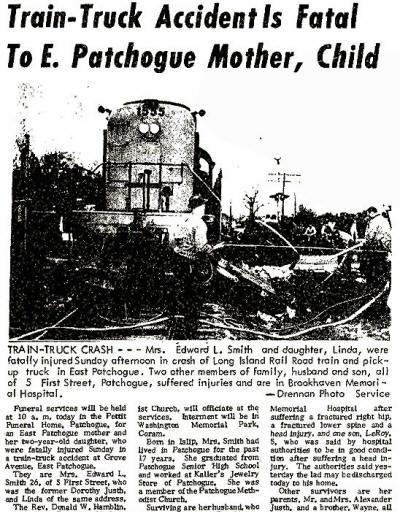 Westbound
LIRR passenger train and pick-up truck at Grove Ave., East Patchogue
on Sunday April 8, 1962. Westbound
LIRR passenger train and pick-up truck at Grove Ave., East Patchogue
on Sunday April 8, 1962.
The Long Island Advance
- 4/12/1962 Archive: New York State Historic Newspapers Project,
and Celia M. Hastings Local History Room, Patchogue-Medford Library.
Research: Gary Lutz, Librarian
 |
August 13, 1962
Collision at Woodside
|
|
On August 13, 1962, at Woodside, NY, there was a collision between a
pile-driving crane and a passenger train on the Long Island Railroad, which resulted
in t he death of one passenger, and in the injury of 31 passengers, 6 train-service employees and the crane operator. This accident was investigated in
conjunction with representative s of the Public Service Commission of New York.
|
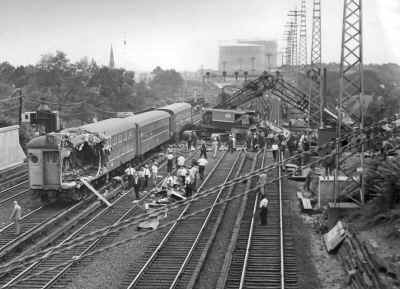 On Aug. 13, 1962, one person was killed and 17 were injured when a westbound LIRR passenger train collided with a 120-ton construction crane on the tracks near Woodside. The impact sliced away the side of the lead car of the train. Photo Credit: APO
Archive: Newsday On Aug. 13, 1962, one person was killed and 17 were injured when a westbound LIRR passenger train collided with a 120-ton construction crane on the tracks near Woodside. The impact sliced away the side of the lead car of the train. Photo Credit: APO
Archive: Newsday
|
|
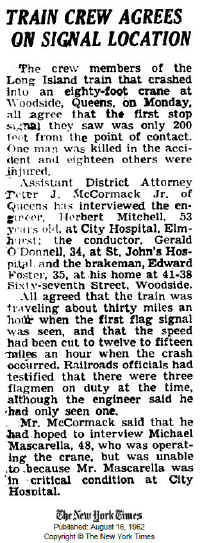
Further NY Times Material
|
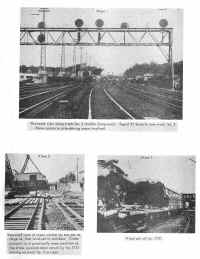
ICC Report #3962 The Long Island Railroad Company August 13, 1962
photos Archive: R. McEnery
|
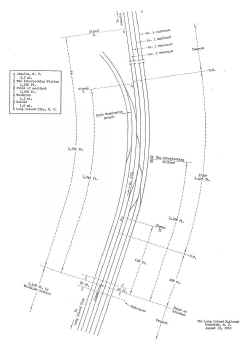
ICC Report #3962 Long Island Railroad
Company August 13, 1962
WIN Interlocking Archive: R. McEnery
|
August 24, 1962
Grove Ave., East Patchogue Grade Crossing Collision |
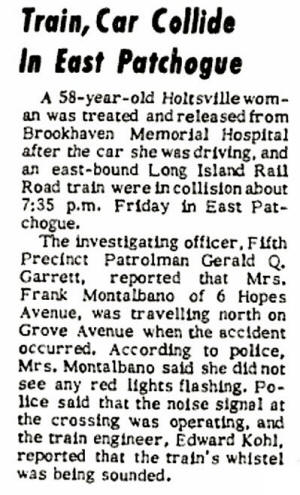 Eastbound
LIRR passenger train and northbound auto at Grove Ave., East Patchogue
on Friday August 24, 1962 at 7:35pm. Eastbound
LIRR passenger train and northbound auto at Grove Ave., East Patchogue
on Friday August 24, 1962 at 7:35pm.
The Long Island Advance - 8/30/1962
Archive: New York State Historic
Newspapers Project, and Celia M. Hastings Local History Room,
Patchogue-Medford Library.
Research: Gary Lutz, Librarian |
September, 1962 Collision
at Bay Ridge Yard
|
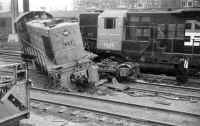
Bay Ridge Yard 10/1962
Photo: Ed Schleyer
|
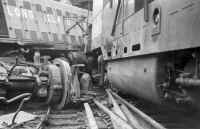
NH GP9 #1200 LIRR #447
Photo: Richard Glueck
|
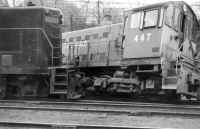
NH GP9 #1200 LIRR #447
Photo: Richard Glueck
|
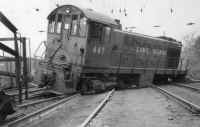
NH GP9 #1200 LIRR #447
Photo: Richard Glueck
|

Light tower on the right side of photo is next to Yardmasters
office. Unreported to news media. No one hurt! Photo: Ed Schleyer
|

At the scene: Bayridge Sept '62
Photo: Ed Schleyer
|
December
3, 1963 Brookhaven
Derailment
|
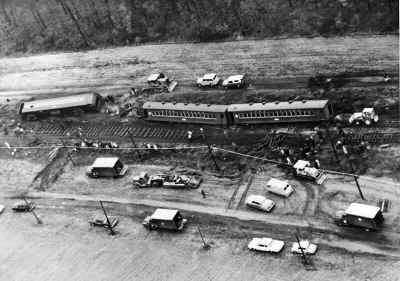 On
Dec 3, 1963, #31 from Speonk to Jamaica hit a broken rail near the former Brookhaven station (between Bellport and Mastic-Shirley) and derailed the last three cars. This aerial view was taken by a Newsday photographer, Cliff DeBear. There were some injuries, including a heart attack, but, fortunately, no deaths. On
Dec 3, 1963, #31 from Speonk to Jamaica hit a broken rail near the former Brookhaven station (between Bellport and Mastic-Shirley) and derailed the last three cars. This aerial view was taken by a Newsday photographer, Cliff DeBear. There were some injuries, including a heart attack, but, fortunately, no deaths.
|
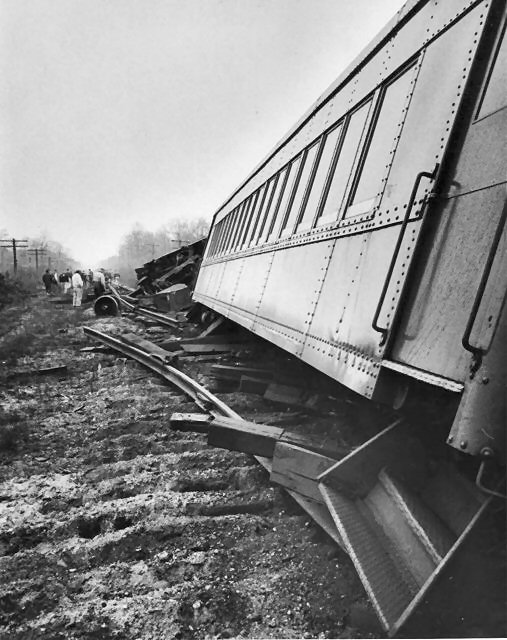 The next-to-last car of an LIRR trains lays on its side at Old Stump Road in Brookhaven after it derailed on Dec. 3, 1963. The last car can be seen in the background, completely on its side. Photo Credit: Newsday/Max Heine The next-to-last car of an LIRR trains lays on its side at Old Stump Road in Brookhaven after it derailed on Dec. 3, 1963. The last car can be seen in the background, completely on its side. Photo Credit: Newsday/Max Heine
|
c.1965 Vandalism
derail Ocean Ave., Bay Ridge Branch |
|

NH #302 and #306(?) wreck section house at Ocean Ave overpass Brooklyn
View W Photo: Harry Glueck Archive: Richard Glueck |

NH #302 at Ocean Ave overpass South Midwood, Brooklyn View E Photo:
Harry Glueck
Archive: Richard Glueck |

NH #302 vandal wreck boxcar at Ocean Ave overpass South Midwood,
Brooklyn View W Photo: Harry Glueck Archive: Richard Glueck |
|

Emery Map Bay Ridge Ocean Ave. overpass MP11.9 derail wreck location
#5 Archive: Dave Keller |
GE EL-C Electrics - Class EF-4 301-310 built
10/1956 Virginian Railway, N&W became NH 302, Class EF-4, in October
1963. It went as PC 4602, Class E-33, in 1969 and consigned Conrail
4602, Class E-33, in April 1976.
New Haven Railroad EF-4 electric locomotives
# 306 & # 302 known as "bricks," among railfan's, as these locomotives
received their own distinctive paint scheme. Thus, the accident
between Oct 1963 and 1969. Research: Steven Lynch
|
March 12, 1966 Pine
Aire Dr, Brentwood Wreck
|
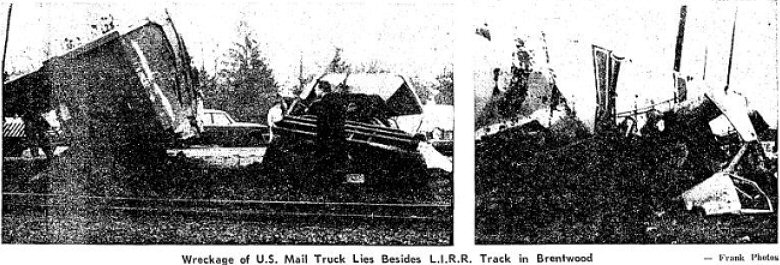
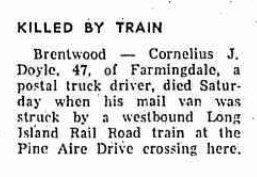
Accident occurred: 3/12/1966 Islip Bulletin 3/17/1966
Right: Suffolk County New 3/17/1966
|
November 6, 1966 LIRR
C420
Easthampton
Wreck
|
|
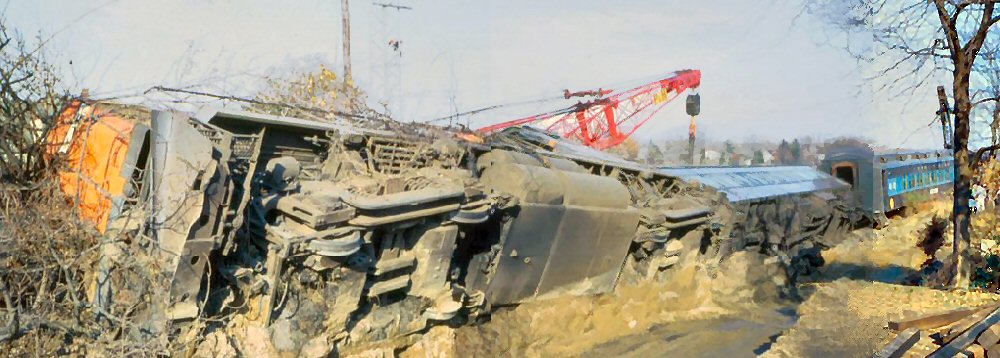
Composite of three Ed Schleyer photos
taken November 7th, 1966
|
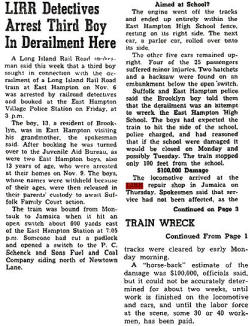 The
East Hampton Star 11/10/1966 - LIRR Derailment November 6th, 1966 The
East Hampton Star 11/10/1966 - LIRR Derailment November 6th, 1966
 Sunday
Evening 7:05pm westbound from Montauk was the derailment time and
Train 4013 was right on time. The Schenk Coal siding was just on the
other side of the Osborne Lane crossing near the east end of the
station. 4013 was the Winter variant of 4011; The Sundowner. 4011 was
the parlor car only service on Sunday evenings to Hunterspoint Ave.
4013 ran on almost the same schedule a bit quicker because of the
smaller Winter crowds, but with added stops at Speonk and
Mastic-Shirley so the times from Patchogue to Jamaica were the same.
Jeff Erlitz Sunday
Evening 7:05pm westbound from Montauk was the derailment time and
Train 4013 was right on time. The Schenk Coal siding was just on the
other side of the Osborne Lane crossing near the east end of the
station. 4013 was the Winter variant of 4011; The Sundowner. 4011 was
the parlor car only service on Sunday evenings to Hunterspoint Ave.
4013 ran on almost the same schedule a bit quicker because of the
smaller Winter crowds, but with added stops at Speonk and
Mastic-Shirley so the times from Patchogue to Jamaica were the same.
Jeff Erlitz
Emery Map- Easthampton MP100-101
Archive: Dave Keller
Ed Schleyer, was a contemporary of my
father and a fireman. He was riding the Montauk to Jamaica train that
was overturned by juveniles, east of Easthampton, in 1966. Ed
relates this story and has provided these images. If you ever needed a
rationale for operating C420's with the long hood first, this is it.
Intro: Rich Glueck
I was working the Montauk Greenport relief job as one of the senior
Firemen. The engineer and I worked 3 days to Montauk, 3 days to
Greenport and 3 days off. This was not a monotonous job. In my short
time as a fireman, I hit cars, trucks and the guy that trimmed me off
the job, hit an airplane. The day of this incident, I ran the train to
Montauk and The engineer Howard King brought it back, well almost all
the way back. I’m not sure of the consist, I think (2) varnish on
the west end and (5) coaches, not Pings, (1) engine #215. We left
Montauk with probably (1) paying rider. The flag man had his son
riding in the rear coach with him. I don’t know if we picked up any
riders before Bridgehampton, but we had way to much running time -
Montauk to Speonk. We were in “coast”, until the curve before
Bridgehampton. Now I am sitting with my feet up on the front door
frame. Going around a right hand curve, I can’t see the roadbed
ahead and Howard says “we’re going in”. I can’t connect this
phrase to anything but a “meet”. I looked over at Howard and the
next thing you know, I’m head to head with him. I’m wedged in
between the water cooler and the control stand, laying down and the
engineers front window is broken and lots of mud and water are passing
over our heads. Howard got hit in the face with the windshield, but
other than being covered with mud we were OK. At the moment we were
turning over, the thought that we were at the Water Mill curve went
through my mind. We had derailed and were going into the Water Mill
Pond. I knew by now (everything in slow motion) I’m gonna survive
the derailment, but I’m gonna drown, I don’t know how to swim. The water from the water cooler was draining on my head and the
mud was filling up the engineers side of the engine.
When we stopped moving, I killed the engine
and started digging Howard out. We went out the front door and walked
down the side of the engine to someplace that didn’t look like a one
story drop to the ground. I left Howard there and went in the front
door of the head parlor car and came into the passageway that the
attendant room connected to. The attendant was sitting on the corridor wall trying to collect the
little liquor bottles that had spilled into the corridor. I reached
down and picked out two bottles of scotch, I figured that we needed a
drink. The attendant started freaking out about how he was responsible
for all of the beer and chips etc. I told him that every volunteer
fireman from Montauk to Speonk was gonna be here in a few minutes and
he better go get in the ambulance that was outside or face all of the
volunteers that were gonna show up. He went out the end of the
corridor that I had come in. I went the other way and came into the
head car where the conductor was on the other end of the car. The
offset door was now up above our heads and the conductor was convinced
he was gonna die there because we couldn’t climb up to the door. I
grabbed him by the hand and led him to the other end where the door
was on the bottom. The conductor went on his way and I went up to see
Howard on the main track. It seems my timing was bad when I offered
him the bottle of scotch. It seems that (2) teenagers, arrested and
released, stole tools from a section shed and went to the switch that
was the entrance to a coal trestle. They smashed the lock and switch
stand, opened the switch and waited for us to go up the siding, off
the end and into the school. Needless to say the locomotive couldn’t
make the 15 mph turnout at 40 mph.
Before I could leave I had to go back into
the locomotive. I had to make sure there wasn’t a flag stick in the
“Dead Man” and I had to pick up all my fillets of flounder that I
had caught from the docks where the submarines used to tie up. Five
pounds of fish that would have really smelled bad by the time #215 got
back to the shops. I got the fish and climbed back outside on the
outside of the engine compartment. When I got there a little old lady
was screaming and yelling at me “ look what you did to the fence
around the school”. I interrupted her shouting to ask her if she
liked fillet of flounder and would she like five lbs right now. She
said yes and I threw five lb plastic bag at her and hit her in the
chest, knocking her on her rear. She said “thank you” and the
problem with the fence disappeared. By now all the buses and cabs in
town were gone, being used to transport the crew to Patchogue, I didn’t
have a way to get home. As I started to walk toward the next crossing,
I see a LIRR Bronco coming toward me on the tracks. When he got to me
he stopped and asked what I was doing there, I told him and his
response was, what do I look like, some kind of Taxi, if you want to
get home you better start hitchhiking right now because it’s getting
dark. With that he drove off. I walked to the crossing and found an
open store. I went in and used the phone to call my wife. I told her
that no matter what she hears, I’m OK. I went back to the crossing,
took one last look and stuck out my thumb. The first car that came
along was a fisherman headed back home. He dropped me off at the
entrance to Belmont Lake State Park and my house faced on the park.
The next day I took my wife and son back out to Bridgehampton, where I
took the pictures. |
1966
Maspeth Grade Crossing Collision
|
 On Dec. 12, 1966, a truck driver was killed when his vehicle was struck by a diesel engine at a grade crossing in Maspeth. The engineer testified that it appeared the driver had stopped at the crossing and then surged forward, causing the collision. Photo Credit: UPI On Dec. 12, 1966, a truck driver was killed when his vehicle was struck by a diesel engine at a grade crossing in Maspeth. The engineer testified that it appeared the driver had stopped at the crossing and then surged forward, causing the collision. Photo Credit: UPI
|
October 18, 1967 LIRR
RDC
Wrecked - Blue
Point Rd., Holtsville
Vignette on this day: Engineer
“Patsy” Molese and the Budd Car by Dave Keller
|
On the morning of October 18, 1967, Patsy and
his fireman, John Connelly were in the cab of BUDD RDC car #3101 in
the two-car consist of train #204 headed eastbound for Greenport. The
fireman, a qualified engineer, was operating the controls. He had
just left the stop at Holtsville and was picking up speed. He saw the
whistle post advising him of the upcoming crossing of Blue Point Road
just east of the station and pulled the cord to warn oncoming traffic
of his approach. In 1967, Blue Point Road did not yet have automatic
flashing warning lights or gates. It was basically an unprotected
grade crossing, like so many others on the railroad, with only a
crossing sign as warning.
Suddenly, appearing in front of him was a huge cement or gravel truck
belonging to the contracting firm of Lizza Bros., Inc, who were
involved in the construction of the Long Island Expressway being
extended through Holtsville at that time. The truck driver either
didn’t hear the train’s whistle, or didn’t care and figured he’d make
it across the tracks by speeding ahead of the oncoming train.
Vignette on this day: Engineer
“Patsy” Molese and the Budd Car by Dave Keller
|
|
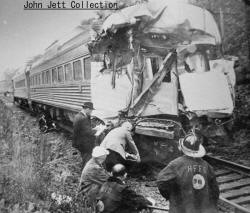
RDC 3101 Train 204 wreck at Blue Point Rd., Holtsville 10/18/1967
Holtsville-Farmingville Fire Dept on the scene.
Archive: John Jett
|
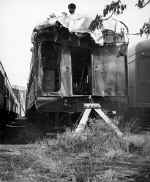 Here’s
a view of wrecked RDC1 #3101, taken on October 18, 1970 while it was
stored out back of the Morris Park Shops in
Queens
. The front of the car shows how the cab was cut away to extract
the remains of Patrick Molese. The unit was sold in December,
1971 to Sarnelli Bros. and scrapped at
Corona
Yard. (Photo by, and courtesy of, Richard Glueck) Here’s
a view of wrecked RDC1 #3101, taken on October 18, 1970 while it was
stored out back of the Morris Park Shops in
Queens
. The front of the car shows how the cab was cut away to extract
the remains of Patrick Molese. The unit was sold in December,
1971 to Sarnelli Bros. and scrapped at
Corona
Yard. (Photo by, and courtesy of, Richard Glueck)
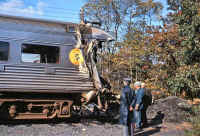 LIRR RDC #3101 Wrecked 1967, sold in
12/1971 to Sarnelli Brothers and scrapped at the LIRR’s Corona
Yard. LIRR RDC #3101 Wrecked 1967, sold in
12/1971 to Sarnelli Brothers and scrapped at the LIRR’s Corona
Yard.
Info: Dave Keller 6/2004 |
January
25, 1969 LIRR PASSENGER TRAIN # 4186 Tunnel
3 East River |
LIRR # 4186, an eastbound 10-car
electrically-propelled passenger train, left Pennsylvania Station at
9:46 p.m., with approximately 400 passengers aboard the first five
cars. About 9:50 p.m., the train entered tunnel 3 of the East River
Tunnels. About that time, a series of three or four loud reports
resembling sounds of explosions were heard emanating from an
electrical-equipment cabinet located inside the fourth car just behind
the front vestibule. The cabinet door opened, permitting fire and
smoke to come into the car. An unidentified passenger gave the
engineer a stop signal by pulling on the communicating whistle-signal
cord extending through the car. The engineer promptly applied the
brakes, stopping the train with the last car 500 to 1,000 feet inside
the tunnel.
The passengers in the fourth car evacuated that car by going back to
unoccupied cars at the rear of the train. During this period, the
conductor and ticket collector searched the train for a fire
extinguisher and found one in the 9th car. The conductor, however,
discovered it was not in working order after returning to the fourth
car. By that time, the fire and smoke in the car had intensified, and
fire damage to a brake valve had caused an emergency application of
the train brakes.
The conductor then proceeded to a nearby tunnel telephone and, at 9:58
p.m., informed the power director about the situation. As a result,
power to the third rail was shut off at 9:59 p.m., and car inspectors
were dispatched to the tunnel from Pennsylvania Station with
instructions to take whatever action was necessary to enable No. 4186
to move out of the tunnel. In addition, train No. 4890, which had left
Pennsylvania Station at 9:50 p.m. and had been routed to tunnel 3, was
instructed by a Penn Central trainmaster to push No. 4186 through the
tunnel to Harold, L. I.
About 9:57 p.m., No. 4890 stopped behind No. 4186. Approximately two
minutes later, the power director shut off power to the third rail,
preventing No. 4890 from moving forward to a coupling with the
disabled train. About 25 minutes later, after going back to an
interlocking station outside the west portal, both train conductors
succeeded in having power restored to the third rail.
Meanwhile, smoke conditions in the tunnel worsened and all the
passengers on the rear cars of the disabled train were evacuated to
No. 4890. All the passengers in the first three cars evacuated the
train by going to the elevated walkways along the tunnel walls. The
front brakeman led and/or directed them about 3,400 feet eastward to
an air shaft, where they eventually ascended via an emergency exit to
the street surface at 1st Avenue and 33rd Street, New York City. The
passengers' progress to the air shaft was impeded because of the poor
lighting and smoke conditions in the tunnel.
About 10:22 p.m., when power was restored to the third rail, No. 4890
coupled to the disabled train and made several unsuccessful attempts
to move it. The car inspectors sent to the scene then advised the
conductor and engineer of No. 4890 that they were unable to release
the brakes of the disabled train. Upon hearing this, the conductor of
No. 4890 had his train detached from the disabled train No. 4890 then
returned to Pennsylvania Station and stopped on station track 20 at
10:44 p.m., at which time passengers evacuated from the disabled train
were given first-aid treatment for smoke inhalation and/or taken to
hospitals.
Ambulances, and city fire and police department forces, were not
called before approximately 10:30 p.m., when a crew member of the
disabled train walked back to a stationmaster's office in Pennsylvania
Station and advised that medical assistance was urgently needed for
about 200 passengers. Approximately 20 minutes later, rescue forces
were also called to the emergency tunnel exit at 1st Avenue and 33rd
Street, when passengers from the first three cars of the disabled
train emerged to the street surface. Historical Data: Kyle V. Mullinsw members and 49 passengers of No. 4186 were injured by inhalation
of smoke. |
Late Spring, 1969
Babylon Yard M1 #9055 derailment |

George Winter inspecting the M1 front
truck.
|
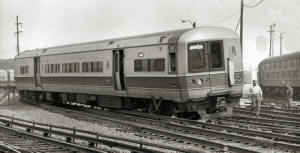
M1 G5s style pilot on #9055
|
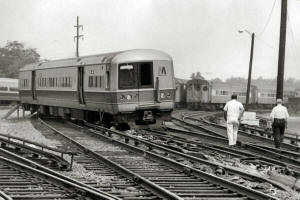
Harry Glueck on the far right.
|
|
The M1
#9055 derailment, late Spring 1969, was one I attended with my father. Nobody was supposed to
take pictures of anything "bad" happening to the LIRR, but my
father asked his boss if I could take pictures, provided they were for my
own collection, and wouldn't wind up in Newsday. The M1's had just
arrived and weren't fitting in too well, due to growing pains and
dissimilar equipment. Then, in a new batch, two burned to the floors
in a fire and the press went crazy over it. Anyway, George Winter
(in the shorts), my Father's peer agreed to allow the pictures based on my
word of honor. I kept them squirreled away for almost thirty years!
The M1's are still new equipment in my mind, even though they are now as
rare as MP70's! The M1's in this case, split a switch in Babylon
Yard. It was going to require a great deal of shuffling to get the
commuters out the following morning, but as was the case more often than
not, the LIRR came through. These brand new MU cars went into the
backshop and required some rebuilding. Photos/Info: Richard Glueck
|
June 23, 1969, East
End of Pennsylvania Station |
The accident occurred near the east end of
Pennsylvania Station, on the four-track line over which Long Island
Rail Road trains operate between Pennsylvania Station and Long Island.
C interlocking is located between the west portals of the East River
Tunnels and Pennsylvania Station. Its signals govern movements of LI
Rail Road trains between the west end of tracks No. 3 and No. 4 of the
four-track line and station tracks 14 to 21. The interlocking station
is at the east end of platform No. 10, between Pennsylvania Station
tracks 18 and 19.
The current of traffic on track No. 4 of the four-track line is
westward. The collision occurred on this track, 612 feet east of C
interlocking station and a few feet east of the home interlocking
signal governing westbound movements from track No. 4 to station
tracks 14 through 21.
Some time before the accident, passenger
train equipment was placed on Pennsylvania Station track 21 for
temporary storage. Anticipating that station forces would remove this
equipment before arrival of passenger train No. 751, a Long Island
Rail Road yardmaster instructed the C interlocking operator to route
No. 751 to station track 21. However, due to station forces
experiencing difficulty with its air brake system, the passenger train
equipment still occupied track 21 when No. 751 neared the station.
No. 751, a westbound passenger train consisting of seven
electrically-propelled passenger cars left Hempstead, L. I., at 2:09
p.m. When the train stopped at Woodside, the conductor, acting without
authority but in accordance with what appears to be a common practice,
went home after arranging for an off-duty employee, a ticket
collector, to replace him for the remainder of the trip to
Pennsylvania Station. The ticket collector had been a conductor at one
time, but had been disqualified from working in that capacity since
1962 because of a physical condition. No. 751 left Woodside without
the engineer knowing the regularly assigned conductor had left the
train.
About 2:55 p.m., after proceeding through the East River Tunnels on
track No. 4 and entering C interlocking, No. 751 began to enter
Pennsylvania Station track 21 at slow speed. The engineer then saw
that track 21 was occupied by passenger train equipment, and stopped
his train with the front end about 170 feet short of that equipment
and 160 feet from the track platform. The rear end stopped within C
interlocking limits. After the train stopped, it waited for station
forces to remove the equipment from the track ahead.
No. 159, a westbound Long Island Rail Road passenger train consisting
of 8 electrically-propelled passenger cars, left Babylon, L. I. at
1:49 p.m. About 2:53 p.m., while moving on track No. 4, it entered the
East River Tunnels and continued toward Pennsylvania Station,
following No. 751 at an interval of about three minutes. Seven minutes
later, No. 159 stopped on track No. 4 at the C interlocking home
signal, which indicated Stop due to the rear end of No. 751 occupying
its track circuit. The engineer saw No. 751 standing about 200-250
feet ahead, and waited for the home interlocking signal to display a
proceed aspect.
Approximately five minutes after stopping short of the passenger train
equipment occupying station track 21, the engineer of No. 751, in
response to a request of three off-duty employees, began to move his
train slowly forward toward the east end of the track platform,
causing loud electrical arcing sounds at the locations of the
third-rail contact shoes on the cars. As the train moved forward, the
communicating whistle sounded two short blasts (when moving, a signal
to stop) and the engineer stopped the train a few feet short of the
platform. A few seconds later, according to his statements, the
engineer heard the communicating whistle sound three short blasts
(when standing, a signal to back up) and looked into the passenger
compartment of the first car for the conductor, but did not see him.
Assuming the conductor had obtained authority for the reverse movement
and had gone to the rear of the last car to protect the reverse
movement, the engineer started to back his train through C
interlocking without stationing himself at the controls of the leading
car in the direction of the reverse movement, as required by the
carrier's rules. The engineer stated that on two separate occasions
after starting the reverse movement, the communicating whistle sounded
three short blasts (when moving, a signal to stop at the next
station). He construed these whistle signals as being confirmations of
the first signal to back up. The train continued its reverse movement
through C interlocking and, about 3:05 p.m., backed onto track No. 4
of the four-track line. Immediately thereafter, while moving backward
at about 10 m.p.h. it struck No. 159, which was standing on track No.
4 a few feet east of the home interlocking signal.
Statements of the three off-duty employees in the vestibule at the
front of the train substantiate those made by the engineer of No. 751
relating to the communicating whistle signals sounded before the
collision.
The off-duty ticket collector, who was acting as the train conductor,
was in the vestibule at the rear of the first car when No. 751 began
to move in reverse. He heard the communicating whistle signals
received by the engineer and took no exception to the reverse
movement.
The flagman of No. 751 was in the vestibule at the front of the 6th
car while his train waited on Pennsylvania Station track 21 for
station forces to remove passenger train equipment from the track
ahead. When his train moved slowly forward toward the station
platform, intermittent arcing noise occurred at the locations of the
third rail contact shoes. (The investigation revealed it is common
practice for LI Rail Road engineers to use arcing sound, instead of
train horn sound as required by rule, when recalling a flagman out
providing protection against following trains. This is accomplished by
setting the train brakes, then applying and shutting off power the
number of times specified for the horn signal prescribed for recalling
flagmen). Upon hearing the arcing noise, the flagman pulled the
communicating whistle cord twice (when stopped, a signal to proceed;
when moving, a signal to stop), intending this as a signal that he was
on the train and not out providing protection against following
trains. Since the train was moving when this signal was sounded, the
engineer construed it to be a stop signal and promptly stopped the
train, a few feet from the track platform and the passenger-train
equipment ahead.
Apparently realizing that he had unintentionally caused the train to
stop, the flagman again pulled the communicating whistle cord to
signal the engineer to proceed. However, instead of sounding two short
whistle blasts, he apparently sounded three short blasts (when
standing, a signal to back up), resulting in the engineer moving the
train in reverse. The reverse movement startled the flagman, and he
pulled the communicating-whistle cord with the intention of signalling
the engineer to stop. Instead of sounding two short whistle blasts, it
appears he again sounded three short blasts (when moving, a signal to
stop at the next station), resulting in the engineer assuming this was
a confirmation of the first signal to back up and continuing the
reverse movement. The flagman then decided to go to the rear vestibule
of the 6th car, apparently with the intention of operating the
emergency brake valve or the communicating-whistle signal apparatus in
that vestibule. While going through the car, he again pulled the
communicating-whistle cord with the intention of sounding a Stop
signal and with the same result as described above. A few seconds
later, No. 751 backed onto track No. 4 and struck No. 159.
Approximately 175 passengers and employees of both trains sustained
injuries, which were primarily of the abrasion, contusion, sprain, and
neck-whiplash types. Most injuries were relatively minor in nature.
Numerous injured passengers were transported to hospitals for first
aid Best available information indicates that three passengers were
injured seriously enough to require hospitalization. Historical Data:
Kyle V. Mullins
|
June
23, 1969 LIRR
PASSENGER TRAIN #850 FIRE at Elmhurst |
|
No. 850, an
eastbound passenger train consisting of seven electrically-propelled
passenger cars, was scheduled to leave Pennsylvania Station at 4:39
p.m. It was delayed in leaving, however, because of a collision
between LI Rail Road trains at the east end of the station at 3:05
p.m. During the delay, passengers continued to board No. 850 until all
its seats and standing room in the aisles and vestibules were fully,
occupied. About 1,100 passengers boarded the train, according to
estimates.
No. 850 left Pennsylvania Station at 5:50 p.m., 1
hour 11 minutes late, and proceeded eastward through one of the East
River Tunnels to Long Island. Shortly after it emerged from the
tunnel, wind forces caused a thin piece of metal (3 1/2" x
24") to fly up from the wayside and to lodge on the south side of
the rear truck of the 7th (last) car, between the third-rail contact
shoe hanger and the truck equalizer. This created a short circuit and
an electrical arc between the third-rail contact shoe assembly and the
truck frame or a journal box, igniting the lubricating material in the
journal box. Shortly after passing Harold, L. I., at 5:56 p.m., the
flagman noticed smoke arising from underneath the rear of the 7th car
and signaled the engineer to stop.
When the train stopped, the flagman and front
brakeman examined the rear truck of the 7th car and saw that the
lubricating material in the journal box of the rear wheel on the south
side of the truck was on fire. After making an unsuccessful search for
a fire extinguisher on the train, the front brakeman extinguished the
fire by stuffing a wet cloth into the journal box. He then returned to
the front of the train and informed the conductor that the 7th car had
an overheated journal (hot box). Soon afterward, the train proceeded
eastward without either the flagman or front brakeman having noticed
the strip of thin metal lodged on the rear truck of the 7th car.
No. 850 passed Win interlocking station in the
Elmhurst section of Long Island at 6:12 p.m., while moving at a speed
of about 30 m.p.h. About that time, the flagman heard loud
explosive-type sounds caused by electrical arcing at the location of
the rear truck of the 7th car. He then saw smoke and flames rising
from the truck, and signaled the engineer to stop. As the engineer
reduced speed to stop at a wayside telephone a short distance ahead, a
passenger pulled the cord of the emergency brake valve in a car,
stopping the train before it reached the wayside telephone.
Panic immediately developed among passengers in the
7th car when smoke and fire from the rear truck were seen to be rising
above the south side of the car. At that time, the flagman opened the
door on the south side of the rear vestibule of the 7th car to permit
passengers to escape. Not being able to proceed forward through the
car because of its crowded condition, the flagman alighted from the
rear vestibule, ran forward along the south side of the car to the
front vestibule, and opened the south door of that vestibule. While
attempting to open the trap door over the steps, he was thrown to the
ground by passengers leaving the car in panic. In the meantime, ticket
collectors in the fourth car alighted from the train, saw what was
happening, and ran to the rear alongside the train, opening doors on
the south side of vestibules in the cars.
While passengers were evacuating the train, the
conductor ran ahead to the wayside telephone and requested assistance.
This resulted in power to the third rail being shut off at 6:21 p.m.,
about 20 or 25 minutes after the train stopped. About 6:18 p.m., fire
and police department forces from several nearby communities arrived
at the scene.
Immediately after the train stopped, passengers in
the last car began to break out windows and jump to the ground. When
the vestibule doors were opened, passengers jumped to the ground from
unopened trap doors above the steps.
Eleven passengers were known to be injured as a result of jumping from
the 6th and 7th cars through windows and/or unopened trap doors. Six
other passengers subsequently claimed injury. Most injuries were of
minor nature, consisting primarily of lacerations, contusions,
abrasions, and sprains. Two passengers were hospitalized, one for a
fractured ankle, the other for a back injury. Historical Data: Kyle V.
Mullins
|
|
March 20,1970 Wreck of
the "Silver Streak"
|
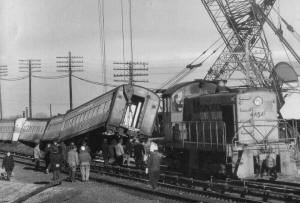 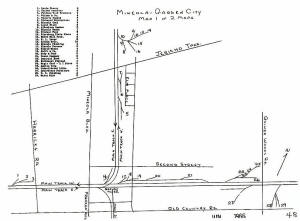 On
March 20,1970, the morning "Silver Streak" was westbound on track no.
2 to bypass other trains ahead of her. This train was an express to
Hunterspoint Avenue. One of the cars picked the switch at the freight
siding to Mason Mints, (LIRR 1966 location #29 map) which caused the
cars to derail, shutting down service and requiring several cranes and
wreck crews to clean up the mess. Pictured is Engine 454 working the
west end of the cleanup, pulling the rerailed coaches west so the
track can be rebuilt. RMLI On
March 20,1970, the morning "Silver Streak" was westbound on track no.
2 to bypass other trains ahead of her. This train was an express to
Hunterspoint Avenue. One of the cars picked the switch at the freight
siding to Mason Mints, (LIRR 1966 location #29 map) which caused the
cars to derail, shutting down service and requiring several cranes and
wreck crews to clean up the mess. Pictured is Engine 454 working the
west end of the cleanup, pulling the rerailed coaches west so the
track can be rebuilt. RMLI
Silver Streak wreck at Mason Mints siding
3/20/1970 Photo: Vincent Alvino Archive: RMLI |
|
|
July 17, 1970 Riverhead
Tank Car Crash
|
LIRR Gas Tank Car Fire Burns Out After 18 Hours
SPECIAL TO THE NEW YORK TIMES JULY 19, 1970 RIVERHEAD, L. I.
July 18— A 44,000-gallon railroad tank car of liquid propane gas that exploded here last night continued to burn until 4 P.M. today.
Two passenger trains were delayed slightly, but service was back to normal by late afternoon.
The explosion occurred when the tank car overturned on Long Island Railroad tracks as it was being moved to a siding. The fire that followed the ex plosion destroyed two diesel engines, a box car laden with lumber and the tank car.
The police said that the tank car was being shunted into a siding at the Pyrofax Gas Corporation's yard near the Mill Road grade crossing at about 10 P.M. when the accident oc curred. The explosion was heard several miles away and the flames were visible for 10 miles.
Five members of the train crew and a fireman suffered first- and second-degree burns. Three men were hospitalized but were reported to he in fair condition.
They are George Pack, 47 years old, of Babylon, the engineer; Richard Connor, 28, of Richmond Hill, a train fireman, and George Caffrey, 38, a River head volunteer fireman. Mr. Connor was released late this afternoon.
|
|
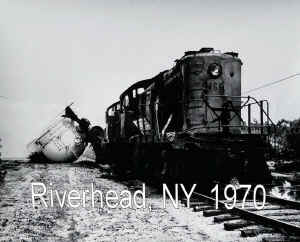 'It
is a decision of two cases regarding the aforementioned incident. The
crew performed a drop or flying switch where the engines are on the
facing point end of a switch and are unable to shove the cars into the
siding. The engineer will accelerate his engines and the entire train
before reaching the switch, bunch the slack, the conductor will pull
the pin, engineer will again accelerate past the switch points while a
ground man lines the switch for the diverging route after the engines
pass over the switch. The cars, now uncoupled from the engines, will
roll into the siding at which point a brakeman will tie on a hand
brake to stop the cars in the appropriate location. 'It
is a decision of two cases regarding the aforementioned incident. The
crew performed a drop or flying switch where the engines are on the
facing point end of a switch and are unable to shove the cars into the
siding. The engineer will accelerate his engines and the entire train
before reaching the switch, bunch the slack, the conductor will pull
the pin, engineer will again accelerate past the switch points while a
ground man lines the switch for the diverging route after the engines
pass over the switch. The cars, now uncoupled from the engines, will
roll into the siding at which point a brakeman will tie on a hand
brake to stop the cars in the appropriate location.
In this incident, the Engineer recalls seeing a backup sign from the
ground man after his engines cleared the switch, so he reversed
direction and subsequently collided with the NATX 34440 tanker which
eventually exploded, destroying one engine and seriously damaging the
other. A container found in the cab which was analyzed by Suffolk PD
was found to have a substance which amounted to 7% alcohol by volume.
It could not be proven whether this was window washing fluid or an
intoxicant used by the crew, so it was eventually discounted. One
empty beer can was found in the lead unit and two unopened containers
of beer were found in the trailing unit's icebox. All beer cans were
not found to be damaged by fire so the crew's defense was that those
containers were placed there well after the fire was extinguished,
possibly by firemen. It was concluded that performing the flying
switch wasn't the cause of the accident but rather the Engineer
mistaking a hand signal by a ground man to reverse direction before
the entire consist cleared the main track.'
|
|
|
August 21, 1970
Shelter
Island
Express
Grade Crossing Collision
|
|
"The
Wreck of The Shelter Island Express" by
John Deasy
One
Friday evening long ago, on August 21, 1970 to be exact, I was a
passenger onboard the Long Island Rail Road’s “Shelter Island
Express”, traveling from Jamaica to Cutchogue, en-route from my
summer job at Walter Dorwin Teague Associates at 437 Madison Avenue
in Manhattan to a weekend at my family’s summer cabin in New
Suffolk. Unfortunately, I did not have my Kodak Instamatic
camera with me, so I have no photos to document the results of the
grade crossing collision and our subsequent derailment. However,
I do have some lasting memories of this event, more than four decades
after it occurred.
At that time, LIRR train
212 was a summer season Friday night express from Jamaica to
Riverhead, making local stops from Riverhead to Greenport. The
railroad station at Greenport was just a short walk away from the
ferry to Shelter Island, and reserved seat extra fare parlor car
service was offered, which is the likely explanation why the train
retained the name Shelter Island Express in the railroad’s marketing
brochures. Departure from Jamaica (customarily from track 8) was
around 4:59 PM, reaching Riverhead around 6:30, and arriving at
Greenport shortly before 7:15 PM.
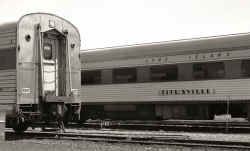 Our
locomotive was Alco RS-3 number 1555, running long hood forward.
There were one or two parlor cars immediately behind the locomotive.
The first car may have been the former Baltimore and Ohio lightweight
sleeper lounge observation which was often assigned to this train in
the 1970s, running observation lounge forward. I believe one was
a former New Haven lightweight sleeping car. They were followed
by a pair of former Florida East Coast stainless steel streamliner
coaches, trailed by a number of (two?) older P54 “Ping Pong”
coaches on the rear. The train was pretty full. A bar for
coach passengers was setup in one of the rear cars, and the attendant
was doing a brisk business. I had a plush reclining seat in one
of the FEC cars, TITUSVILLE, where the air conditioning worked just as
the Budd Company intended; it was comfortably cool and dry. It
was almost as good as a parlor car seat, but at a coach fare.
Titusville at Montauk 7/07/74 Photo/Archive: Ed Frye Our
locomotive was Alco RS-3 number 1555, running long hood forward.
There were one or two parlor cars immediately behind the locomotive.
The first car may have been the former Baltimore and Ohio lightweight
sleeper lounge observation which was often assigned to this train in
the 1970s, running observation lounge forward. I believe one was
a former New Haven lightweight sleeping car. They were followed
by a pair of former Florida East Coast stainless steel streamliner
coaches, trailed by a number of (two?) older P54 “Ping Pong”
coaches on the rear. The train was pretty full. A bar for
coach passengers was setup in one of the rear cars, and the attendant
was doing a brisk business. I had a plush reclining seat in one
of the FEC cars, TITUSVILLE, where the air conditioning worked just as
the Budd Company intended; it was comfortably cool and dry. It
was almost as good as a parlor car seat, but at a coach fare.
Titusville at Montauk 7/07/74 Photo/Archive: Ed Frye
As we worked our way eastwards on the mainline, I made note of our
progress. Divide Tower at
Hicksville, where the Port Jefferson branch diverges from the
mainline, was always one of my landmarks. After passing Ronkonkoma, we reduced our speed due to the poor
track conditions found on the east end of the mainline. Jointed rail, deteriorated wooden ties, minimal ballast and
limited maintenance made for a rough bouncy ride. I doubt our speed exceeded 30 MPH east of Ronkonkoma.
Even at that relatively slow pace, it was definitely not a
smooth ride.
Suddenly,
there was a bang and a lurch forward, and then we came to a stop.
It became very quiet. After
a while, we learned that we had hit a loaded tractor-trailer of
freshly harvested potatoes, at a rural grade crossing in Manorville.
Either the truck driver failed to pay attention and did not
hear the engineer blowing the horn signal as he approached the grade
crossing, or his truck somehow got stuck on the grade crossing.
The
locomotive had derailed and the long hood was pushed back. The first parlor car may also have derailed.
It was obvious from one look that our train wasn’t going any
further east tonight.
I
don’t recall any ambulances at the scene, so I doubt anyone was
seriously injured. I was
not injured.
 Eventually we were allowed
off the train. The Special
Service Attendant staffing the coach bar continued to sell his
beverages, and I suspect the parlor car attendants did likewise.
There was money to be made from a thirsty captive audience! We waited for some time, probably between one and two hours,
for busses to rescue us and take us east along Route 25 to the
stations from Riverhead to Greenport. I think our train was due at Cutchogue a few minutes before 7
PM, but I suspect I eventually got to Cutchogue between 9 and 10 PM.
I had survived my first train accident and derailment with no
injuries and an interesting story to tell. Eventually we were allowed
off the train. The Special
Service Attendant staffing the coach bar continued to sell his
beverages, and I suspect the parlor car attendants did likewise.
There was money to be made from a thirsty captive audience! We waited for some time, probably between one and two hours,
for busses to rescue us and take us east along Route 25 to the
stations from Riverhead to Greenport. I think our train was due at Cutchogue a few minutes before 7
PM, but I suspect I eventually got to Cutchogue between 9 and 10 PM.
I had survived my first train accident and derailment with no
injuries and an interesting story to tell.
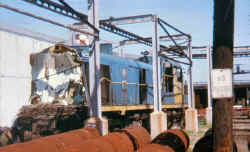 Locomotive
1555 at Morris Park Shops, circa late 1970 or early 1971, awaiting
repairs. Photo collection of
Steve Hoskins Locomotive
1555 at Morris Park Shops, circa late 1970 or early 1971, awaiting
repairs. Photo collection of
Steve Hoskins
Many years later, a friend
with a good knowledge of LIRR history told me that the railroad
rebuilt locomotive 1555 using the nose of a retired PRR Alco RS-3,
with its distinctive small marker lights. Some employees and
railroad enthusiasts referred to the rebuilt locomotive 1555 as
“Snake Eyes”, due to the small marker lights, or “Hungry
Jack”, in reference to its demonstrated appetite for freshly
harvested Suffolk County Long Island potatoes. Mineola,1974
Photo/Archive: Tim Darnell
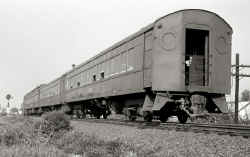 “Shelter
Island Express”
Julian Tillis was engineer,
Bob Emery conductor and I was the attendant on the early season (one
parlor) version of the Shelter Island Express. Since it ran express
from
Jamaica
to Riverhead, it always caught up with the preceding
Ronkonkoma
local before the latter cleared the SG-DK block. We were on-time in
Riverhead. I frequently worked the SI Express since I got home early
and the tips were better than the Montauks.
Info: Richard Makse “Shelter
Island Express”
Julian Tillis was engineer,
Bob Emery conductor and I was the attendant on the early season (one
parlor) version of the Shelter Island Express. Since it ran express
from
Jamaica
to Riverhead, it always caught up with the preceding
Ronkonkoma
local before the latter cleared the SG-DK block. We were on-time in
Riverhead. I frequently worked the SI Express since I got home early
and the tips were better than the Montauks.
Info: Richard Makse
LIRR train #212 at SG
block [Brentwood] 6/07/1968 Photo/Archive: Richard Makse
|
January
24, 1971 Pine Aire Pilgrim Hospital Switch Derailment
|
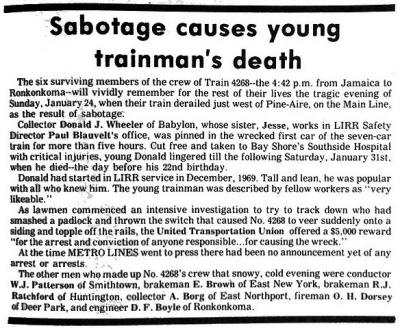 "Sabotage
causes young trainman's death" 01/24/1971 Collection: Al Castelli "Sabotage
causes young trainman's death" 01/24/1971 Collection: Al Castelli
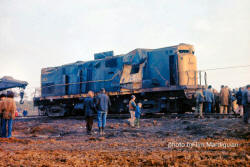
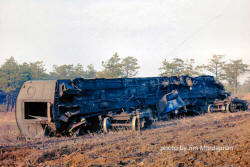
Pine Aire Pilgrim switch derailment of LIRR #201
Photos: 1/25/1971 Jim Mardiguian
|
 The
LIRR's wreck train and crew, under Wreckmaster Jimmy Van Time, worked
through Sunday night, January 24 and Monday morning to rerail a seven
car train after it was derailed by an open switch. The
LIRR's wreck train and crew, under Wreckmaster Jimmy Van Time, worked
through Sunday night, January 24 and Monday morning to rerail a seven
car train after it was derailed by an open switch.
In addition
to LIRR personnel, a small army of firemen from neighboring
communities responded to the emergency remaining through the night
until all passengers and injured had been removed from the wreckage.
There was one
fatality: ticket collector Donald J. Wheeler of North Babylon. LIRR
police joined with Suffolk County authorities to pinpoint the cause of
the derailment. Verdict: Unknown youths deliberately reversed the
switch which caused the train to leave the tracks at the Pilgrim State
Hospital spur.
Long Island
METRO LINES page 7 Photos: Art Huneke Collection: Al Castelli
|
|
This occurred at
the location of the
Pilgrim switch and hospital spur which, at that
time, lead directly off the single-tracked Main Line. As a result of a deadly, vandal-related
derailment that occurred at this location on January 24, 1971, the
old, stone, overgrade crossing of the former private road just to the
west of here was solidly filled in and Pine Aire siding was
installed. Access to the Pilgrim switch was moved from its former,
direct, Main Line location to a point along the new siding, to prevent
this sort of tragedy from happening again. (Dave Keller data)
In
addition, as a result, all of the distant signals between PW and
Ronkonkoma (12 of them, I think) were converted to eliminate their
“caution” aspects for “restricting” aspects. Jeff Erlitz |
1970's
New
Hyde Park - New
Hyde Park Rd Crossing Collision |
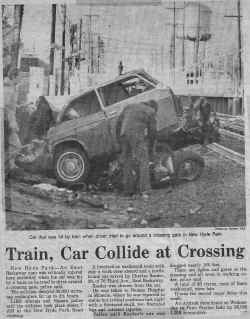 New
Hyde Park Rd in the 1970's - A car went around gates. The article
states '...the second major delay this week..." Might this be
near the July 13, 1973 New Hyde Park Grade Crossing Collision when a
mail truck was struck by a LIRR passenger train in New Hyde Park? -
NEWSDAY photo New
Hyde Park Rd in the 1970's - A car went around gates. The article
states '...the second major delay this week..." Might this be
near the July 13, 1973 New Hyde Park Grade Crossing Collision when a
mail truck was struck by a LIRR passenger train in New Hyde Park? -
NEWSDAY photo |
1970's
Massapequa
Park - Park Blvd. Crossing Collision |
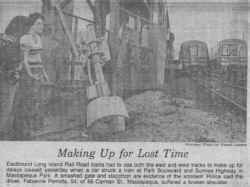 Park Blvd and Sunrise Hwy. - NEWSDAY photo
Park Blvd and Sunrise Hwy. - NEWSDAY photo |
April 5, 1973
Chapel Ave., East
Patchogue Grade Crossing Collision |

Westbound LIRR
passenger train and northbound auto at Chapel Ave., East Patchogue on
Thursday April 5, 1973 at 7:30a.m.
The Long Island Advance
- 4/12/1973 Archive: New
York State Historic Newspapers Project, and Celia M. Hastings Local
History Room, Patchogue-Medford Library. Research: Gary Lutz,
Librarian |
July
13, 1973 New
Hyde Park Grade Crossing Collision |
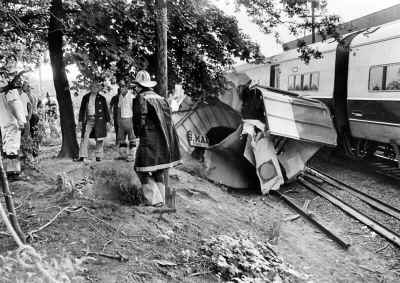 On July 13, 1973, a mail truck was struck by an LIRR passenger train in New Hyde Park. There were conflicting reports as to how and why the truck driver drove through the safety gate, causing the collision with the Huntington-bound train. Five passengers sustained minor injuries, and the truck driver, who was charged with driving while intoxicated, was hospitalized with leg and hip fractures. Here, firefighters inspect the scene of the crash. Photo Credit: Newsday/Karen Wiles On July 13, 1973, a mail truck was struck by an LIRR passenger train in New Hyde Park. There were conflicting reports as to how and why the truck driver drove through the safety gate, causing the collision with the Huntington-bound train. Five passengers sustained minor injuries, and the truck driver, who was charged with driving while intoxicated, was hospitalized with leg and hip fractures. Here, firefighters inspect the scene of the crash. Photo Credit: Newsday/Karen Wiles
|
February 15, 1974
Chapel Ave., East
Patchogue Grade Crossing Collision |
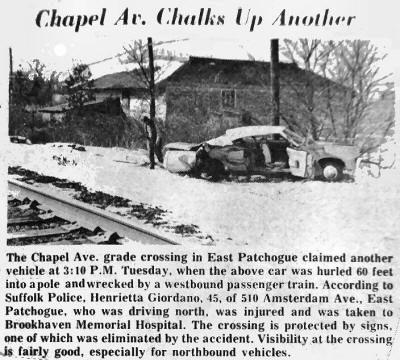 The
Chapel Ave. grade crossing in East Patchogue vehicle accident occurred
at 3:10pm Tuesday. One car was involved with the westbound passenger
train. The driver, traveling north, was injured and taken to
Brookhaven Memorial Hospital. The
Chapel Ave. grade crossing in East Patchogue vehicle accident occurred
at 3:10pm Tuesday. One car was involved with the westbound passenger
train. The driver, traveling north, was injured and taken to
Brookhaven Memorial Hospital.
The crossing is protected by signs, one of which was eliminated by the
accident. Archive:
John Jett
|
March
7, 1975
Chapel Ave., East
Patchogue Grade Crossing Collision |
 The
Chapel Ave. grade crossing in East Patchogue vehicle accident occurred
at 9:20pm Friday 3/07/1975. One northbound car was involved with the
westbound passenger train.
The crossing has no gates or signs. The
Chapel Ave. grade crossing in East Patchogue vehicle accident occurred
at 9:20pm Friday 3/07/1975. One northbound car was involved with the
westbound passenger train.
The crossing has no gates or signs.
The Long
Island Advance - 3/13/1975
Archive: New York State Historic
Newspapers Project, and Celia M. Hastings Local History Room,
Patchogue-Medford Library. Research: Gary Lutz, Librarian |
August
18, 1976
GP38-2 at "AG" Amagansett derails |
 GP38-2
#250 runs aground at "AG" siding View W - Archive: Sheppard C. Webb GP38-2
#250 runs aground at "AG" siding View W - Archive: Sheppard C. Webb

Amagansett LIRR 1966 map
I was the third trick chief that night.
A westbound from Montauk ran through the west switch at AG with the
switch being in the reverse position. Why that was, I don't remember.
This, of course, bent the switch points but had no effect on the
westbound train. No 2 used to run from Jamaica to Montauk at 1:02 AM
arriving at Montauk at 3:56 AM. Although we weren't supposed to know,
the train oftentimes didn't stop at stations unless the crew signaled
the engineer that there was actually a passenger that needed to
detrain. When No 2 got to the west switch AG, it was moving much
faster than it would have, if it had made the stop. When the train hit
the bent points, that caused the derailment. I remember the wreck
train we sent to assist derailed as well and an 80 ton wrecker going
out by road wound up with a number of flat tires and was also delayed.
Info: Train Dispatcher |
May 26, 1977
Derail at Westhampton |
 Photograph
taken of LIRR diesel engine No. 615 and passenger cars after a
derailment in Westhampton on May 26, 1977. Photo: Ziel, Ron -
Collection; Queens Public Library Digital Archive; Restored photo:
Chris Klug Photograph
taken of LIRR diesel engine No. 615 and passenger cars after a
derailment in Westhampton on May 26, 1977. Photo: Ziel, Ron -
Collection; Queens Public Library Digital Archive; Restored photo:
Chris Klug
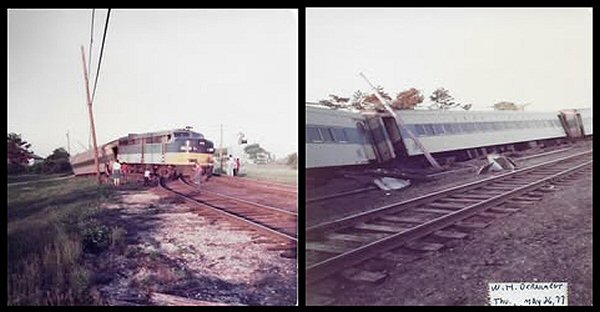
Westhampton Derailment 5/26/1977 Photos/Archive: Patrick Marinaccio |
August
15, 1977 SW1001 #100 at Yardmaster's Office, LI City |
 SW1001 #100 Derailment at Yardmaster's Office,
53rd Ave. under the Pulaski Skyway, LI City View W 8/15/1977
SW1001 #100 Derailment at Yardmaster's Office,
53rd Ave. under the Pulaski Skyway, LI City View W 8/15/1977
Archive: Dave Keller |
March
14, 1982 Herricks Rd., Mineola
Grade Crossing Collision |
 On March 14, 1982, nine teenagers were killed and another was critically injured when a van that went around a closed crossing gate
and was struck by an eastbound LIRR passenger train at Herricks Rd., Mineola
at 4:22 PM. Here, police and firefighters inspect the wreckage of the van. Photo Credit: UPI On March 14, 1982, nine teenagers were killed and another was critically injured when a van that went around a closed crossing gate
and was struck by an eastbound LIRR passenger train at Herricks Rd., Mineola
at 4:22 PM. Here, police and firefighters inspect the wreckage of the van. Photo Credit: UPI
|
August 24, 1984 LIRR
Passenger Derailed at Babylon Station
|
 On Aug. 24, 1984, a westbound LIRR train derailed as it switched tracks at the Babylon station, causing minor injuries to passengers aboard. One of the cars jumped the platform and struck a concrete pillar. Photo Credit: Newsday/Jim Cummins On Aug. 24, 1984, a westbound LIRR train derailed as it switched tracks at the Babylon station, causing minor injuries to passengers aboard. One of the cars jumped the platform and struck a concrete pillar. Photo Credit: Newsday/Jim Cummins

|
 A derailed westbound LIRR train sits in the Babylon station on
Friday Augost 24, 1984. Photo Credit: Newsday/Jim Cummins A derailed westbound LIRR train sits in the Babylon station on
Friday Augost 24, 1984. Photo Credit: Newsday/Jim Cummins
|
 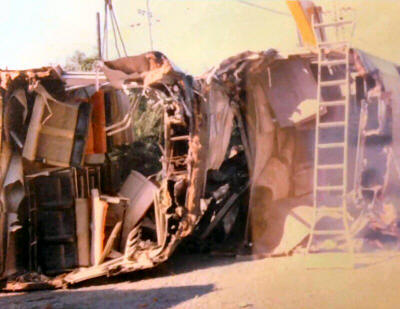 I
was in the high tension dept at the time. After they pushed the wreck
back west with a diesel boys from the Comm Dept and our gang ran
cables from out truck bed winches over the car and drag/rolled it down
the embankment into the parking lot northwest of the station where it
was cut up by the fire department (they wanted the practice) and
hauled away on flatbeds to the bone yard east of Shea stadium where it
resides to this day. It was really cool and an incredible example of
thinking outside the box by the guys in charge of removing it. Info:
Neal Shovlin I
was in the high tension dept at the time. After they pushed the wreck
back west with a diesel boys from the Comm Dept and our gang ran
cables from out truck bed winches over the car and drag/rolled it down
the embankment into the parking lot northwest of the station where it
was cut up by the fire department (they wanted the practice) and
hauled away on flatbeds to the bone yard east of Shea stadium where it
resides to this day. It was really cool and an incredible example of
thinking outside the box by the guys in charge of removing it. Info:
Neal Shovlin
|
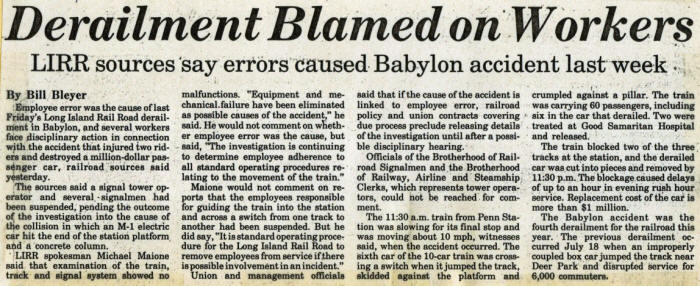 Babylon
derailment - NEWSDAY 5/30/1984 Archive: Dave Morrison Babylon
derailment - NEWSDAY 5/30/1984 Archive: Dave Morrison |
November 24, 1987
Freight Derailed in Deer Park
|
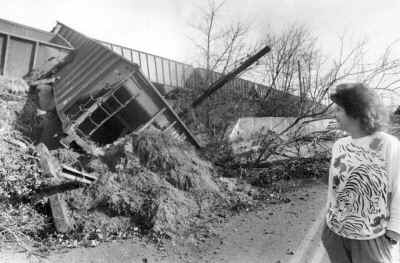 On Nov. 24, 1987, a freight train derailed west of the LIRR station in Deer Park when four freight cars left the track and crashed 25 feet down the embankment. No injuries were reported. Here, Patty Koliner of Copiague, the owner of a pet motel on Long Island Avenue in Deer Park, looks at the aftermath of the derailment, which occurred right in front of her business. Photo Credit: Newsday/Dick Kraus On Nov. 24, 1987, a freight train derailed west of the LIRR station in Deer Park when four freight cars left the track and crashed 25 feet down the embankment. No injuries were reported. Here, Patty Koliner of Copiague, the owner of a pet motel on Long Island Avenue in Deer Park, looks at the aftermath of the derailment, which occurred right in front of her business. Photo Credit: Newsday/Dick Kraus
|
August 26, 1988 LIRR
Passenger Train Crash Huntington, NY
|
 On Aug. 26, 1988, a westbound LIRR train derailed after it struck a flatbed trailer at the Park Avenue crossing in Huntington, injuring 18 people aboard. LIRR officials blamed the crash on the driver of the flatbed, which got stuck straddling the tracks. Photo Credit: Newsday/
Dick Kraus On Aug. 26, 1988, a westbound LIRR train derailed after it struck a flatbed trailer at the Park Avenue crossing in Huntington, injuring 18 people aboard. LIRR officials blamed the crash on the driver of the flatbed, which got stuck straddling the tracks. Photo Credit: Newsday/
Dick Kraus
|
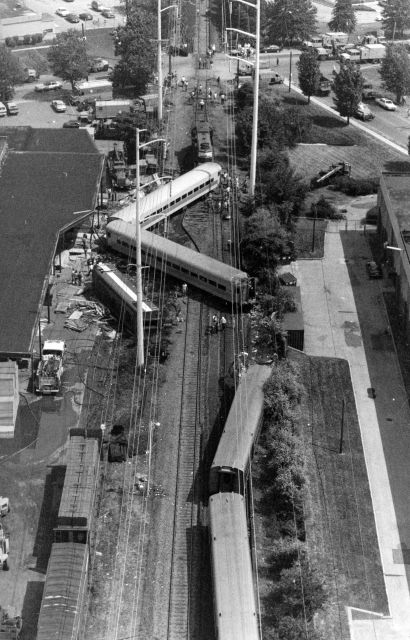 Here, an aerial view of a derailed westbound LIRR train after it struck a flatbed trailer at the Park Avenue crossing in Huntington on Aug. 26, 1988. The derailment, which left 18 people injured, caused an estimated $2.5 million in damage to cars, engines, track, signals and a lumberyard adjacent to the tracks where one of the cars came to rest. Photo Credit: Newsday/
Cliff DeBear Here, an aerial view of a derailed westbound LIRR train after it struck a flatbed trailer at the Park Avenue crossing in Huntington on Aug. 26, 1988. The derailment, which left 18 people injured, caused an estimated $2.5 million in damage to cars, engines, track, signals and a lumberyard adjacent to the tracks where one of the cars came to rest. Photo Credit: Newsday/
Cliff DeBear
|
|

|
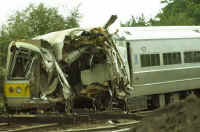
|
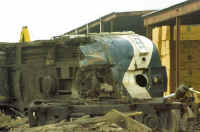
|
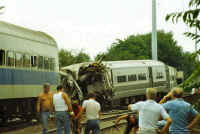
|

|
|
LIRR wreck from grade crossing
accident in Huntington, NY. The Alco power pack LIRR #606 was a
total loss and eventually scrapped after being towed back
to Morris Park. Photos are from Aug 28, 1988 by Al Castelli
|
|
A LIRR westbound
passenger train crashed into a tractor-trailer stuck at a grade crossing in Huntington,
NY, about 8 P.M. Thursday night,
derailing five cars and the locomotive, tearing up
hundreds of feet of track and scattering debris. Eighteen people were
slightly injured in the collision, which occurred about a mile east of
Huntington..
The impact of the crash about one mile east of the Huntington station was so great that it toppled the diesel engine, throwing one railroad car into a lumberyard and another into a parked train on another track.
|
May 2, 1989
Wyandanch Grade Crossing Crash
|
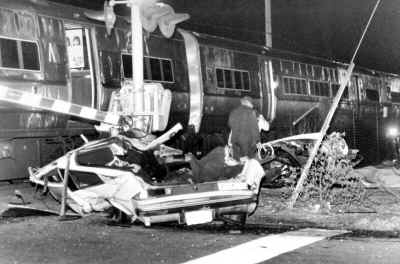 On May 2, 1989, an eastbound LIRR train collided with a car near the Wyandanch station at Straight Path and Long Island Avenue. A 24-year-old passenger in the vehicle was taken to the hospital and treated for cuts and bruises. Photo Credit: Newsday/Dan Neville On May 2, 1989, an eastbound LIRR train collided with a car near the Wyandanch station at Straight Path and Long Island Avenue. A 24-year-old passenger in the vehicle was taken to the hospital and treated for cuts and bruises. Photo Credit: Newsday/Dan Neville
|
January 6, 1990
Willis Ave., Mineola Grade Crossing Crash
|

|
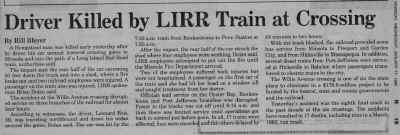
Mineola accident 1/16/1990 Newsday,
page 19 Archive: Dave Morrison
There was a track circuit problem on Track 1 during the AM rush causing the trains to move slowly and bunch up together to the point that the crossing gates remained down; before the crossings could be protected. Train #2015, last stop Bethpage, came up Track 2 at MAS
(maximum authorized speed) and struck the automobile whose driver had lost patience and operated around the downed gates. The accident happened at Willis Avenue and the car was dragged along by the train causing the engine block to be propelled into the building. The train stopped in Mineola station.
The building was a MOW section house used to store material and shelter employees between assignments. My recollection, which may not be correct, is that the building was damaged by the fire, but remained in service. I specifically recall that Ed Wheeler was the Section D train dispatcher and Marian Carbone was the operator at Nassau. Bob Alley, Jr., now retired, was the engineer. Bill Jeffries responded to the scene. Account compliments of: Ray Kenny
|
May 11, 1992 Bellport
Station |
 Per
Newsweek "A Long Island Rail Road train on May 11, 1992, rammed a
truck stuck on the tracks in at the Bellport Station in East Patchogue
with a load of 21 tons of concrete drainage vaults, injuring 16 people
and delaying 1,800 commuters." Per
Newsweek "A Long Island Rail Road train on May 11, 1992, rammed a
truck stuck on the tracks in at the Bellport Station in East Patchogue
with a load of 21 tons of concrete drainage vaults, injuring 16 people
and delaying 1,800 commuters."
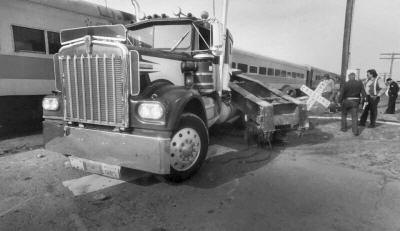 Wreck
at Bellport Station 5/11/1992 Wreck
at Bellport Station 5/11/1992
Archive: Moshe Arzooan |
March
10, 1993 Bellerose Freight Derailment
|
|

Bellerose Freight Derailment Newsday
03/11/1993
"Nine of the 15 cars on the eastbound freight train derailed at about 11:45 a.m." said Michael Charles, a LIRR
spokesman.
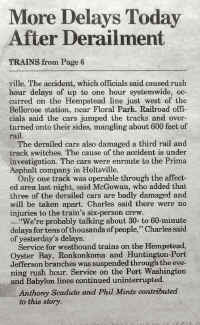
|
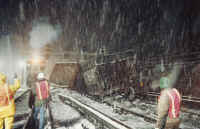
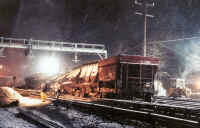

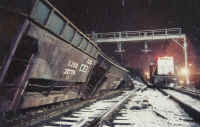
Bellerose Freight Derailment
3/10/1993 - Archive: Scott Niagara
|


Bellerose Freight Derailment Newsday 03/12/1993
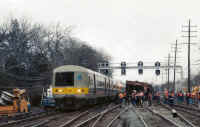
Bellerose Freight Derailment 3/11/1993 - Archive: Scott Niagara
|
December 16, 1995
Westbury - Covert Ave Grade Crossing Crash
|
|
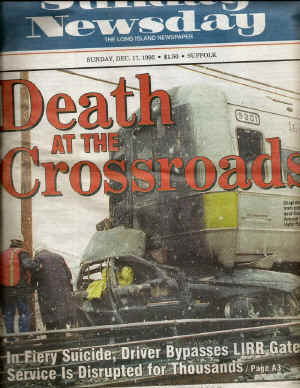
"Death at the
Crossroads" Sunday NEWSDAY front page of Covert Ave., New
Hyde Park suicide crash of 12/16/1995

|

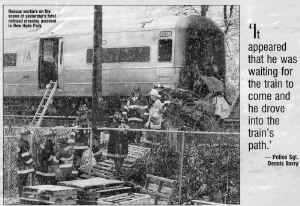
All material courtesy of William
Gilligan
|

|
September 15,
1996 North Lindenhurst Grade Crossing Crash
|
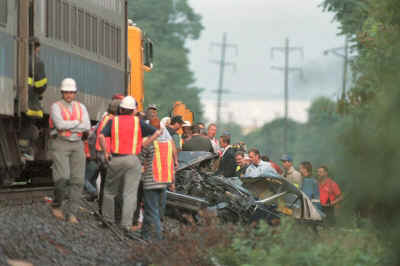 On Sept. 15, 1996, an eastbound LIRR train derailed after it collided with a vehicle at the Wellwood Avenue crossing in North Lindenhurst. The driver of the vehicle was killed. Here, emergency personnel at the scene hours after the fatal crash. Photo Credit: Newsday/Thomas A. Ferrara On Sept. 15, 1996, an eastbound LIRR train derailed after it collided with a vehicle at the Wellwood Avenue crossing in North Lindenhurst. The driver of the vehicle was killed. Here, emergency personnel at the scene hours after the fatal crash. Photo Credit: Newsday/Thomas A. Ferrara
|
November 8,
1996 Derailment near the Great Neck Station
|
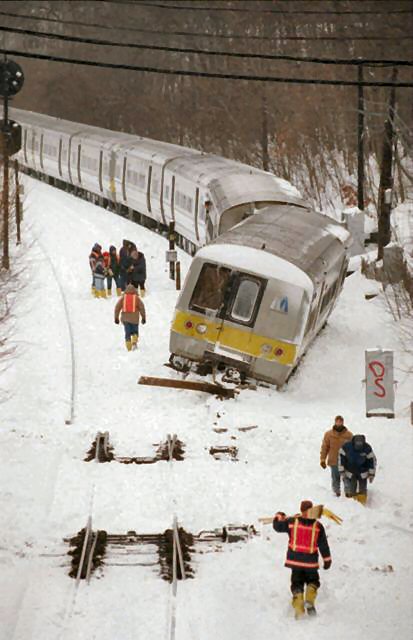 On Nov. 8, 1996, a westbound LIRR train derailed near the Great Neck station. The incident was deemed weather-related. Photo Credit: Newsday / Audrey C. Tiernan On Nov. 8, 1996, a westbound LIRR train derailed near the Great Neck station. The incident was deemed weather-related. Photo Credit: Newsday / Audrey C. Tiernan
|
c. 1/1998
FL9 Morris Park Turntable
|
 |
FL9 #301 dropped the front truck in the
Morris Park turntable after the belly tank bottomed on the end of the
rail on 19 track.
Photo/Archive: Bill Mangahas
|
April 9, 1998
Speonk Yard
|
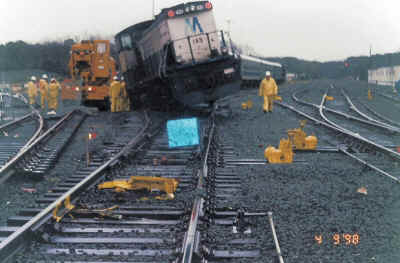 Speonk Yard,
4/09/1998 mid reconstruction into the modern configuration. Archive:
Scott Niagara Speonk Yard,
4/09/1998 mid reconstruction into the modern configuration. Archive:
Scott Niagara
|
March 17, 1999
Glen Street Station - Truck Wreck at Elm St. Crossing
|
|
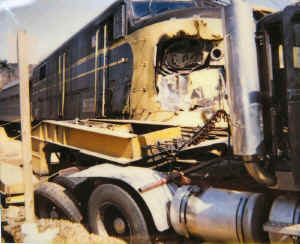
|
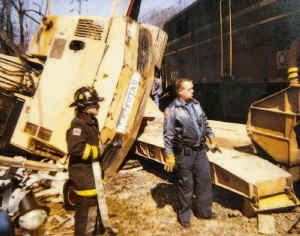
|
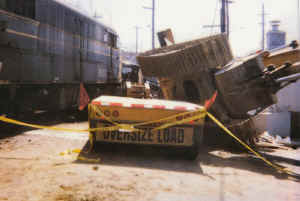
|
|
Wreck at Elm Ave crossing near
Glen St. Station involving LIRR FA #607 westbound and a lowboy truck.
3/17/1999 Archive: Gregory Nelson
|
TRAIN-WRECK MIRACLE – DRIVER ESCAPES AS TRUCK STALLS AT LIRR CROSSING
- NEW YORK POST
By Kieran Crowely March 18, 1999 | 5:00am
I just took one look and jumped for my life. I hadn’t realized how big and powerful . . . it was.” DRIVER COLIN CAMPBELL
A truck driver miraculously escaped death yesterday when a Long Island Rail Road train rammed into his tractor-trailer on a grade crossing in Glen Cove,
L.I. “I just took one look and jumped for my life,” said driver Colin Campbell, 52, of Merrick, L.I. “I hadn’t realized how big and powerful a train it was until I looked out and saw it coming.”
The train, on the Oyster Bay line, was heading into the city with 75 passengers aboard at 9:48 a.m. when the collision occurred at the Elm Avenue crossing, 200 feet east of the Glen Cove station.
The crash came barely a day after a tragic Illinois crossing accident in which an Amtrak train plowed into a truck on the tracks and derailed, killing 11 and injuring scores of others.
NOTE: This is the LIRR Glen Street Station located in Glen Cove,
not the Glen Cove Station.
Things turned out differently in Glen Cove. The train did not derail and nobody was seriously hurt.
“He’s lucky to be alive,” a woman who answered the door at Campbell’s house in Merrick told The Post.
The accident still caused a mess and disrupted service on the Oyster Bay line.
Campbell’s truck was carrying a huge backhoe that toppled over during the accident.
Eyewitnesses said the truck appeared to have stalled or been stuck on the tracks when the crash occurred on the crossing, which is at the top of a hilly street.
The train whistle blew loudly and the brakes screeched as Campbell and witnesses looked on helplessly.
Bob Basile had parked his truck near the crossing, but moved it just before the crash.
“I heard someone yell, ‘There’s a truck stuck on the railroad tracks. Call the cops,'” said the 43-year-old construction worker.
“It was a loud bang. I saw the machine flipping over. It was a lot of rumbling. It was very scary. I’m still shaking – after reading [about the Amtrak crash] this morning.
Basile said Campbell told him he was “stuck on the track” and “didn’t see no gates” at the crossing indicating a train was coming.
But, LIRR spokesman Tom Kelly said the gate and flashing lights at the crossing were working before the crash occurred.
Kelly said the LIRR is investigating whether the truck was overweight and required a permit to cross the tracks. He said there was no record that the owner, LaFata Construction Corp. of Massapequa, L.I., had requested one.
Campbell has at least one driving problem in his past. He was convicted of driving while impaired in 1984, said Glen Cove Mayor Tom
Suozzi. But a LaFata executive defended Campbell.
“He’s an excellent driver,” said Dorothy LaFata. “He was moving an excavator from one site to another. He’s too good a driver to have stalled on the tracks.”
Campbell was treated and released at North Shore University Hospital in Manhasset. He was given medication for a sore back.
 The
Glen Street incident appears to have resulted in lowboy crossing signs
installed warning of this hazard. The
Glen Street incident appears to have resulted in lowboy crossing signs
installed warning of this hazard.
Oyster Bay, west of station c.2000 Photo/Archive: Steven
Lynch:
|
January 24,
2001 Greenlawn Passenger Train Derailment
|
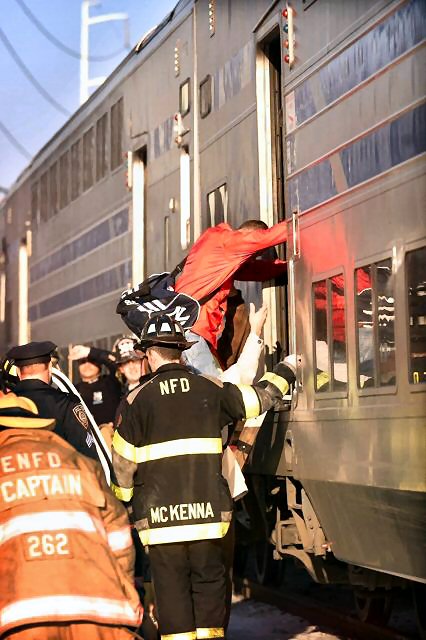 On Jan. 24, 2001, an LIRR train with about 110 people aboard derailed just east of the Stony Hollow Road overpass in Greenlawn. Here, firefighters help passengers get off of the train. Photo Credit: Newsday / John Paraskevas On Jan. 24, 2001, an LIRR train with about 110 people aboard derailed just east of the Stony Hollow Road overpass in Greenlawn. Here, firefighters help passengers get off of the train. Photo Credit: Newsday / John Paraskevas
|
August 6, 2001
Greenlawn Passenger Train Derailment
|
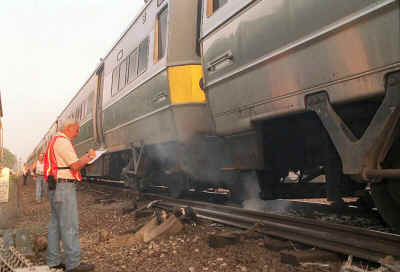 On Aug. 6, 2001, an eastbound LIRR train on the Babylon line derailed on the County Line Road bridge near the Amityville station after a train car struck an object and an electrical fire erupted on the third rail. Photo Credit: Newsday/Joe Turner On Aug. 6, 2001, an eastbound LIRR train on the Babylon line derailed on the County Line Road bridge near the Amityville station after a train car struck an object and an electrical fire erupted on the third rail. Photo Credit: Newsday/Joe Turner
|
August 13,
2001 Syosset Passenger Train Derailment
|
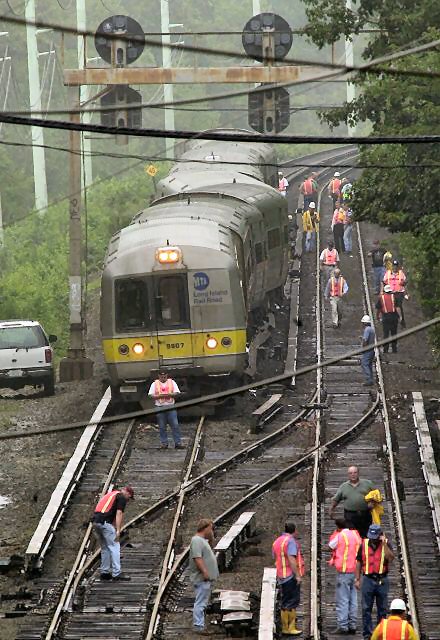 On Aug. 13, 2001, an LIRR passenger train derailed just east of South Woods Road near the Syosset station. Photo Credit: Newsday/Michael E. Ach On Aug. 13, 2001, an LIRR passenger train derailed just east of South Woods Road near the Syosset station. Photo Credit: Newsday/Michael E. Ach
|
February 17,
2003 Port Washington Station Derailment
|
 On Feb. 17, 2003, an LIRR employee looks at a train that derailed at the Port Washington station. Photo Credit: Newsday/Michael E. Ach On Feb. 17, 2003, an LIRR employee looks at a train that derailed at the Port Washington station. Photo Credit: Newsday/Michael E. Ach
|
March 11, 2004
LIRR #160
Runaway Bushwick Branch
 On
March 11, 2004, about 2:18p.m.. the crew of a LIRR train, assigned to
reposition equipment in various locations, left a locomotive (LIRR
#160) unattended with only its air brakes applied. The locomotive was
left on a descending grade in the Fresh Pond yard of the New York
& Atlantic Railway (NYAR) in
Queens
,
NY
. The locomotive rolled away and traveled through the yard and onto
the Bushwick Branch of the NYAR, where it passed over seven passive
grade crossings and struck numerous vehicles before coming to a stop.
Four occupants of three struck vehicles were seriously injures. A fire
occurred when the engine came to a stop, after its collision with the
last two vehicles. The LIRR estimated equipment damages of $83,000,
the NYAR estimated minimal damages. National Transportation
Safety Board On
March 11, 2004, about 2:18p.m.. the crew of a LIRR train, assigned to
reposition equipment in various locations, left a locomotive (LIRR
#160) unattended with only its air brakes applied. The locomotive was
left on a descending grade in the Fresh Pond yard of the New York
& Atlantic Railway (NYAR) in
Queens
,
NY
. The locomotive rolled away and traveled through the yard and onto
the Bushwick Branch of the NYAR, where it passed over seven passive
grade crossings and struck numerous vehicles before coming to a stop.
Four occupants of three struck vehicles were seriously injures. A fire
occurred when the engine came to a stop, after its collision with the
last two vehicles. The LIRR estimated equipment damages of $83,000,
the NYAR estimated minimal damages. National Transportation
Safety Board
March 11, 2004: A driverless, out-of-control
LIRR locomotive roared through several crossings near the
Queens-Brooklyn border yesterday, hitting five vehicles and injuring
four people, two of them critically.
The engine plowed through the cars as they
crossed the tracks at three spots along the little-used Bushwick
branch, leaving behind a path of destruction and burning debris,
officials said.
The engine traveled nearly 1 1/2 miles after
it came loose from two other locomotives at around 2:10 p.m. and
meandered down the freight line during an engine change at the Fresh
Pond Yard behind
Rentar
Plaza
Shopping Center
in
Middle
Village
, officials said.
Mayor Bloomberg said the cause is under
investigation. "Either the brakes weren't set or they
failed," he said. "We don't have an answer as to why."
Bloomberg said the crew working at the yards will be interviewed by
police and tested for alcohol and drugs as part of the investigation.
"The thing we should remember here is that we were lucky,"
said Bloomberg, who toured the crash site with officials from the
Metropolitan Transportation Authority, the state agency that oversees
the LIRR. "This could have been a much worse tragedy. Thank God
it was not."
The runaway engine - traveling about 10 to 15
mph - hit a white car at an ungated crossing at
54th Street
and
Flushing Avenue
in Maspeth at 2:11 p.m., leaving two men critically injured. They were
taken to
Elmhurst
Hospital
and listed last night in critical condition after undergoing surgery.
Demetrius Cuffie, 37, suffered several broken
bones in his upper body and Jason Kusinitz, 33, suffered head and
internal injuries and had to have his spleen removed. "We're all
very nervous and concerned," said Kusinitz's brother Ian.
"It doesn't make sense." Andrew Wigler, Kusinitz's lawyer,
said the family "had no understanding" of how the accident
could have occurred. "It would seem that there should have been
multiple safeguards in place to prevent a happening of this
sort."
Cuffie and Kusinitz are co-workers at a
car-rental agency in Maspeth. Kusinitz's brother David is a cop
assigned to the 109th Precinct in
Queens
. Witnesses said they saw the locomotive slam into the car, debris
flying into the air as the engine rammed it.
"The car was like an accordion,"
said witness Lisa DaVino, 27. "It sounded like a bomb had gone
off." Vincent Grauso, 21, who also saw the accident, said the
locomotive hit the car with such force, it appeared to melt before his
eyes. "It was pretty gory. The car was mangled from top to
bottom," he said. "The men weren't moving at all. It was
really awful."
The black and white locomotive then barreled
into two other cars on
Woodward Avenue
at 2:14 p.m., injuring two others. Meir Mahlab, 72, a retired rabbi,
and Sister Ave Clark, 59, a nun with the Amityville Dominican Order on
Long Island were also taken to
Elmhurst
in stable condition. Mahlab's wife, Linda, said he was unable to tell
her the details of the crash. "He just said, 'My spine, my
spine,' " she said. "He's in a lot of pain, he could hardly
talk."
Seconds after that impact, the locomotive hit
two trucks owned by the
New York
and Atlantic Railway a few blocks away, over the
Brooklyn
border near
Onderdonk Avenue
. The impact sparked a minor fire near some tanks containing acetylene
and oxygen, fire officials said. "I heard a big bang," said
witness Xavier Zevallos, a warehouse manager who was working nearby.
"All I could see was smoke and fire down the tracks."
One of the trucks was parked on the tracks
because workers were doing repairs when the locomotive bore down on
them, officials said. The engine came to a halt moments later, just a
few blocks away at the end of the line when part of the truck got
wedged under it, officials said. The Fire Department said no one was
injured in that crash. Firefighters had the blaze under control at
3:08 p.m., officials said.
The locomotive was still running when FDNY
Lt. William Pickett, who was at the scene to help those injured in the
crash, jumped aboard. "The truck was still burning," he
said. "That's when I climbed into the back of the train and into
the engineer's compartment and applied the brake."
Residents of the area near the last crash
said trains usually come through the crossing very slowly, its horn
blowing, and often with a crew member standing outside. There are no
gates, lights or bells at the crossing, but there are warning yellow
signs.
Alex Ginsburg, Doug Montero and Clemente Lisi
Courtesy of:
New York
Post
By Nicholas Hirshon
DAILY NEWS Writer Wednesday, December 5th 2007, 4:00 AM
WRECK 03/04/2004
Scattered wreckage was tossed after a LIRR locomotive smashed into
cars and trucks in Ridgewood in March 2004.
Nearly four years after a runaway train incident injured four
people, freight railroad tracks through Queens and Brooklyn are set
to undergo a year-long series of safety changes.
A new state report unveiled last week includes a policy requiring
trains to stop and wait for crews to flag them through crossings
along the seldom-used Long Island Rail Road branch where the
out-of-control locomotive accident occurred in Ridgewood in March
2004.
The order also calls for more X-shaped signage - known as crossbucks
- as well as yield signs and pavement markings at crossings
throughout the two boroughs.
Skip Carrier, a state Transportation Department spokesman, said the
long-awaited changes were the result of a "full, thorough
hearing process." But locals affected by the 2004 accident wondered why officials
didn't push for any crossing gates.
"I'm afraid what they're doing there is just putting up new
signs - and to me, signs at that area don't mean anything,"
said Sister Ave Clark, 63, who was hurt when the train hit her car
at 15 mph.
Because the crew failed to secure the unmanned freight train, the
120-ton locomotive chugged without warning along tracks leased by
the LIRR to New York and Atlantic Railway. That was moments after the train crashed at 55th St. into a car
carrying Jason Kusinitz, now 36, who was put in a medically induced
coma and still undergoes mental and physical therapy.
His older brother, Adam, panned the state hearings into the incident
as a "dog and pony show." Residents at a July meeting
asked for crossing gates, but transportation officials rejected the
request. "I don't see how they can come up with any logical explanation
to not have gate crossings," Adam Kusinitz said. "If
something was manned or unmanned coming down the tracks, the gate
would prevent another tragedy."
Queens Borough President Helen Marshall, who supports more signage
along the tracks, is still "not certain that's enough" to
make them safe, her spokesman Dan Andrews said. The 20-page report also asks for the city and state to mull the
installation of overhead LED lights at two crossings: Morgan and
Metropolitan Aves. in Brooklyn and 56th St. and Flushing Ave. West
in Queens. If officials agree to install LED lights, they must be operational
within a year. If not, the overhead signs will include flashing red
lights instead.
Long Island Rail Road track in Ridgewood to
undergo safety changes
ALEX GINSBURG, DOUG
MONTERO and CLEMENTE LISI
Courtesy of
New York
Post
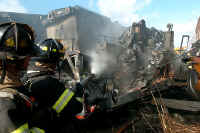 March 11, 2004 -- A
driverless, out-of-control LIRR locomotive roared through several
crossings near the Queens-Brooklyn border yesterday, hitting five
vehicles and injuring four people, two of them critically. March 11, 2004 -- A
driverless, out-of-control LIRR locomotive roared through several
crossings near the Queens-Brooklyn border yesterday, hitting five
vehicles and injuring four people, two of them critically.
The engine plowed through
the cars as they crossed the tracks at three spots along the
little-used Bushwick branch, leaving behind a path of destruction
and burning debris, officials said.
The engine traveled
nearly 1 1/2 miles after it came loose from two other locomotives at
around 2:10 p.m. and meandered down the freight line during an
engine change at the Fresh Pond Yard behind
Rentar
Plaza
Shopping Center
in
Middle
Village
, officials said.
Mayor Bloomberg said the
cause is under investigation. "Either the brakes weren't set or
they failed," he said. "We don't have an answer as to
why." Bloomberg said the crew working at the yards will be
interviewed by police and tested for alcohol and drugs as part of
the investigation. "The thing we should remember here is that
we were lucky," said Bloomberg, who toured the crash site with
officials from the Metropolitan Transportation Authority, the state
agency that oversees the LIRR. "This could have been a much
worse tragedy. Thank God it was not."
The runaway engine -
traveling about 10 to 15 mph - hit a white car at an ungated
crossing at
54th Street
and
Flushing Avenue
in Maspeth at 2:11 p.m., leaving two men critically injured. They
were taken to
Elmhurst
Hospital
and listed last night in critical condition after undergoing
surgery.
Demetrius Cuffie, 37,
suffered several broken bones in his upper body and Jason Kusinitz,
33, suffered head and internal injuries and had to have his spleen
removed. "We're all very nervous and concerned," said
Kusinitz's brother Ian. "It doesn't make sense."
Andrew Wigler, Kusinitz's
lawyer, said the family "had no understanding" of how the
accident could have occurred. "It would seem that there should
have been multiple safeguards in place to prevent a happening of
this sort."
Cuffie and Kusinitz are
co-workers at a car-rental agency in Maspeth. Kusinitz's brother
David is a cop assigned to the 109th Precinct in
Queens
.
Witnesses said they saw
the locomotive slam into the car, debris flying into the air as the
engine rammed it. "The car was like an accordion," said
witness Lisa DaVino, 27. "It sounded like a bomb had gone
off."
Vincent Grauso, 21, who
also saw the accident, said the locomotive hit the car with such
force, it appeared to melt before his eyes. "It was pretty
gory. The car was mangled from top to bottom," he said.
"The men weren't moving at all. It was really awful."
The black and white
locomotive then barreled into two other cars on
Woodward Avenue
at 2:14 p.m., injuring two others.
Meir Mahlab, 72, a
retired rabbi, and Sister Ave Clark, 59, a nun with the Amityville
Dominican Order on Long Island were also taken to
Elmhurst
in stable condition.
Mahlab's wife, Linda,
said he was unable to tell her the details of the crash. "He
just said, 'My spine, my spine,' " she said. "He's in a
lot of pain, he could hardly talk."
Seconds after that
impact, the locomotive hit two trucks owned by the
New York
and Atlantic Railway a few blocks away, over the
Brooklyn
border near
Onderdonk Avenue
.
The impact sparked a
minor fire near some tanks containing acetylene and oxygen, fire
officials said. "I heard a big bang," said witness Xavier
Zevallos, a warehouse manager who was working nearby. "All I
could see was smoke and fire down the tracks."
One of the trucks was
parked on the tracks because workers were doing repairs when the
locomotive bore down on them, officials said. The engine came to a
halt moments later, just a few blocks away at the end of the line
when part of the truck got wedged under it, officials said.
The Fire Department said
no one was injured in that crash. Firefighters had the blaze under
control at 3:08 p.m., officials said.
|
April 12, 2004 LI City
Derailment
|
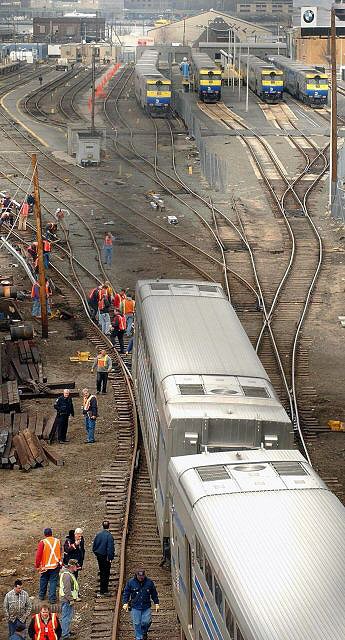 On April 12, 2004, workers and investigators at the scene after an LIRR train derailed near the Long Island City Passenger Yard in Queens. Photo Credit: Jason DeCrow On April 12, 2004, workers and investigators at the scene after an LIRR train derailed near the Long Island City Passenger Yard in Queens. Photo Credit: Jason DeCrow
|
July 6, 2006
Empty Car Derailed
|
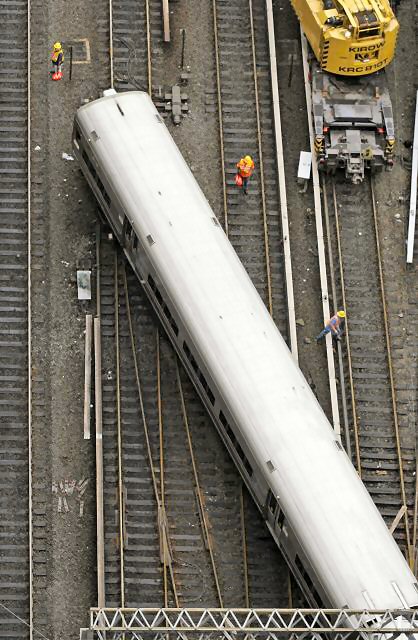 On July 6, 2006, an empty LIRR car derailed outside a tunnel leading to Penn Station. The car, with no passengers, came off the tracks around 2:30 a.m. and caused delays of up to 30 minutes on parts of the LIRR system. Photo Credit: AP/Aaron Jackson On July 6, 2006, an empty LIRR car derailed outside a tunnel leading to Penn Station. The car, with no passengers, came off the tracks around 2:30 a.m. and caused delays of up to 30 minutes on parts of the LIRR system. Photo Credit: AP/Aaron Jackson
|
January 8, 2008
Edgewood Freight Derailment
|
 On Jan. 8, 2008, a freight train derailed on the westbound tracks at Pine Aire Drive in Edgewood, dumping construction material out of the train. No injuries were reported. Photo Credit: James Carbone On Jan. 8, 2008, a freight train derailed on the westbound tracks at Pine Aire Drive in Edgewood, dumping construction material out of the train. No injuries were reported. Photo Credit: James Carbone
|
March 27, 2008 LIRR
PASSENGER TRAINS at JAMAICA
|
|

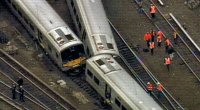
|
LIRR Train # 714 (9:35am Flatbush Ave-Hempstead) and
LIRR Train #1618 (9:34am NYPenn-Huntington).
The last two cars of the 9:35am AM FBA train derailed when arriving at
Jamaica. Cars # 7627-28 The two trains collided between tracks 7 and 8.
They collided with unoccupied cars of the 9:34am NYP train. Cars #7773-74
LIRR indicates the Huntington train was already in the station and the
Hempstead train was just pulling in and didn't cross over the tracks onto
track 8 properly, when the derailment occurred. The rear 2 cars derailed
and collided with the Huntington train on track 7. WWOR TV reports 20
minor injuries.
|
November 23, 2008
Eastbound Passenger Train Derailment at Jamaica
|
 On Nov. 24, 2008, LIRR employees look at an eastbound passenger train that derailed at the Jamaica station a day earlier. The rear three cars derailed, with one car jackknifing over three separate tracks, the railroad said. No passengers were injured. Photo Credit: Charles Eckert On Nov. 24, 2008, LIRR employees look at an eastbound passenger train that derailed at the Jamaica station a day earlier. The rear three cars derailed, with one car jackknifing over three separate tracks, the railroad said. No passengers were injured. Photo Credit: Charles Eckert
|
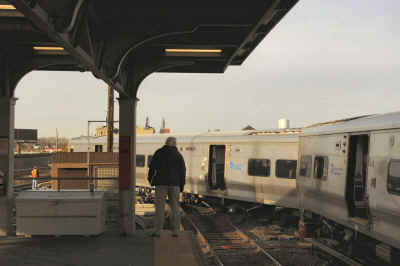 On Nov. 24, 2008, LIRR employees work to remove a jackknifed car at the Jamaica station. The rear three cars of an eastbound train derailed a day earlier, with one car jackknifing over three separate tracks, the railroad said. No passengers were injured. Photo Credit: Charles Eckert On Nov. 24, 2008, LIRR employees work to remove a jackknifed car at the Jamaica station. The rear three cars of an eastbound train derailed a day earlier, with one car jackknifing over three separate tracks, the railroad said. No passengers were injured. Photo Credit: Charles Eckert
|
May 2, 2009
Carleton Avenue, Central Islip - 1 dead.
|
February 14,
2009 Robbins Lane, Syosset. - 1 dead.
|
May 17, 2011
Deer Park - 1 dead. The May 17th, 2011 incident was at Executive Drive when a bakery truck driver tried to go around the gates. That hit was so hard, the train launched the truck 10 feet in the air. Executive Drive has to be the most hazardous on the Ronkonkoma Branch even
when there is no train involved. Several 18-wheelers have gotten stuck on the barriers/tracks, the signals have almost been pulverized, train/vehicle collisions etc. Matthew Kobel
|
August 8, 2011 Great
Neck - Two Train Collision
|
 Officials stand on the platform at the Great Neck LIRR station where two eastbound trains collided and derailed on August 8, 2011. A slow-moving eastbound train with no passengers "bumped" a stationary train also with no passengers at Great Neck about 7 a.m. No one was hurt. Photo Credit: Howard Schnapp Officials stand on the platform at the Great Neck LIRR station where two eastbound trains collided and derailed on August 8, 2011. A slow-moving eastbound train with no passengers "bumped" a stationary train also with no passengers at Great Neck about 7 a.m. No one was hurt. Photo Credit: Howard Schnapp
|
June 11, 2012
Near Route 111, Islip - 1 dead.
|
October 10, 2012
LI City Derailment
|
 On Oct. 10,
2012 Police stand near a disabled LIRR passenger sitting on the tracks after it derailed in Long Island City. Photo Credit: Craig Ruttle On Oct. 10,
2012 Police stand near a disabled LIRR passenger sitting on the tracks after it derailed in Long Island City. Photo Credit: Craig Ruttle
|
January 22,
2013 2nd Street in Brentwood - 2 dead
|
May 10, 2013
Near Brentwood - 1 dead.
|
June 4, 2013 Two
Work Trains Collide in Westbury
|
 On June 4, 2013, two LIRR work trains collided in Westbury, injuring five employees and causing one of the trains to derail. Here, rescue workers use a stretcher to remove one of the injured workers from the crash scene. On June 4, 2013, two LIRR work trains collided in Westbury, injuring five employees and causing one of the trains to derail. Here, rescue workers use a stretcher to remove one of the injured workers from the crash scene.
Photo Credit: Joseph C. Sperber Archive: Newsday
|
June 17, 2013
Eastbound Train from NY PENN Derailment
|
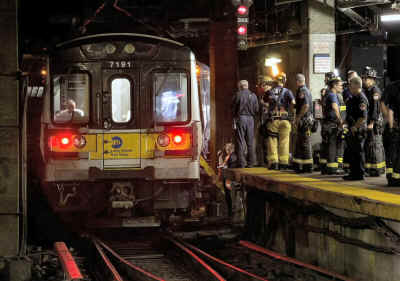 A 10-car Hempstead-bound train derailed just after leaving the Penn Station platform on track 14 on June 17, 2013. The accident caused massive rush hour delays, and forced the evacuation of about 800 people from the train. There were no injuries. Photo Credit: Newsday/Craig Ruttle A 10-car Hempstead-bound train derailed just after leaving the Penn Station platform on track 14 on June 17, 2013. The accident caused massive rush hour delays, and forced the evacuation of about 800 people from the train. There were no injuries. Photo Credit: Newsday/Craig Ruttle
|
March 10, 2014
A Metro-North Railroad electrician is fatally struck by a northbound train near milepost 3.2 at Control Point 3 interlocking in Manhattan. The electrician was one of three employees attempting to re-energize tracks that had been out of service for maintenance.
|
February 3,
2015 Six people are killed after a Metro-North commuter train strikes a sport utility vehicle in Valhalla that was stopped on the tracks.
|
March 30, 2015
Wyandanch Turnout Derailment at MP34.5
|
|
The freight car damaged in the
incident is property of the New York and Atlantic Railway and was
carrying a full load of lumber when it derailed on a passing siding
just west of 18th St. at MP34.5. The derailed car came to rest on its
side and in a location that made it impossible to re-rail without
first off-loading the lumber. LIRR workers cut away security fencing
made of high-gauge steel, enabling NY&A to bring in the machinery
needed to remove the lumber Monday night.
The LIRR then assisted NY&A
in removing the damaged freight car, cutting it into pieces rather
than trying to re-rail it, and discovered the full extent of the
damage done to its communications infrastructure. The derailed car had
knocked down a utility pole, sliced through wires and cables and
crushed signal machinery.
|
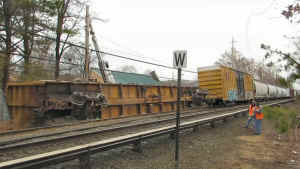
NYA RS80 Wyandanch view NE 3/30/2015
Photo: James Carbone
|

NYA RS80 Wyandanch view E 3/30/2015
Photo: James Carbone
|

Wyandanch view SW 3/30/2015 2000 gallons of
diesel fuel, derailed cut fuel tank, large fuel spill 500+ gallons
diesel on the ground.
|
May 12, 2015
Eight passengers are killed and more than 200 others transported to area hospitals after a Northbound Amtrak train derails near Philadelphia, Pa
|
July 17, 2015
Eastbound/Westbound Passenger Trains Collide at HALL Interlocking
|
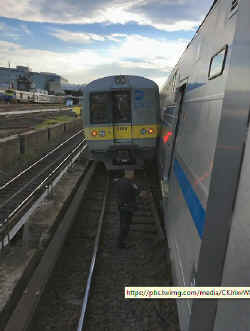
|
Two LIRR trains collided with
each other east of Jamaica Friday night. Around 6:00p on Friday night,
the lead car of an eastbound Huntington train collided with the
leading locomotive of a westbound Montauk train in HALL interlocking
just east of Jamaica. Newsday articles: 7/18-19/2015
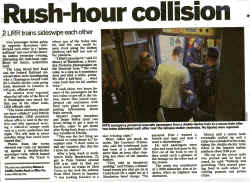

|
September 15,
2015 Derailed freight car in Westbury
|
 On Sept. 15, 2015, repair crews work on clearing a derailed freight car from the LIRR tracks in Westbury. Photo Credit: Howard Schnapp
Archive: Newsday On Sept. 15, 2015, repair crews work on clearing a derailed freight car from the LIRR tracks in Westbury. Photo Credit: Howard Schnapp
Archive: Newsday
HICKSVILLE (WABC) -- By Kristin
Thorne Tuesday, September 15, 2015 8:20PM
Two cars out of a 16-car freight train derailed west of Hicksville on
Tuesday, officials tell Eyewitness News. The freight train is operated
by New York and Atlantic. No injuries were reported. It is unclear
what caused the cars carrying construction materials to derail. One
track was taken out of service. Emergency crews planned to bring in a
crane to remove the train from the tracks, then inspect the 100 foot
section of track that was damaged.
Normal Long Island Rail Road
service has resumed westbound. Service was suspended due to a freight
train derailment west of Hicksville. Even though service has resumed,
LIRR customers were advised that some residual delays were possible.
[West of Wantagh Pkwy overpass, MP23: Steven Lynch]
YA train configured with power
at the west end, loaded construction debris cars at the head, followed
by empty aggregate hoppers, followed by about 5 more loaded C/D cars.
The last two cars were on the ground, with the first upright and still
attached to the end of the train, and the last tipped northwards off
it's trucks, with the trucks right in the vicinity of Divide 1-21
crossover. LIRR had an almost inconceivably high number of people on
the ground. Very quick response. Dave Barraza
|
March 22, 2016: Elijahs Lane in Mattituck - 1 dead.
|
October 8, 2016
New Hyde Park eastbound collision with MOW Train
|
 On Oct. 8, 2016, an eastbound Huntington train derailed just east of New Hyde Park after it struck a work train that errantly veered onto the same track. Officials said the accident, which injured 33 people, was caused by a track switch left in the wrong position. Photo Credit: Howard Schnapp
Archive: Newsday On Oct. 8, 2016, an eastbound Huntington train derailed just east of New Hyde Park after it struck a work train that errantly veered onto the same track. Officials said the accident, which injured 33 people, was caused by a track switch left in the wrong position. Photo Credit: Howard Schnapp
Archive: Newsday
|
November 6, 2016
Eastbound Passenger Train crash in Central Islip
|
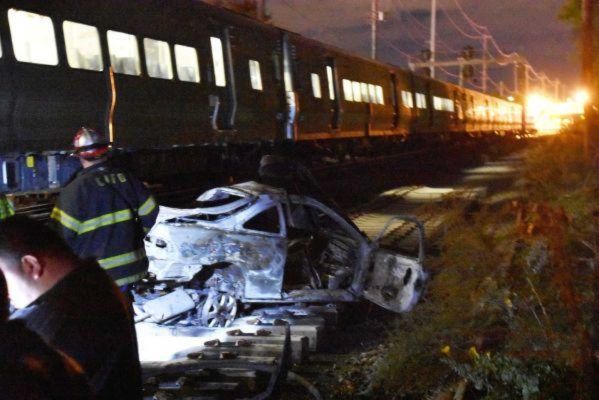 Eastbound
from Penn, NY crash with auto west of Carlton Ave., Central
Islip 11/06/2016 Eastbound
from Penn, NY crash with auto west of Carlton Ave., Central
Islip 11/06/2016
|
January 4, 2017
Atlantic Terminal (Flatbush) Passenger Train crash into Bumping Block
|
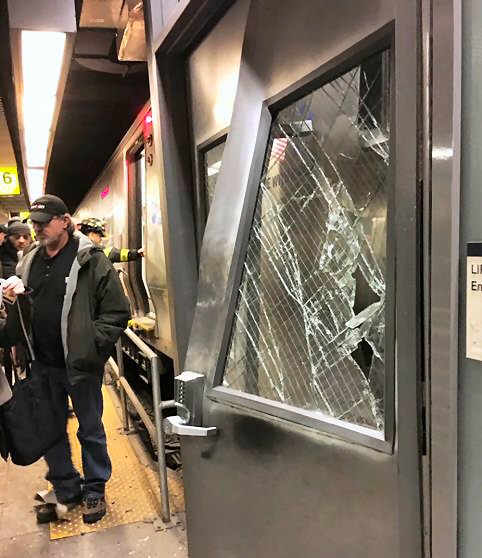 On Jan. 4, 2017, more than 100 people were injured when a Brooklyn-bound LIRR train crashed through a bumping block at the end of the tracks at Atlantic Terminal. On Jan. 4, 2017, more than 100 people were injured when a Brooklyn-bound LIRR train crashed through a bumping block at the end of the tracks at Atlantic Terminal.
Photo Credit: AP/Aaron D. Neufeld
|
January 9,
2017 A motorist from Holtsville is killed when she swerves her car around a down crossing gate arm as a
non-passenger Long Island Rail Road train approaches near Brentwood. - 1 dead
|
September 18,
2017 Deer Park Crash
with Truck that drove around Crossing
Gates
|
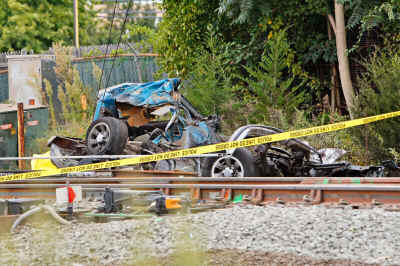 New York Post: Man killed after driving into path of speeding LIRR train New York Post: Man killed after driving into path of speeding LIRR train
A 94-year-old man was killed when he drove around a road barrier and flashing lights into the path of a Long Island Rail Road train on Monday afternoon, sources say.
The LIRR train was coming from Penn Station and headed east toward Ronkonkoma when it crashed into the truck on the tracks at Deer Park at about 12:45 p.m, said MTA spokesman Aaron Donovan.
The crash caused the truck to go up in flames, said sources. The train was able to continue on its journey after a delay of about two hours. No one on the train was injured in the crash.
|
March, 3, 2018
Northport - 1 dead.
|
February 26, 2019
Westbury - School Street Passenger Train Crash
|
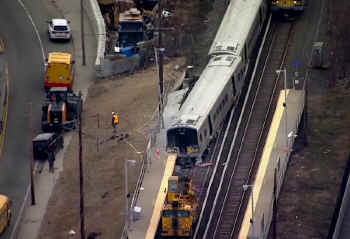
Westbury - Aerial view W 2/26/2019
Archive: Newsday
|

Westbury - Vehicle crash remains
2/26/2019
Photo: Edmund J. Coppa/NY Post
|

Westbury - View W 2/26/2019 Archive: Newsday
It appears to be significant damage to the east end of Platform A at Westbury.
The derailed M7 cars were 7425-7426.
|
Vehicle hit by LIRR trains was
driving away from previous crash, witness told police
By Newsday Staff Updated February 27, 2019 8:09 PM
This story was reported by John Asbury, Robert Brodsky, Alfonso A. Castillo, Matthew Chayes, Stefanie Dazio, Deon J. Hampton, Antonio Planas, David M. Schwartz and Rachel Uda. It was written by Brodsky and Castillo.
The driver of a vehicle that caused a horrific Long Island Rail Road crash Tuesday evening, killing all three occupants, had fled the scene of a crash seconds before attempting to go around a railroad gate in Westbury and colliding with two trains, a witness told law enforcement at the scene.
The vehicle, heading south on School Street around 7:20 p.m., had just been in a minor auto accident before fleeing the scene and being struck by a slow-moving eastbound train, Ryder said. The car then “spun out” and was hit again by a westbound train moving at “full” speed, Ryder said, relaying information from the driver of the other vehicle involved in the auto accident.
"The witness said that individual was involved in an accident and then went around the gate,” Ryder said.
The vehicle was struck first by eastbound LIRR train No. 1260, carrying about 200 passengers, which left Penn Station at 6:35 p.m., with a final destination in Hicksville. Only seconds after the collision, the same vehicle was struck by westbound LIRR train No. 2605 carrying about 800 passengers, which left Ronkonkoma at 6:36 p.m. heading for Penn Station.
The vehicle was “sandwiched” between the trains and erupted into a fireball, killing its occupants, Ryder said. After the collision, the westbound train derailed and traveled about 800 feet before crashing into the concrete platform at the Westbury station, sending chunks of concrete into the air.
How the crash unfolded:
Eastbound 6:35 p.m. train leaves Penn Station with a final destination of Hicksville.
Westbound 6:36 p.m. train leaves Ronkonkoma.
About 7:20 p.m., vehicle is involved in minor car accident on School Street, a witness tells police.
Moments later, vehicle heads south to the School Street crossing, east of the Westbury train station, and goes around gate and flashing lights
Eastbound train leaving Westbury station hits vehicle in crossing, pushing it into path of oncoming westbound train
Seconds later westbound train hits vehicle
Vehicle trapped between trains, bursts into flames
Westbound train derails and crashes into concrete platform on north side of station.
On board
the train: 'Everything came to a stop'
Newsday's Craig Schneider tells what it was like to be on
the LIRR train that crashed.
When the train hit the car, it snapped me back to reality. I had boarded the train at the Farmingdale station to go home to Manhattan. I wasn't paying much attention to anything. I took a seat in the third or fourth car back from the front of the train. I felt the impact. The train car started wobbling, then rocking.
It’s probably nothing serious, I thought. The impact felt like, maybe, the engineer had hit the brakes too hard. The flames flaring up outside changed my mind. A young woman sitting across from me screamed when she saw the fire only a few feet away from her window. The train veered to the right. I thought the train was going out of control, that we had derailed. I tucked my head down toward my knees, the way a flight attendant tells you to do in a plane crash. The train was still grinding its way along, slowing. It was dark outside, so I couldn’t see much. I was judging things pretty much by sense and sound. Then everything came to a stop. Silence. It was me and maybe two or three dozen people in the train car. A mom with two little kids. Two 20-something women. A woman dressed like she was coming from work. Some folks had suitcases. Nobody said anything for what seemed like a long time. I looked at the guy across from me, who I found out later was the husband of the woman who screamed. He looked at me and raised his eyebrows as if to say, "What just happened?" After the train hit the car, it rammed into a concrete platform at the station. I didn’t even know where we were. All of a sudden, an LIRR guy came hurrying into our car. He had a cellphone in his hand. He was staring at it, as if waiting for a call or waiting for his call to go through. “Don’t go anywhere,” he told us as he rushed up the aisle. I looked out the door, that somehow somebody had opened, and saw chunks of concrete from the platform on a grassy embankment. I thought how hard it was going to be to get people down that steep embankment. The people in my car started huddling together, trying to figure out what happened and what to do next. I could see the fire trucks and ambulances pulling up to the street. They kept coming and coming. I called my wife to tell her what happened, and that I was OK.
Emergency workers came rushing through our car, asking over and over and again whether anyone was hurt. The mother was in her seat, holding her two kids in her arms. They started whimpering. The emergency workers propped up a ladder to the door of the train car. Somebody said something about getting the kids out first, and the mom nervously handed her two kids, one by one, to the emergency workers who eased them down the ladder. I was supposed to go next down the ladder, but I wanted to stay on the train so I could take photos and talk to people. I told the first responders that, and a cop had a few choice words for me: “I’m sick of your [expletive]. Get down the ladder.”
It must have been a half-dozen steps or so. When I finally stepped on the ground, it was nothing but red-and-white flashing lights and earsplitting sirens. It was, of course, freezing cold outside, the kind of cold that bites into your bones and doesn’t let go for a long time. I felt bad for all the passengers standing in the cold, waiting for some way to get home. The authorities crammed about 30 of us into an indoor taxi stand. I took an Uber all the way into the city. And when I came through the door, I hugged my wife.
|
May 8, 2019
Farmingdale - Tractor-trailer at Merrits Rd.
|
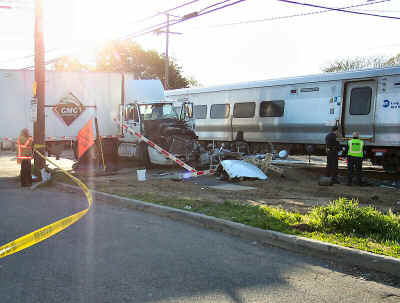 At 5:40 PM Wednesday an M7 hit a tractor-trailer, destroyed a gate at the Merrits Rd. crossing in Farmingdale. At 5:40 PM Wednesday an M7 hit a tractor-trailer, destroyed a gate at the Merrits Rd. crossing in Farmingdale.
Photo/Archive: Bill Mangahas
|
May 25, 2019
Speonk - Cannonball and a LIRR MOW train
|
 3:16am
Cannonball engine #511 sideswiped a LIRR MOW train, with a large fuel spill and derailment of both
trains, during a passing maneuver. 3:16am
Cannonball engine #511 sideswiped a LIRR MOW train, with a large fuel spill and derailment of both
trains, during a passing maneuver.
The unofficial story is:
the Cannonball and the eastbound were to perform a see-saw move at the
Speonk passing siding. The Cannonball was 14 units long, the
siding holds 13. After its Speonk stop, the Eastbound was given a
highball signal and moved out catching the trailing locomotive of the
Cannonball. Claims of new technology failures are being
reported, (i.e. the new computerized signal system screwed up with the
wrong aspect.)
The engineer of the
Cannonball, not realizing his trailing unit was on the ground took HIS
highball and dragged the sideways loco close to half a mile west,
fouling the grade crossing before losing an air hose and going into
emergency. Initial estimates of over one million dollars damage have
been overheard!
In the early hours of Saturday morning over Memorial Day Weekend in
2019, train 8700 (the 1:09a train from Jamaica to Montauk) carrying 32
passengers collided with a non-passenger equipment train 5785 (the
equipment of the Cannonball train, returning empty from Montauk back
to Jamaica), causing both trains to derail. No injuries were reported,
but the incident destroyed hundreds of feet of track, caused
significant damage to both trains, and resulted in significant service
impacts for nearly 48 hours over the course of a busy holiday weekend.
Train 5785 was the return equipment of the Cannonball from the prior
night, the railroad's longest scheduled passenger train at 14 units
long (2 locomotives and 12 C-3 cars). It was waiting on the SK Freight
Track siding just east of Speonk station for train 8700 to pass—but
given that the siding is only 13 cars long, the rear locomotive fouled
the siding's east switch. A report issued by the Federal Railroad
Administration following the derailment pointed towards a loss of
shunt on a track circuit as the primary cause of the incident. This
falsely gave train 8700 a clear signal, and as it accelerated out of
Speonk station, it collided with the east locomotive dangling off the
end of the siding, causing portions of both trains to derail.
12/19/2023 08:30:00 PM by The LIRR Today |
|

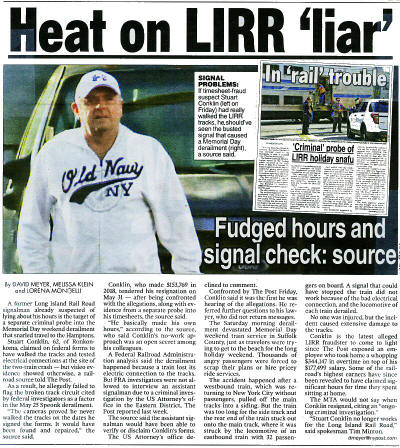
Further
details emerge via the NY Post 10/27/2019
Speonk Accident NY Post 11/03/2019 Archive: Dave Morrison |
June 14, 2019
Mastic - Jeep and a LIRR Non-passenger train |
 LIRR
Train Crashes Into Jeep; Service Impacted LIRR
Train Crashes Into Jeep; Service Impacted
By Lisa Finn, Patch Staff Jun 14, 2019 8:27 pm ET |
Updated Jun 14, 2019 9:42 pm ET
MASTIC, NY - A Long Island Rail Road train slammed into a Jeep in
Mastic Friday night. Suffolk County Police said Mastic Road in Mastic
was closed in both directions between Mastic Boulevard and Patchogue
Avenue after the report of a crash.
According to a LIRR media representative, train service on the LIRR
Montauk Branch was temporarily suspended east of Mastic Shirley after
a non-passenger train struck an unauthorized vehicle on the tracks
east of the station.
Photo: Fully Involved Media Group LLC
|
|
|
August 19, 2019
East Rockaway - Car and LIRR empty passenger train |
 A
car had been struck by a Westbound LIRR train and pushed 100 yards
down the track with an occupant trapped inside the vehicle. It
happened after 3:30 p.m. at the down crossing gates at Forest and
Rocklyn avenues in East Rockaway. A
car had been struck by a Westbound LIRR train and pushed 100 yards
down the track with an occupant trapped inside the vehicle. It
happened after 3:30 p.m. at the down crossing gates at Forest and
Rocklyn avenues in East Rockaway.
The train did not have any passengers on board and witnesses say it
was traveling at a slow speed.
Rocklyn Avenue, East Rockaway 8/19/2019
Photo: Eat Rockaway Fire Department |
November 22, 2019
Jamaica Station - Eastbound passenger train derailment |
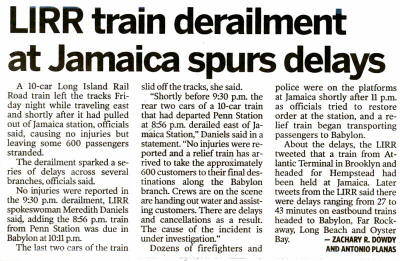
Reported to be a broken rail as of 11/23/2019.
Jamaica train derailment 11/23/2019 Source: Newsday |
June 17, 2021
Cold Spring Harbor - NY&A Freight and TC82 Geometry Car Collision |
|
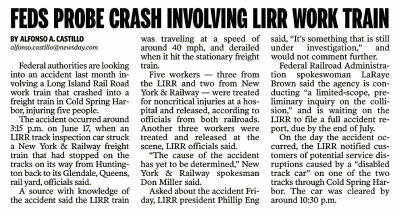 TC82
Geometry inspection car collision with rear of NY&A freight on
6/17/2021. Occurred on Track 1 westbound at Rogue's Path underpass,
Cold Spring Harbor. Source: Newsday 7/03/2021 TC82
Geometry inspection car collision with rear of NY&A freight on
6/17/2021. Occurred on Track 1 westbound at Rogue's Path underpass,
Cold Spring Harbor. Source: Newsday 7/03/2021
|
|
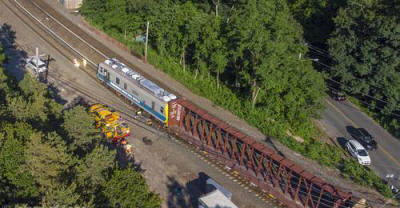
Rogues Path underpass, Cold Spring Harbor
collision on Track 1 - View E 6/17/2021
|
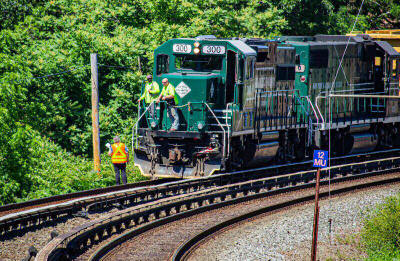 NY&A #300 RS40 freight returning from DUKE was rear ended at Cold
Spring Harbor by LIRR TC82 Geometry inspection car. Here, we see the
train crew at the head end discussing their next plan of action -
thankfully everyone was okay, and the scene was cleaned up around 7:30
in the evening. 6/17/2021
Photo/Archive: Joe Stroppel NY&A #300 RS40 freight returning from DUKE was rear ended at Cold
Spring Harbor by LIRR TC82 Geometry inspection car. Here, we see the
train crew at the head end discussing their next plan of action -
thankfully everyone was okay, and the scene was cleaned up around 7:30
in the evening. 6/17/2021
Photo/Archive: Joe Stroppel |
January 29, 2022
Farmingdale Village - Passenger Train Car Collision |
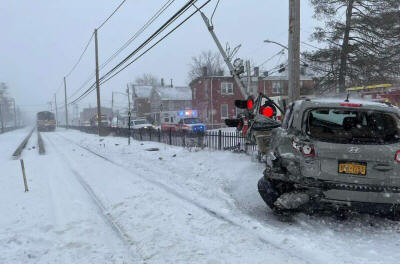 At 09:50AM, January 29, 2022, the Farmingdale Fire Department
responded to a passenger train vs. car on Melville Rd and S. Front St.
in Farmingdale. Two occupants of the auto got stuck on the tracks.
When the gates came down a bystander got them out of the vehicle
before it was struck by LIRR passenger train #8012. At 09:50AM, January 29, 2022, the Farmingdale Fire Department
responded to a passenger train vs. car on Melville Rd and S. Front St.
in Farmingdale. Two occupants of the auto got stuck on the tracks.
When the gates came down a bystander got them out of the vehicle
before it was struck by LIRR passenger train #8012. |
August 3, 2023
Jamaica - 13 Hurt Passenger Train Derailment |
  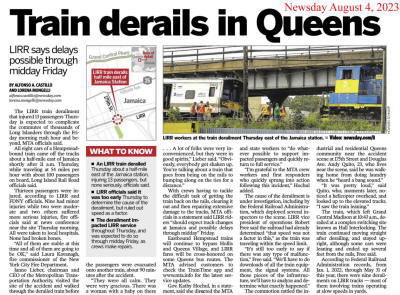
JAMAICA,
Queens (WABC) -- Crews are working to restore full service to the Long
Island Rail Road ahead of Friday's morning commute after more than a
dozen were people were injured when all eight cars of a train derailed
in Queens on Thursday morning. The FDNY said train 722 departed
Grand Central and was heading toward Hempstead when it derailed east
of Jamaica Station at 175th Street and 95th Avenue after
11 a.m.
There were 13 minor injuries. Nine of those injuries were minor, two
were considered moderate and two were considered more serious. Photo:
MTAPhoto: nycsubwayfromabove.com |
September 7, 2023
Jamaica - MOW 2 Car Derailment |
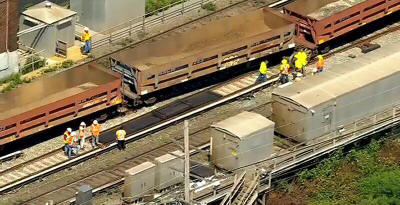 QUEENS
VILLAGE, New York (WABC) -- LIRR crews completed the re-railing of two
cars that had derailed on a work train Thursday, September 7, 2023
11:20PM. QUEENS
VILLAGE, New York (WABC) -- LIRR crews completed the re-railing of two
cars that had derailed on a work train Thursday, September 7, 2023
11:20PM.
The derailment caused major delays and cancellations during the
afternoon commute as only two of the four tracks were available.
The train derailed between Queens Village and the Elmont-UBS Arena
stations. The 16-car train was coming out of a yard when it derailed
just after 10 a.m. Seven percent of normal LIRR eastbound
service (11 of the 159 trains) was canceled Thursday afternoon and the
eastbound service that was operating ran with 15 to 20 minute delays.
Westbound service was significantly curtailed also. There was hourly
service only (one train an hour) on the Ronkonkoma, Port Jefferson,
Hempstead and Oyster Bay branches. The repairs were completed
around 8 p.m. and regular off-peak service resumed and continued
through the night. Customers were told to expect a full schedule
Friday morning, however some trains may experience delays due to
ongoing repair work. No passengers were on board and no injuries
were reported. WABC
The MOW derailment of empty dump gondolas, an ex-MNCR and LIRR,
occurred at Queens Interlocking, Hillside on the crossover from MT1 to
MT2. Taylor Alan Peterson |
July 30, 2024
Manorville - Ronkonkoma-Greenport "Scoot" Grade Crossing
Collision with Taxi |
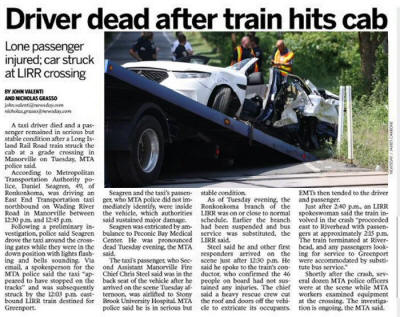 Newsday
- Driver dead after train hits cab 7/31/2024 Newsday
- Driver dead after train hits cab 7/31/2024
The Suffolk Times - Cab driver killed, passenger in serious
condition after Tuesday LIRR train collision in Manorville
7/31/2024 By Melissa Azofeifa
A taxi driver died and a passenger in serious but stable condition
after a Long Island Rail Road train collided with an East End
Transportation Cab in Manorville Tuesday afternoon (7/30/2024),
Metropolitan Transportation Authority police said. The deceased
was identified as Daniel Seagren, 49, of Ronkonkoma who was pronounced
dead after being transported to Riverhead’s Peconic Bay Medical
Center, according to MTA Police.
At approximately 12:45 p.m., the 12:03 eastbound train from Ronkonkoma
to Greenport struck the cab which was driving northbound on Wading
River Road in Manorville. The collision happened on the tracks at the
Wading River Road crossing, east of the Yaphank station. “Preliminary
investigation reveals the taxi with two occupants drove around
crossing gates in the down position with lights flashing,” the MTA
police reported. Further investigation “indicated the vehicle traveled
through the lowered crossing gate, which bent upon impact, passing
over the the top of the car without breaking,” according to an update
of the police account.
MTA Police did not immediately identify the passenger who was
airlifted to Stony Brook University Hospital and is listed in “serious
but stable condition,” an MTA police department spokesperson said in
an emailed statement.
There were roughly 50 passengers on the train, none of whom were
injured, according to an MTA spokesperson. After the collision,
the train proceeded east to Riverhead with passengers arriving at
approximately 2:15 pm. Those seeking service to Greenport were
“accommodated by substitute bus service,” the MTA police department
spokesperson said.
As of Wednesday morning, the Ronkonkoma Branch of the LIRR was
operating on or close to schedule |
|
|
December 21, 2024
Central Islip - Car strikes train at Lowell Avenue Crossing |
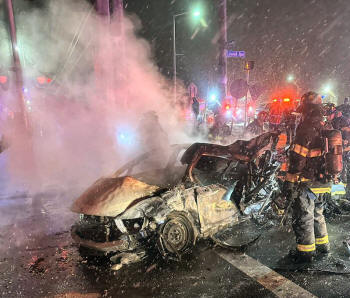 The
Suburban Fire Marshall - Car strikes train at Lowell Avenue
crossing The
Suburban Fire Marshall - Car strikes train at Lowell Avenue
crossing
December 21, 2024, 0423 hours. The Central Islip Fire Department
responds to a report of a car vs. train on Lowell Avenue, just south
of Suffolk Avenue. Units arrive to find that a passenger vehicle
went past the gates and was struck by a westbound train. The
vehicle was on the north side of the tracks and caught fire. The
occupants fled from the scene. Two were located, one of which
was the driver. He was arrested by MTA police.
Firefighters extinguished the fire and Central Islip-Hauppauge
Ambulance personnel treated one person that was on the train and a
number of the vehicles occupants when they were located. One
firefighter was transported to the hospital with an ankle injury.
Officials say the train hit Jonathan Hernandez-Lima’s vehicle around
4:30 a.m. The 27-year-old was then arrested and hospitalized.
The charges against Hernandez-Lima include DWI, reckless endangerment,
criminal mischief, leaving the scene with injury and leaving the scene
of property damage. All FD units cleared from the scene just
after 0500 hours. |
|
|
May 2, 2025
Central Islip - MOW train fire in Malverne |
|
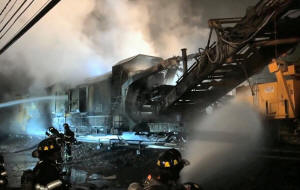 MOW
train fire east of the Westwood Station in Malverne 5052025 MOW
train fire east of the Westwood Station in Malverne 5052025
Witness video shows massive
flames bursting through the train cars as firefighters rushed through
a person's backyard on Ackley Avenue to get to the scene.
"It's a little more difficult than a regular house fire because we
have to worry about the utilities, the third rail, the equipment that
we're not very familiar with," Malverne First Deputy Fire Chief Ernest
Bohringer said.
|
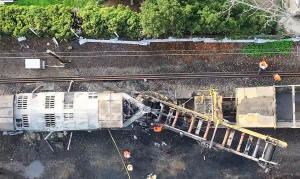
Service was restored on the West Hempstead Long Island Rail Road
branch following a train fire early Friday. Trains were stalled in
both directions between West Hempstead and Valley Stream for hours
when a fire broke out on a work train less than half a mile east of
the Westwood train station in Malverne. MTA |
|
|
|
|

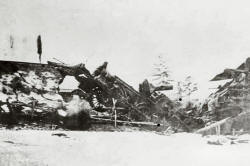
-12211880_WilliamJRugen-Queens-Public-Library_ChrisKlug_small.jpg) On
December 21, 1880, the locomotive Springfield, while clearing huge snow
drifts off the main line near Waverly, ran into the rear of a snowbound
passenger train. The incredible result, recorded by the camera of C. W.
Conklin of Jamaica, is shown above. Referred to as the "Great Snow Blockade"
in contemporary accounts, this was one of the most amazing train wrecks of
all time. Waverly has long been renamed Holtsville, but its long forgotten
claim to immortality should rekindle pride in the little community. The
Long Island Rail Road car #143 sits atop the locomotive "Springfield" doing
snowplow duty near Waverly (now Holtsville) when it ran into the rear of a
snowbound passenger train. The plow wedge at the front of the engine simply
picked up the last car of the passenger train. Info: "Steel Rails to
the Sunrise" Photo: C. W. Conklin Archive: William J.
Rugen collection, Queens Public Library Digital Archive
On
December 21, 1880, the locomotive Springfield, while clearing huge snow
drifts off the main line near Waverly, ran into the rear of a snowbound
passenger train. The incredible result, recorded by the camera of C. W.
Conklin of Jamaica, is shown above. Referred to as the "Great Snow Blockade"
in contemporary accounts, this was one of the most amazing train wrecks of
all time. Waverly has long been renamed Holtsville, but its long forgotten
claim to immortality should rekindle pride in the little community. The
Long Island Rail Road car #143 sits atop the locomotive "Springfield" doing
snowplow duty near Waverly (now Holtsville) when it ran into the rear of a
snowbound passenger train. The plow wedge at the front of the engine simply
picked up the last car of the passenger train. Info: "Steel Rails to
the Sunrise" Photo: C. W. Conklin Archive: William J.
Rugen collection, Queens Public Library Digital Archive


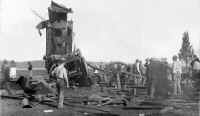
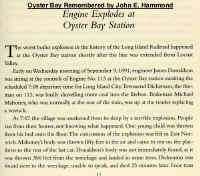
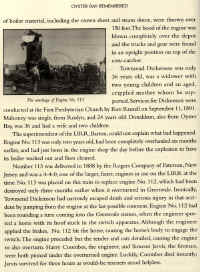

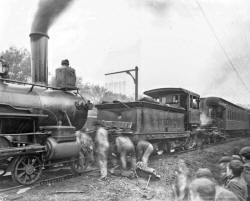 Locomotive
#78 at the left suffered the most damage. The pilot beam with cow-catcher
appears to have been torn off the locomotive and parts are setting on the
ground behind the blurry men working. Of course, the collision may have
caused the tender that got slammed to leak. No signs of water, however.
Locomotive
#78 at the left suffered the most damage. The pilot beam with cow-catcher
appears to have been torn off the locomotive and parts are setting on the
ground behind the blurry men working. Of course, the collision may have
caused the tender that got slammed to leak. No signs of water, however.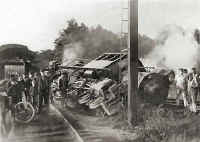 4-4-0 Class Camelbacks D53a
built 1889. No data on this wreck available at this time.
4-4-0 Class Camelbacks D53a
built 1889. No data on this wreck available at this time.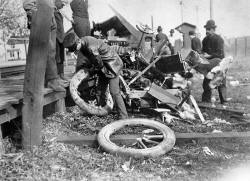 This
incident is considered the first accident between an automobile and a train
in the United States. The accident occurred on October 30, 1910 at the Long
Island Railroad crossing on Post Avenue in Westbury. The driver was Henri
Fournier, a successful French race driver, and later a car dealer for
Hotchkiss and Itala. The four passengers in the automobile with Fournier
were: H. B. Fullerton, a special PR agent for the Long Island Railroad, A.G.
Batchelder, J.H. Gerrie, a New York Herald reporter, and Arthur Lewis.
Fournier and all the passengers survived the accident. The auto was a yellow
10-HP Mors touring automobile.
This
incident is considered the first accident between an automobile and a train
in the United States. The accident occurred on October 30, 1910 at the Long
Island Railroad crossing on Post Avenue in Westbury. The driver was Henri
Fournier, a successful French race driver, and later a car dealer for
Hotchkiss and Itala. The four passengers in the automobile with Fournier
were: H. B. Fullerton, a special PR agent for the Long Island Railroad, A.G.
Batchelder, J.H. Gerrie, a New York Herald reporter, and Arthur Lewis.
Fournier and all the passengers survived the accident. The auto was a yellow
10-HP Mors touring automobile. Fournier's
Locomobile Smashed NY Times 10/31/1901
Fournier's
Locomobile Smashed NY Times 10/31/1901 The
noon train was wrecked when the locomotive jumped the switch at the Sound
Ave. crossing in Mattituck in 1904. The train turned over at the site of
Henry P. Tuthill's buildings killing the engineer and the fireman. Photo is
from the 75th anniversary issue of the Long Island Traveler -- Mattituck
Watchman newspaper published on Sept. 19, 1946. Carolyn Gillespie
Markowitz
The
noon train was wrecked when the locomotive jumped the switch at the Sound
Ave. crossing in Mattituck in 1904. The train turned over at the site of
Henry P. Tuthill's buildings killing the engineer and the fireman. Photo is
from the 75th anniversary issue of the Long Island Traveler -- Mattituck
Watchman newspaper published on Sept. 19, 1946. Carolyn Gillespie
Markowitz Greenlawn
wreck 4/08/1906 Archive: Carol Mills-Dave Morrison
Greenlawn
wreck 4/08/1906 Archive: Carol Mills-Dave Morrison Turnout
derailment - Archive: Patchogue Library
Turnout
derailment - Archive: Patchogue Library "A
Long Island Railroad train of empty passenger coaches ran yesterday
afternoon into a freight train a little west of Bay Shore. The rolling stock
was badly damaged, but no one was hurt. ... The passenger train was
westbound and was made up of empty coaches on their way to Long Island City
in preparation for the Sunday rush to the country. The freight train was
switching on a grade crossing, and the passenger train, traveling at great
speed, struck it squarely in the middle."
"A
Long Island Railroad train of empty passenger coaches ran yesterday
afternoon into a freight train a little west of Bay Shore. The rolling stock
was badly damaged, but no one was hurt. ... The passenger train was
westbound and was made up of empty coaches on their way to Long Island City
in preparation for the Sunday rush to the country. The freight train was
switching on a grade crossing, and the passenger train, traveling at great
speed, struck it squarely in the middle."  MU
after being pulled out of the building, displaying the crushed end.
Archive: Dave Keller
MU
after being pulled out of the building, displaying the crushed end.
Archive: Dave Keller
 Uncoupled train did not stop at station, crossed Fulton Avenue and
crashed into
O. L. Schwenke Land & Investment Co. Building. Police Officer
and spectators on scene.
Archive: Dave Keller
Uncoupled train did not stop at station, crossed Fulton Avenue and
crashed into
O. L. Schwenke Land & Investment Co. Building. Police Officer
and spectators on scene.
Archive: Dave Keller


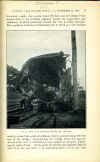
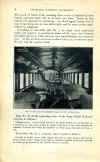
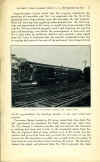

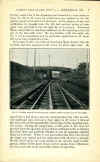
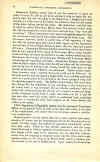



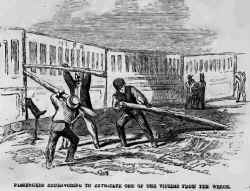
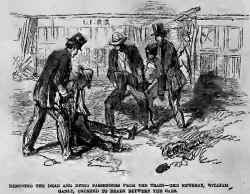

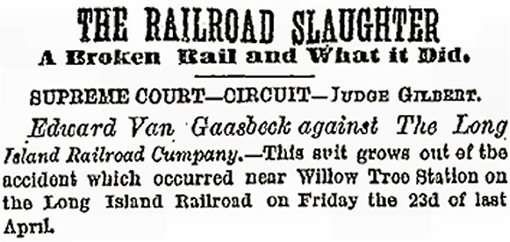 THE
BROOKLYN DAILY EAGLE:
THE
BROOKLYN DAILY EAGLE:
 Vincent
Seyfried wrote
Vincent
Seyfried wrote

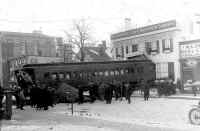
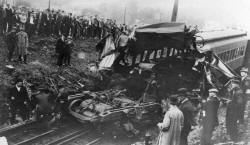

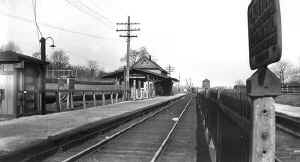












































































_small.jpg)
 Five
coaches from eastbound Passenger Train #8 derailed 150' east of Cherry
Ave., Sayville. Twenty-seven injured, three seriously, with no
fatalities. Wednesday morning, 10:50am. 3/17/1943 as reported by the
Suffolk County News.
Five
coaches from eastbound Passenger Train #8 derailed 150' east of Cherry
Ave., Sayville. Twenty-seven injured, three seriously, with no
fatalities. Wednesday morning, 10:50am. 3/17/1943 as reported by the
Suffolk County News. 




























 Feb
17 1950 Both Engineers survived. 32 passengers died. LIRR trains #192
and #175 Archive: Art Huneke
Feb
17 1950 Both Engineers survived. 32 passengers died. LIRR trains #192
and #175 Archive: Art Huneke
 Newsday front page: 02/18/1950
Newsday front page: 02/18/1950




 "The
People's Almanac" (Wallachinsky and Wallace, 1975, p. 564) gives
the following very detailed description of what happened:
"The
People's Almanac" (Wallachinsky and Wallace, 1975, p. 564) gives
the following very detailed description of what happened: Close
behind on the same mainline track, Train 174 with 12 cars and 1,200
passengers thundered toward Jamaica. Motorman Benjamin J. Pokorny
obeyed the signal at "C" tower and brought his train to a
halt. When the signal changed, he accelerated to 15 mph. In back of
him the "C" tower signal changed again back to
"restricted," but ahead the signal on "J" tower
flashed "approach." Train 174 resumed full speed. Too late
Pokorny saw the stopped train ahead. In his last seconds of life he
pulled the brake cord . . .
Close
behind on the same mainline track, Train 174 with 12 cars and 1,200
passengers thundered toward Jamaica. Motorman Benjamin J. Pokorny
obeyed the signal at "C" tower and brought his train to a
halt. When the signal changed, he accelerated to 15 mph. In back of
him the "C" tower signal changed again back to
"restricted," but ahead the signal on "J" tower
flashed "approach." Train 174 resumed full speed. Too late
Pokorny saw the stopped train ahead. In his last seconds of life he
pulled the brake cord . . .
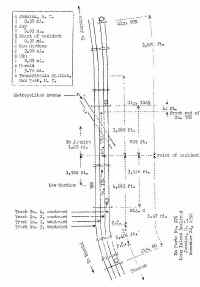


 LIRR
wreck Old Country Rd. and Railroad Lane., Hicksville 1954 Archive:
Steve Chernow
LIRR
wreck Old Country Rd. and Railroad Lane., Hicksville 1954 Archive:
Steve Chernow




















 The next-to-last car of an LIRR trains lays on its side at Old Stump Road in Brookhaven after it derailed on Dec. 3, 1963. The last car can be seen in the background, completely on its side. Photo Credit: Newsday/Max Heine
The next-to-last car of an LIRR trains lays on its side at Old Stump Road in Brookhaven after it derailed on Dec. 3, 1963. The last car can be seen in the background, completely on its side. Photo Credit: Newsday/Max Heine



















 Eventually we were allowed
off the train. The Special
Service Attendant staffing the coach bar continued to sell his
beverages, and I suspect the parlor car attendants did likewise.
There was money to be made from a thirsty captive audience! We waited for some time, probably between one and two hours,
for busses to rescue us and take us east along Route 25 to the
stations from Riverhead to Greenport. I think our train was due at Cutchogue a few minutes before 7
PM, but I suspect I eventually got to Cutchogue between 9 and 10 PM.
I had survived my first train accident and derailment with no
injuries and an interesting story to tell.
Eventually we were allowed
off the train. The Special
Service Attendant staffing the coach bar continued to sell his
beverages, and I suspect the parlor car attendants did likewise.
There was money to be made from a thirsty captive audience! We waited for some time, probably between one and two hours,
for busses to rescue us and take us east along Route 25 to the
stations from Riverhead to Greenport. I think our train was due at Cutchogue a few minutes before 7
PM, but I suspect I eventually got to Cutchogue between 9 and 10 PM.
I had survived my first train accident and derailment with no
injuries and an interesting story to tell.




 The
LIRR's wreck train and crew, under Wreckmaster Jimmy Van Time, worked
through Sunday night, January 24 and Monday morning to rerail a seven
car train after it was derailed by an open switch.
The
LIRR's wreck train and crew, under Wreckmaster Jimmy Van Time, worked
through Sunday night, January 24 and Monday morning to rerail a seven
car train after it was derailed by an open switch.




















 Here, an aerial view of a derailed westbound LIRR train after it struck a flatbed trailer at the Park Avenue crossing in Huntington on Aug. 26, 1988. The derailment, which left 18 people injured, caused an estimated $2.5 million in damage to cars, engines, track, signals and a lumberyard adjacent to the tracks where one of the cars came to rest. Photo Credit: Newsday/
Cliff DeBear
Here, an aerial view of a derailed westbound LIRR train after it struck a flatbed trailer at the Park Avenue crossing in Huntington on Aug. 26, 1988. The derailment, which left 18 people injured, caused an estimated $2.5 million in damage to cars, engines, track, signals and a lumberyard adjacent to the tracks where one of the cars came to rest. Photo Credit: Newsday/
Cliff DeBear








 Per
Newsweek "A Long Island Rail Road train on May 11, 1992, rammed a
truck stuck on the tracks in at the Bellport Station in East Patchogue
with a load of 21 tons of concrete drainage vaults, injuring 16 people
and delaying 1,800 commuters."
Per
Newsweek "A Long Island Rail Road train on May 11, 1992, rammed a
truck stuck on the tracks in at the Bellport Station in East Patchogue
with a load of 21 tons of concrete drainage vaults, injuring 16 people
and delaying 1,800 commuters."















 On Nov. 8, 1996, a westbound LIRR train derailed near the Great Neck station. The incident was deemed weather-related. Photo Credit: Newsday / Audrey C. Tiernan
On Nov. 8, 1996, a westbound LIRR train derailed near the Great Neck station. The incident was deemed weather-related. Photo Credit: Newsday / Audrey C. Tiernan





 The
Glen Street incident appears to have resulted in lowboy crossing signs
installed warning of this hazard.
The
Glen Street incident appears to have resulted in lowboy crossing signs
installed warning of this hazard.  On Jan. 24, 2001, an LIRR train with about 110 people aboard derailed just east of the Stony Hollow Road overpass in Greenlawn. Here, firefighters help passengers get off of the train. Photo Credit: Newsday / John Paraskevas
On Jan. 24, 2001, an LIRR train with about 110 people aboard derailed just east of the Stony Hollow Road overpass in Greenlawn. Here, firefighters help passengers get off of the train. Photo Credit: Newsday / John Paraskevas

 On Aug. 13, 2001, an LIRR passenger train derailed just east of South Woods Road near the Syosset station. Photo Credit: Newsday/Michael E. Ach
On Aug. 13, 2001, an LIRR passenger train derailed just east of South Woods Road near the Syosset station. Photo Credit: Newsday/Michael E. Ach


 On April 12, 2004, workers and investigators at the scene after an LIRR train derailed near the Long Island City Passenger Yard in Queens. Photo Credit: Jason DeCrow
On April 12, 2004, workers and investigators at the scene after an LIRR train derailed near the Long Island City Passenger Yard in Queens. Photo Credit: Jason DeCrow
 On July 6, 2006, an empty LIRR car derailed outside a tunnel leading to Penn Station. The car, with no passengers, came off the tracks around 2:30 a.m. and caused delays of up to 30 minutes on parts of the LIRR system. Photo Credit: AP/Aaron Jackson
On July 6, 2006, an empty LIRR car derailed outside a tunnel leading to Penn Station. The car, with no passengers, came off the tracks around 2:30 a.m. and caused delays of up to 30 minutes on parts of the LIRR system. Photo Credit: AP/Aaron Jackson

















 Eastbound
from Penn, NY crash with auto west of Carlton Ave., Central
Islip 11/06/2016
Eastbound
from Penn, NY crash with auto west of Carlton Ave., Central
Islip 11/06/2016
 On Jan. 4, 2017, more than 100 people were injured when a Brooklyn-bound LIRR train crashed through a bumping block at the end of the tracks at Atlantic Terminal.
On Jan. 4, 2017, more than 100 people were injured when a Brooklyn-bound LIRR train crashed through a bumping block at the end of the tracks at Atlantic Terminal. 





















